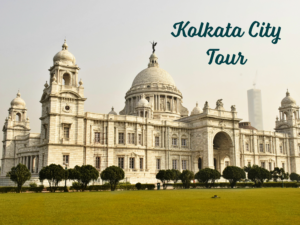
100 Best Places to See Kolkata – Complete Guide to Kolkata Tour Places
Kolkata (Calcutta), the “City of Joy,” is a vibrant mix of colonial history, cultural richness, spirituality, and modern attractions. From iconic landmarks to offbeat gems, here’s the ultimate list of places of interest in Kolkata you must explore.
1. Victoria Memorial
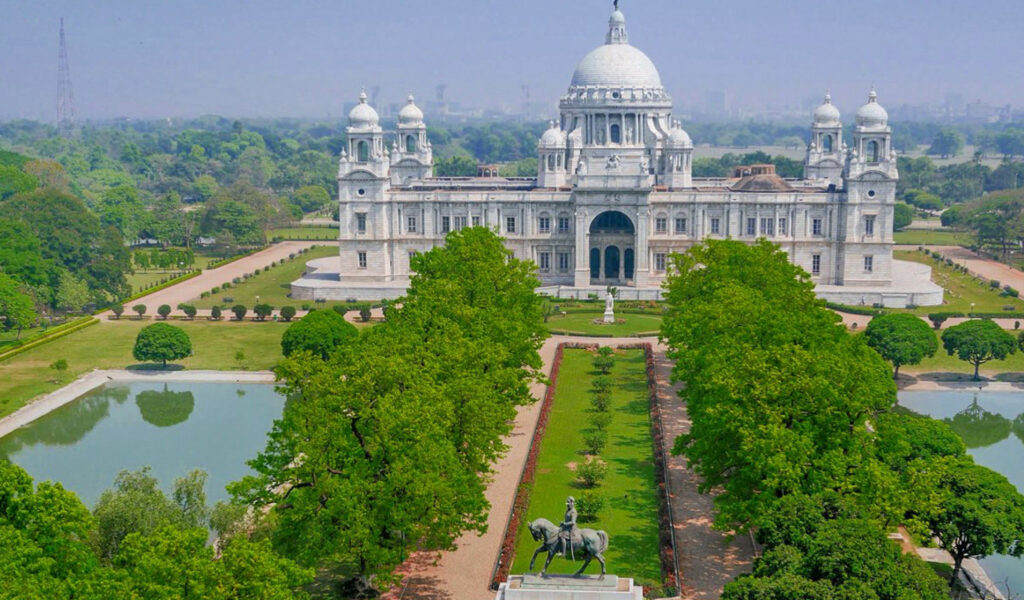
If there is one monument that encapsulates the grandeur of Kolkata, it is the Victoria Memorial. Constructed between 1906 and 1921, this stunning white marble masterpiece was built in memory of Queen Victoria. Designed by Sir William Emerson, the building harmoniously blends Indo-Saracenic, Mughal, and Venetian architectural styles, making it one of the most photogenic landmarks in the city. Crowned by the bronze Angel of Victory, the dome and towers dominate Kolkata’s skyline.
Spread across 64 acres of manicured gardens, the memorial is a haven for both tourists and locals. The sprawling lawns dotted with fountains and sculptures invite evening strolls, and the reflection of the monument on calm waters makes for postcard-perfect photography. Inside, the museum houses more than 25 galleries with treasures ranging from Mughal miniatures and colonial paintings to rare manuscripts, coins, and artifacts that chronicle both British rule and India’s independence movement. Highlights include the Calcutta Gallery, which captures the city’s transformation across centuries.
Evenings are magical here, with a sound-and-light show narrating Kolkata’s history. Many consider it one of the finest storytelling experiences in the city.
•⏰ Timings: Museum – 10:00 AM to 6:00 PM (Closed on Mondays & National Holidays); Gardens – 5:30 AM to 6:15 PM daily
•🎟️ Entry Fee: Museum – ₹30 (Indians), ₹500 (Foreigners); Garden – ₹10
•💡 Travel Tip: Visit around 4 PM to explore the museum and then stay back for the illuminated view and evening show.
No list of places to see Kolkata is complete without the Victoria Memorial — it’s not just a monument, but the city’s crown jewel.
2. Howrah Bridge (Rabindra Setu)
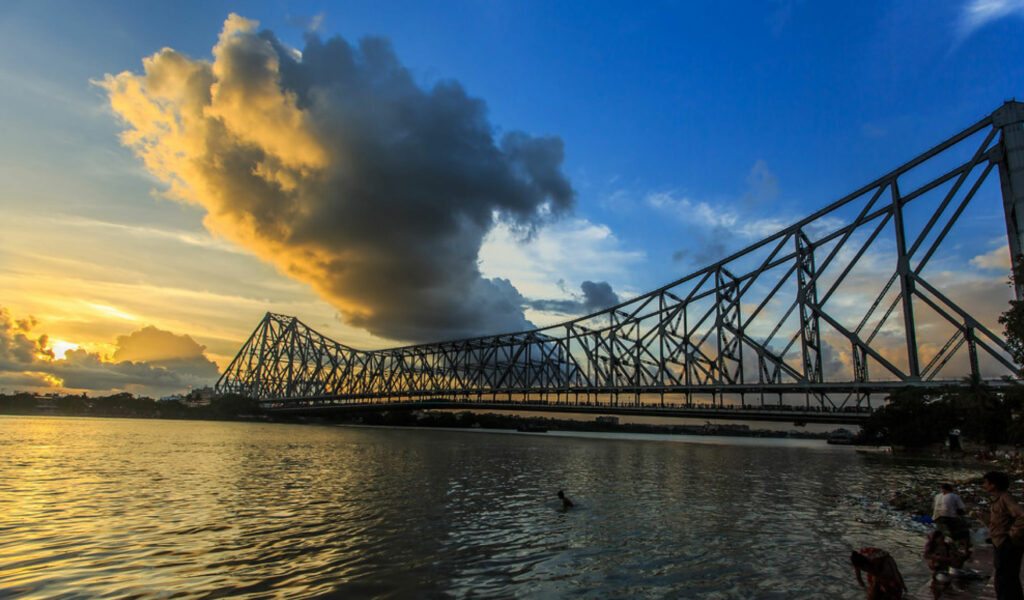
An engineering marvel and one of the most recognized tourist places of Calcutta, the Howrah Bridge is more than just a transport link — it is a cultural icon. Opened in 1943, this cantilever bridge spans 705 meters across the Hooghly River, connecting Kolkata with its twin city, Howrah. With nearly 100,000 vehicles and countless pedestrians crossing it daily, the bridge is a lifeline for the city.
The sheer scale and design make it a marvel of pre-independence engineering — constructed without nuts or bolts, it remains one of the world’s busiest cantilever bridges. Beyond its functionality, it is deeply embedded in Kolkata’s identity, often seen in films, postcards, and literature as the city’s enduring symbol.
For travelers, the bridge is best experienced from different perspectives. A morning walk to Mullick Ghat Flower Market beneath the bridge is unforgettable — the riot of colors from thousands of flower sellers set against the steel giant creates a magical atmosphere. Sunset ferry rides on the Hooghly also provide breathtaking views of the bridge glowing in twilight.
•⏰ Timings: Always open
•🎟️ Entry Fee: Free
•💡 Travel Tip: For stunning photos, visit early morning at Mullick Ghat or take an evening ferry ride for reflections on the river.
The Howrah Bridge is not merely a passage; it’s the soul of Kolkata in motion.
3. Vidyasagar Setu (Second Hooghly Bridge)
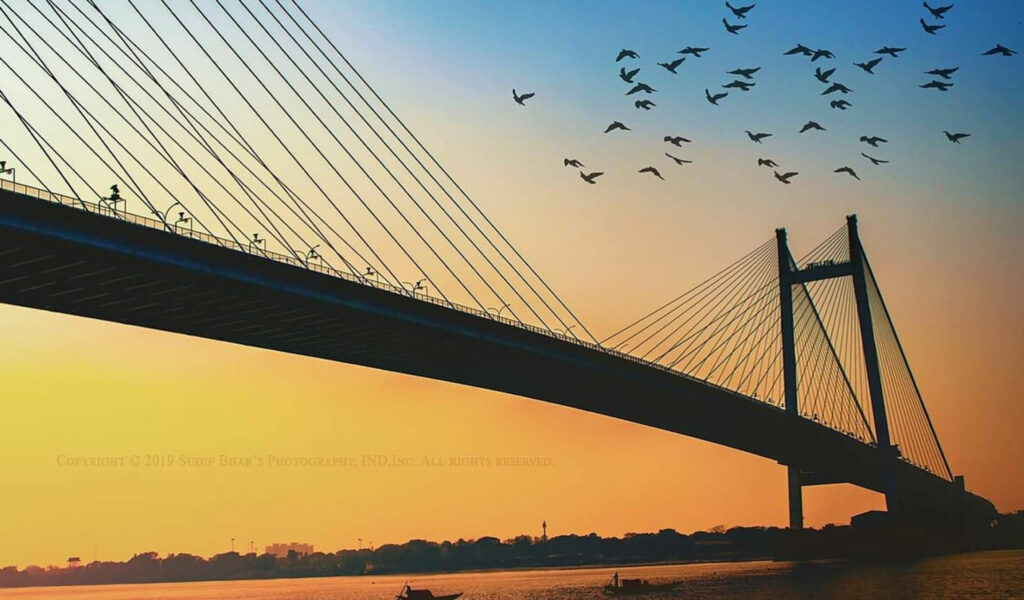
While the Howrah Bridge reflects colonial-era engineering, the Vidyasagar Setu showcases modern Kolkata. Inaugurated in 1992, this cable-stayed bridge stretches over 820 meters, making it India’s longest. Named after reformer Ishwar Chandra Vidyasagar, the bridge symbolizes progress and blends functionality with elegance.
By day, the bridge is busy with traffic, connecting Kolkata to Howrah, but it’s by night that its beauty shines. Illuminated with glowing lights, the sweeping cables and tall pylons reflect dramatically on the waters below. For locals, it’s a favorite spot for romantic walks, photography, and riverside relaxation. The best place to enjoy its grandeur is from Prinsep Ghat, where the wide steps and riverside promenade provide a tranquil setting.
Tourists often combine a visit with boat rides that pass beneath the bridge, offering a magical perspective as the city lights shimmer in the river.
•⏰ Timings: Always open
•🎟️ Entry Fee: Free
•💡 Travel Tip: Visit Prinsep Ghat in the evening for the best views and combine with a riverside boat ride for a memorable experience.
A symbol of modern engineering, Vidyasagar Setu is one of the newer yet equally captivating places of interest in Kolkata.
4. Fort William
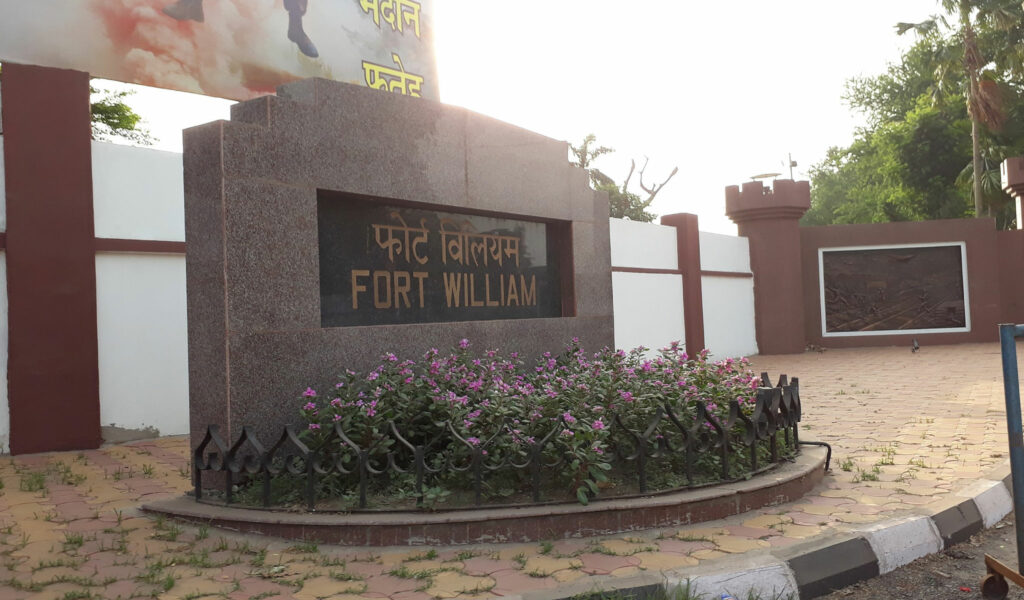
Constructed in 1696 and expanded in the 18th century, Fort William stands as a reminder of Kolkata’s colonial importance. Named after King William III, this star-shaped fort was central to British military strategy in India. With massive stone walls, wide battlements, and underground chambers, it was once notorious as a prison known as the “Black Hole of Calcutta.”
Today, Fort William functions as the headquarters of the Indian Army’s Eastern Command, so entry is restricted. However, the fort’s vast structure can still be admired from outside, especially while strolling through the Maidan, the expansive green field surrounding it. The contrast of its colonial architecture against the bustling city skyline is striking.
Visitors often enjoy walking around the Maidan, which also houses several statues, sports clubs, and monuments. Though you cannot enter freely, the fort remains an integral part of Kolkata’s heritage narrative.
•⏰ Timings: Restricted public entry (special permissions only)
•🎟️ Entry Fee: Free (view from outside)
•💡 Travel Tip: Visit during early morning or evening for a pleasant walk around the Maidan while admiring the fort’s structure.
For history enthusiasts, Fort William represents both the power and the struggles of colonial Calcutta.
5. Shaheed Minar (Ochterlony Monument)
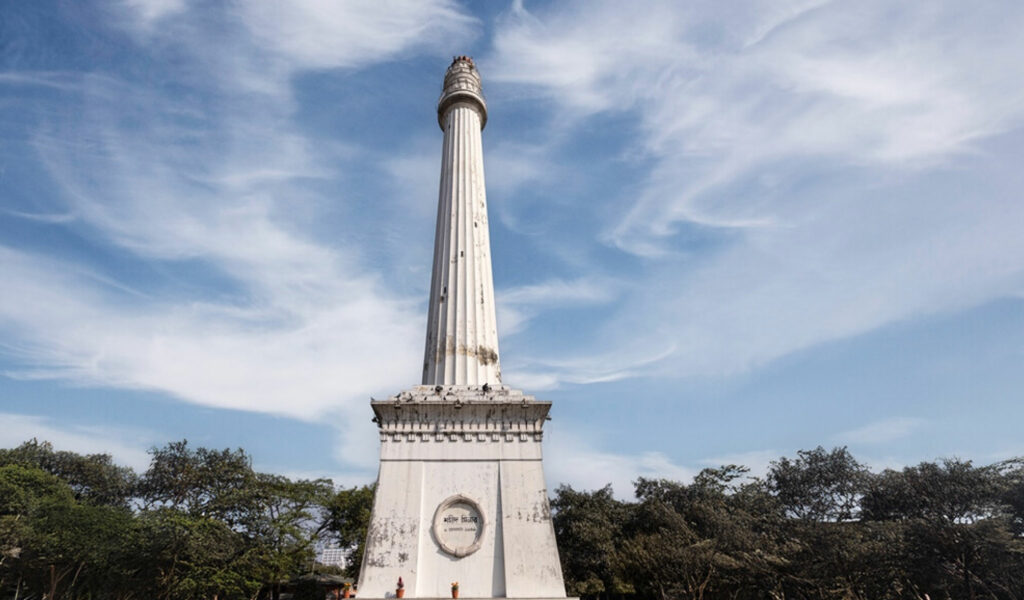
Rising 48 meters into the sky, the Shaheed Minar is one of Kolkata’s most striking landmarks. Built in 1828 to commemorate British general Sir David Ochterlony’s victories, it originally served as the Ochterlony Monument. In 1969, it was renamed “Shaheed Minar” to honor India’s martyrs, thus transforming its identity from colonial commemoration to a nationalist symbol.
Situated on the Maidan, near Esplanade, the monument is surrounded by lush lawns and bustling city life. With its Egyptian-style base, Syrian column, and Turkish dome, the architecture is an unusual fusion of styles rarely seen elsewhere. For years, the monument has been the backdrop for political rallies, public gatherings, and cultural events, giving it a central role in the city’s social fabric.
With special permission, visitors can climb its spiral staircase to the viewing gallery at the top, which offers panoramic views of Kolkata, from the Howrah Bridge to Victoria Memorial.
•⏰ Timings: 10:00 AM – 5:00 PM (access depends on permission)
•🎟️ Entry Fee: Free
•💡 Travel Tip: If you can climb, choose a clear day for unmatched 360° city views; otherwise, admire it from the Maidan during a leisurely walk.
The Shaheed Minar remains a timeless reminder of Kolkata’s layered history, blending colonial past and independent identity.
6. Raj Bhavan
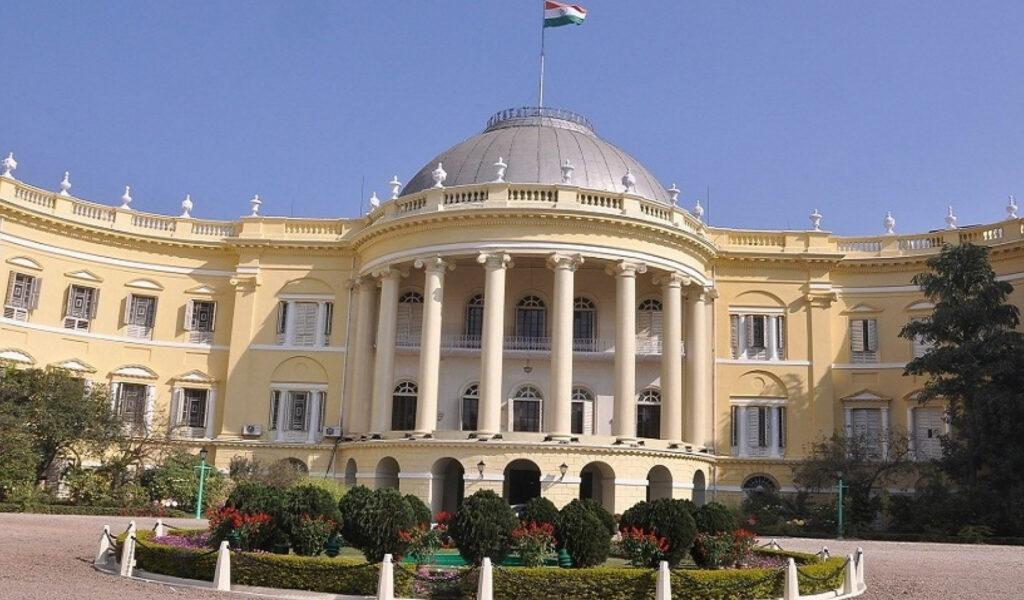
Built in 1803, the Raj Bhavan is one of the most important colonial landmarks in Kolkata. Known as the “Government House” during the British Raj, it served as the residence of the Viceroy of India until 1911, when the capital shifted to Delhi. Designed in neoclassical style and modeled after Kedleston Hall in Derbyshire, England, the mansion covers a sprawling 27 acres, making it one of the largest governor’s houses in India. Its grand façade, complete with massive pillars, domes, and ornamental gates, speaks volumes of British imperial ambition.
Today, Raj Bhavan is the official residence of the Governor of West Bengal. While entry inside is usually restricted, guided tours are sometimes organized with prior permission, allowing visitors to glimpse its regal interiors adorned with chandeliers, portraits, and antique furniture. Even without entering, the building is best admired from the outside while exploring the heritage-rich BBD Bagh area.
•⏰ Timings: Entry restricted; occasional guided tours with prior permission
•🎟️ Entry Fee: Free (view from outside)
•💡 Travel Tip: Combine your visit with a heritage walk around Dalhousie Square, where Raj Bhavan stands alongside other colonial-era marvels.
Raj Bhavan remains one of the most majestic places of interest in Kolkata, symbolizing both the grandeur and complexity of colonial rule.
7. Writers’ Building
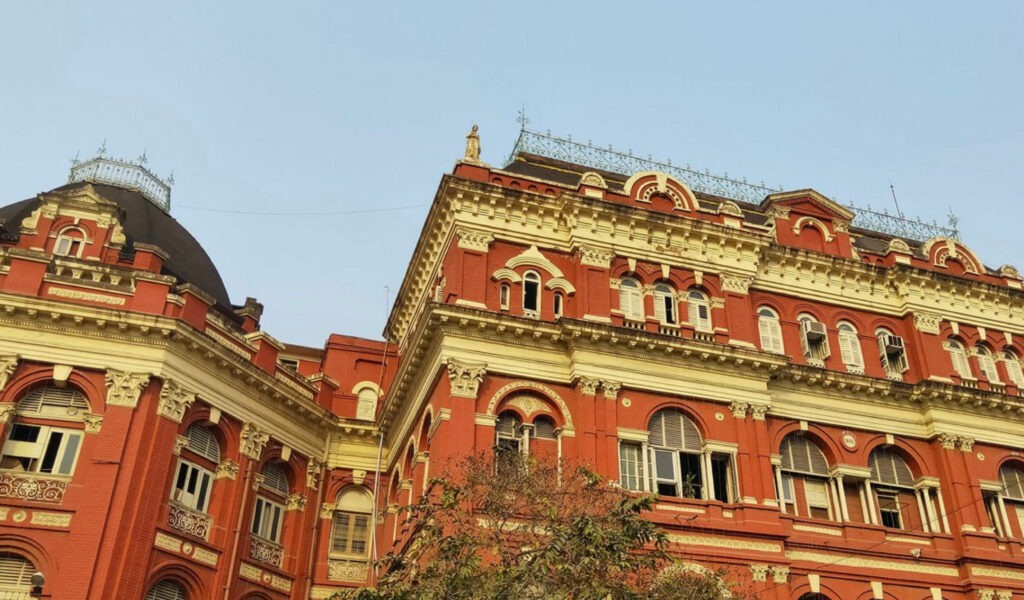
The imposing red façade of the Writers’ Building dominates the Dalhousie Square skyline. Built in 1777, it was originally intended to house clerks—or “writers”—of the East India Company, which explains its name. Over time, it expanded into a massive government complex and became the seat of the Bengal Secretariat. The structure has witnessed countless political decisions and historic events that shaped Bengal’s destiny.
Apart from its administrative importance, the Writers’ Building holds a special place in India’s freedom struggle. In 1930, revolutionaries Benoy, Badal, and Dinesh stormed the building to assassinate British officials, an act that etched it permanently in the annals of nationalist history.
Though currently under renovation, the building’s architecture remains a sight to behold — long colonnades, grand staircases, and statues adorning its façade make it an architectural treasure.
•⏰ Timings: Not open to public; under renovation
•🎟️ Entry Fee: Free (view from outside)
•💡 Travel Tip: Visit as part of a walking tour of Dalhousie Square, where you can also see the GPO, Town Hall, and Metcalfe Hall.
The Writers’ Building is not just a structure; it’s a living witness to Kolkata’s colonial past and nationalist struggles.
8. Town Hall
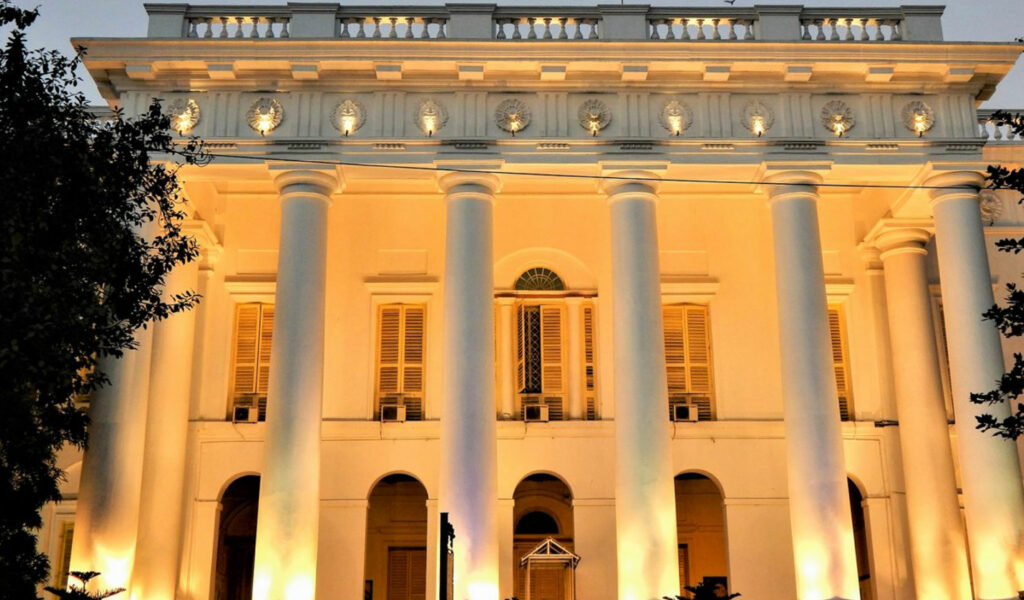
Constructed in 1813, the Town Hall of Kolkata is a splendid example of Roman-Doric architecture. Once the cultural and social hub of the British elite, it hosted grand balls, public meetings, and official ceremonies. Its marble floors, lofty ceilings, and impressive pillars evoke the opulence of a bygone era.
Today, the Town Hall functions as a museum and event space, showcasing Kolkata’s colonial history through photographs, paintings, and models. The “Kolkata Panorama” exhibition is a highlight, offering an immersive journey into the city’s past, from its founding under Job Charnock to its development into the cultural capital of India.
•⏰ Timings: 11:00 AM – 6:00 PM (Closed on Sundays)
•🎟️ Entry Fee: ₹10 – ₹20
•💡 Travel Tip: Perfect stop if you’re exploring the BBD Bagh heritage circuit. Plan an hour to enjoy the museum and soak in the architecture.
For those keen on understanding the cultural evolution of the city, the Town Hall is a must-visit tourist place of Calcutta.
9. Metcalfe Hall

Standing tall with its grand Corinthian columns, Metcalfe Hall is one of Kolkata’s most photogenic colonial buildings. Built in 1844, it was originally the home of the Calcutta Public Library, later merged into the National Library. Over the years, the hall has been used for government offices and exhibitions, but its architecture remains timeless.
Restored recently, the building now hosts exhibitions by the Asiatic Society, making it not just a heritage landmark but also a cultural hub once again. Its Greek-Roman style, resembling ancient temples, makes it a favorite for photographers and heritage enthusiasts alike.
•⏰ Timings: 10:00 AM – 5:00 PM (Closed on Sundays)
•🎟️ Entry Fee: Free
•💡 Travel Tip: Visit in the evening when the hall is lit up, or pair your visit with nearby GPO and Town Hall for a complete colonial trail.
For architecture lovers, Metcalfe Hall is one of the finest places to see Kolkata in its old-world glory.
10. General Post Office (GPO)
Built in 1868 on the site of the infamous “Black Hole of Calcutta,” the General Post Office (GPO) is one of the grandest post offices in India. Its massive white dome and towering Corinthian pillars dominate BBD Bagh, making it a landmark that’s impossible to miss.
Inside, the GPO still functions as a bustling postal hub, while a small postal museum displays rare stamps, artifacts, and historical letters, offering a glimpse into India’s communication history. The building itself is a testimony to the British attempt at blending utility with grandeur.
•⏰ Timings: 9:00 AM – 5:00 PM (Monday to Saturday)
•🎟️ Entry Fee: Free
•💡 Travel Tip: Step inside the GPO for a quick look at the museum. Photographers will love capturing its dome against the blue sky.
The GPO is more than just a working post office — it is a majestic reminder of the city’s colonial legacy and an underrated Kolkata tour place.
11. Lal Dighi (BBD Bagh Tank)
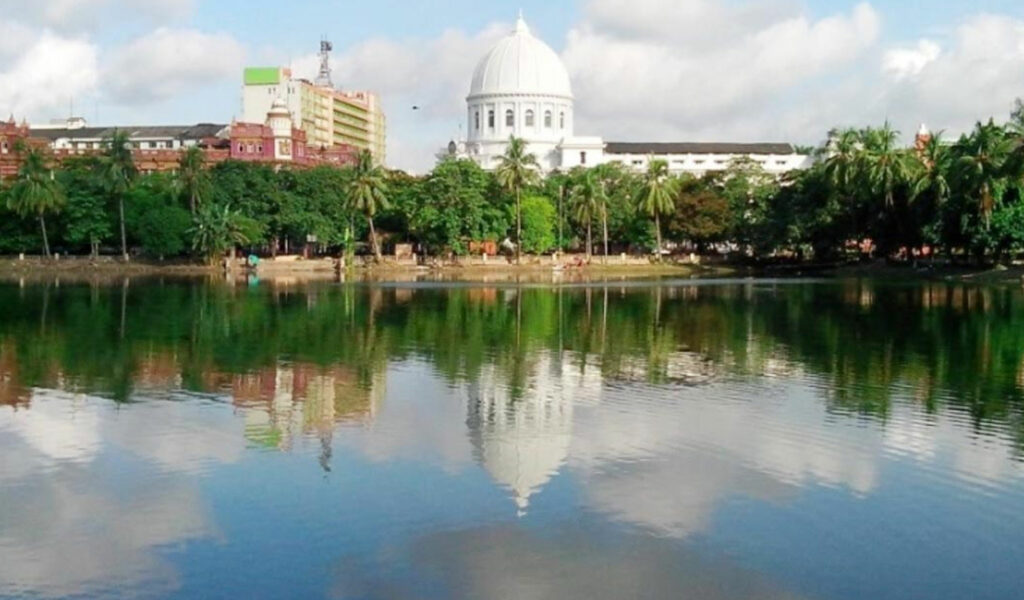
At the heart of Kolkata’s colonial district, Lal Dighi, also known as the “Red Tank,” is a large water body surrounded by some of the most iconic colonial buildings. The General Post Office, Writers’ Building, and Raj Bhavan all look onto this historic reservoir, making it a picturesque focal point of the city’s administrative heritage.
The origins of Lal Dighi trace back to the early days of Calcutta, when it was dug to provide water to British officials and soldiers. Over time, the tank became the centerpiece of Dalhousie Square (now BBD Bagh). Its serene waters beautifully reflect the surrounding buildings, offering photographers perfect compositions at dawn and dusk.
Though not a typical tourist attraction with activities, Lal Dighi remains an essential stop on any heritage walk. Standing by its banks, one can easily imagine the colonial past of Calcutta when the British East India Company transformed this swampy land into their seat of power.
•⏰ Timings: Open all day (public area)
•🎟️ Entry Fee: Free
•💡 Travel Tip: Best visited in the early morning or evening when the reflections of colonial buildings shimmer on the water’s surface.
For anyone exploring places of interest in Kolkata, Lal Dighi is a peaceful window into the city’s layered history.
12. Marble Palace
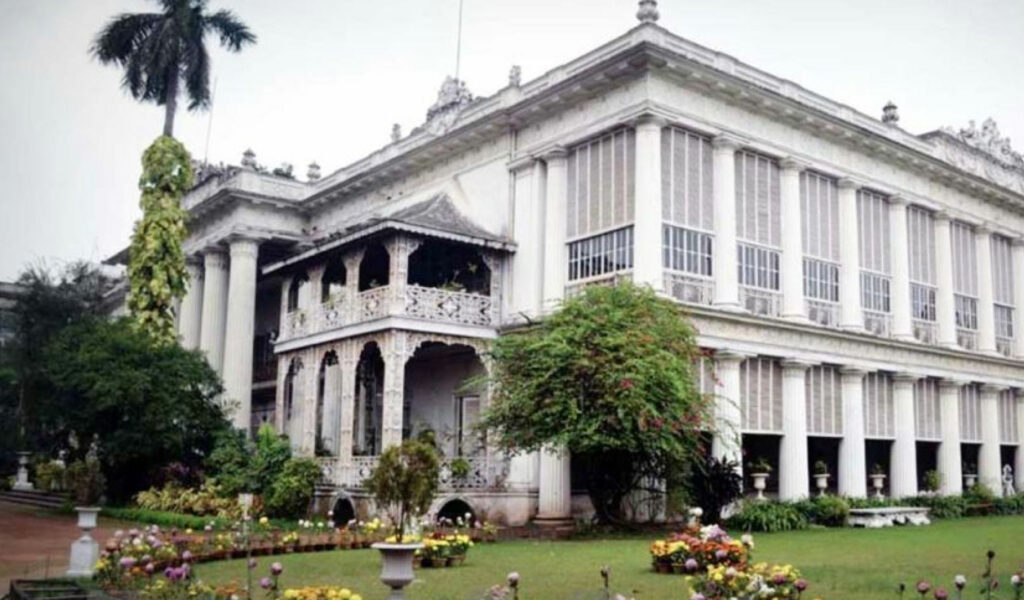
One of the most exquisite tourist places of Calcutta, the Marble Palace is a privately-owned 19th-century mansion built by Raja Rajendra Mullick in 1835. Its name comes from the extensive use of marble in its floors, walls, and pillars, which lend it unmatched elegance. Architecturally, the palace is a blend of neoclassical design with touches of traditional Bengali style.
Inside, it houses an eclectic collection of European paintings, sculptures, clocks, chandeliers, and antique furniture. Notable works by artists like Rubens and Reynolds add to its charm. The palace is also famous for its adjoining Marble Palace Zoo, which, though modest, is historically significant as India’s first private zoo.
Access requires prior permission from the West Bengal Tourism office, which makes visiting slightly challenging but rewarding. The palace remains one of the few places where Kolkata’s elite past can still be felt in its opulent halls.
•⏰ Timings: 10:00 AM – 4:00 PM (Closed on Mondays & Thursdays)
•🎟️ Entry Fee: Free (Permission required)
•💡 Travel Tip: Arrange your permit a few days in advance. Combine with a North Kolkata heritage walk to explore other mansions nearby.
The Marble Palace is a rare gem among places to see Kolkata, giving visitors a glimpse of aristocratic grandeur.
13. Tagore Castle (Pathuriaghata)
Resembling a medieval fortress, Tagore Castle in Pathuriaghata is unlike any other mansion in Kolkata. Built by the Pathuriaghata branch of the Tagore family in the 19th century, its turrets, battlements, and crenellations give it the look of a Scottish castle transplanted into Bengal.
Though not open to the public (it remains privately owned), the castle’s imposing exterior is worth a visit, especially for those exploring the heritage trails of North Kolkata. The castle reflects the wealth and influence of the Tagores, one of Bengal’s most powerful families. Standing in front of its façade transports you to a world where Kolkata’s elite experimented with eclectic architectural styles to showcase their status.
•⏰ Timings: View from outside only
•🎟️ Entry Fee: Free
•💡 Travel Tip: Best visited as part of a North Kolkata walking tour that also covers Marble Palace, Shobhabazar Rajbari, and Jorasanko.
Though often overlooked, Tagore Castle remains a fascinating landmark among the lesser-known places of interest in Kolkata.
14. Shobhabazar Rajbari
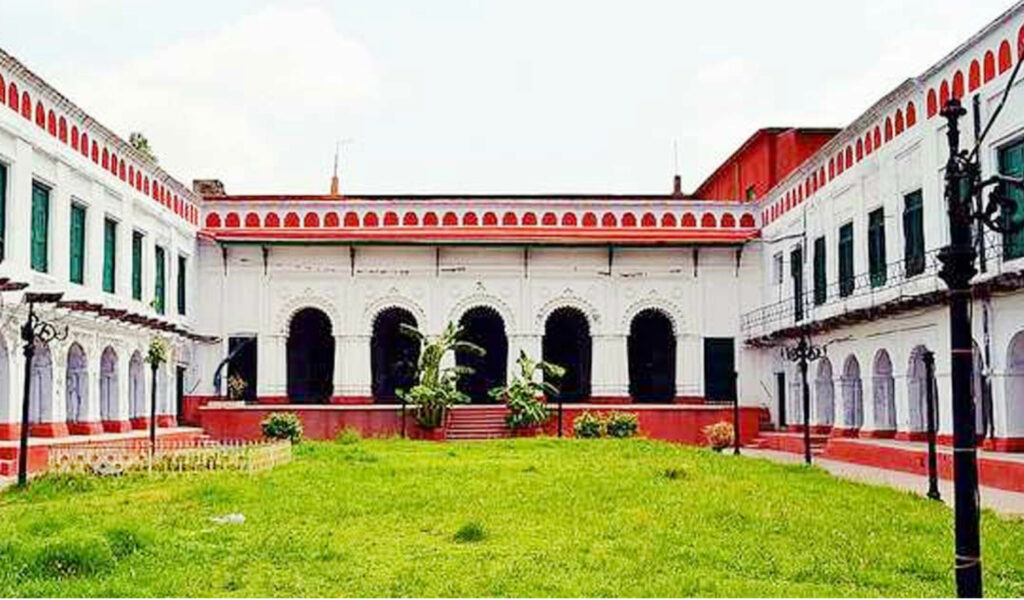
The Shobhabazar Rajbari, built in the mid-18th century by Raja Nabakrishna Deb, is one of Kolkata’s most historic mansions. It is especially famous for hosting grand Durga Puja celebrations that continue to this day. In colonial times, the Rajbari was also a hub of social and political gatherings, attended by figures such as Warren Hastings and Lord Clive.
The mansion is a fine example of Bengal’s aristocratic architecture, with massive courtyards, arched verandahs, and ornate decorations. While much of its grandeur has weathered over time, the Rajbari continues to resonate with cultural and historical significance. Visiting during Durga Puja is a particularly special experience, as the palace comes alive with rituals, lights, and crowds of devotees.
•⏰ Timings: Limited access; open during Durga Puja
•🎟️ Entry Fee: Free
•💡 Travel Tip: If you can, visit during Puja to witness its unique cultural vibrancy. For architecture enthusiasts, it’s best included in a heritage walk of North Kolkata.
Shobhabazar Rajbari is more than just a mansion — it’s a living museum of Bengal’s aristocratic culture.
15. Jorasanko Rajbari
The Jorasanko Rajbari, located in North Kolkata, is forever tied to Bengal’s literary heritage as the ancestral home of the Tagore family. It was here that Rabindranath Tagore, India’s Nobel laureate poet, was born in 1861, composed many of his works, and passed away in 1941.
Today, the Rajbari is part of Rabindra Bharati University and functions as a museum dedicated to the life and works of the Tagores. Its galleries display manuscripts, paintings, photographs, personal belongings, and furniture that bring alive the world of one of India’s greatest cultural icons. The mansion itself, with its courtyards and colonial-Bengali architecture, adds to the sense of nostalgia.
Visitors can explore exhibitions on Bengal’s Renaissance, the Tagore family’s contributions to literature, art, and nationalism, and Rabindranath’s global influence. Special cultural programs are often hosted here, making it a vibrant cultural hub even today.
•⏰ Timings: 10:30 AM – 4:30 PM (Closed Mondays)
•🎟️ Entry Fee: ₹20 (Indians), ₹30 (Foreigners)
•💡 Travel Tip: Literature lovers should plan at least 2 hours to explore fully. Early mornings are best for a quieter experience.
Jorasanko Rajbari is a must-visit place of interest in Kolkata, offering not just architecture but also the soul of Bengal’s cultural awakening.
16. Dakshineswar Kali Temple
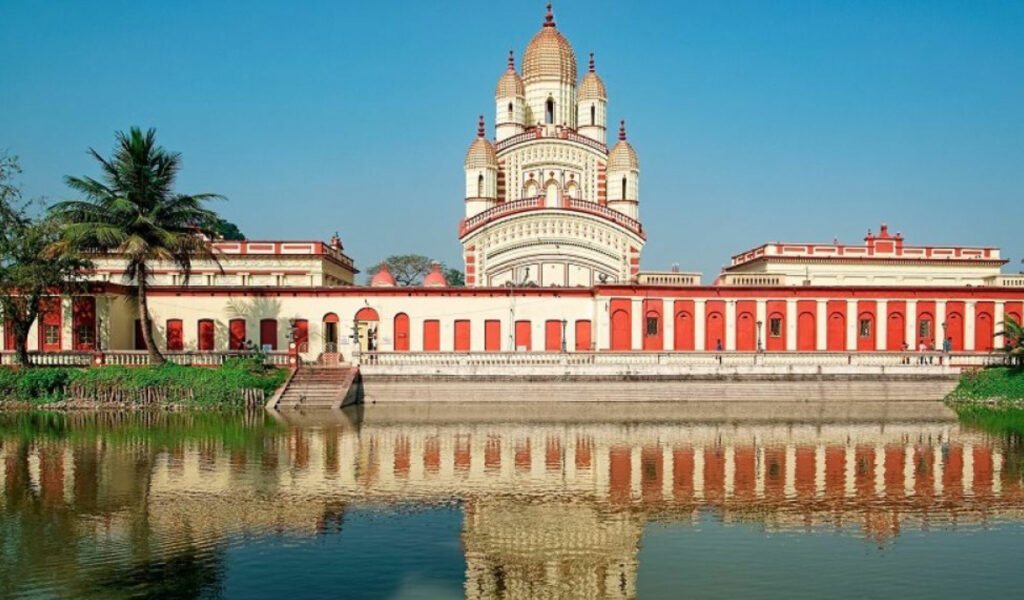
The Dakshineswar Kali Temple is one of the most revered places of interest in Kolkata, attracting pilgrims and tourists alike. Located on the eastern bank of the Hooghly River, this temple was built in 1855 by Rani Rashmoni, a philanthropist and devotee of Goddess Kali. Dedicated to Bhavatarini, an aspect of Goddess Kali, the temple holds immense spiritual significance and has been associated with the saint Ramakrishna Paramhansa, who served as its head priest.
The temple’s architecture is a fine example of Bengal temple style, with nine spires arranged in three tiers. The sprawling complex also includes twelve shrines dedicated to Lord Shiva, a temple for Radha-Krishna, and the bathing ghat on the Hooghly, where devotees take a dip before prayers. Its serene riverside setting makes it an unforgettable spiritual retreat.
Visitors often combine a trip here with Belur Math, located just across the river, connected by ferry. The temple sees thousands of devotees daily, especially during Kali Puja and Durga Puja, when it transforms into a sea of devotion and festivity.
•⏰ Timings: 6:00 AM – 12:30 PM & 3:00 PM – 8:30 PM
•🎟️ Entry Fee: Free
•💡 Travel Tip: Arrive early in the morning to avoid long queues and enjoy a peaceful darshan. Pair your visit with a ferry ride to Belur Math.
Dakshineswar is not just a temple, but a spiritual journey that captures the essence of Kolkata’s devotional life.
17. Kalighat Kali Temple
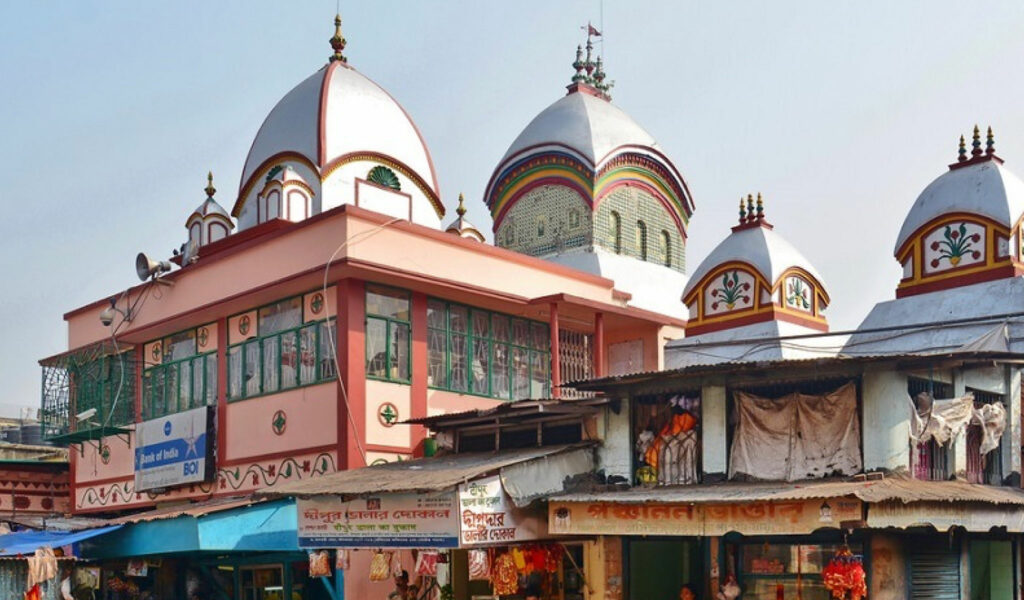
Situated in the bustling heart of South Kolkata, the Kalighat Temple is another important tourist place of Calcutta and one of the 51 Shakti Peethas in India. Believed to be the site where the right toe of Goddess Sati fell, Kalighat has been a center of Shakti worship for centuries. The current structure, about 200 years old, was built in the early 19th century, though the temple’s sanctity goes back much further.
The main deity, Goddess Kali, is represented in a unique form with a long tongue, three huge eyes, and four hands. Devotees from across India come here seeking blessings, especially during auspicious days like Kali Puja and Navratri. The temple is also historically connected with Ramakrishna Paramhansa, who often visited with his wife Sarada Devi.
Despite the bustling crowds and narrow lanes leading to it, the temple radiates immense spiritual energy. Around the temple complex, you’ll also find numerous small shops selling offerings, religious items, and sweets.
•⏰ Timings: 5:00 AM – 2:00 PM & 5:00 PM – 10:30 PM
•🎟️ Entry Fee: Free
•💡 Travel Tip: Visit on a weekday to avoid heavy crowds. Be prepared for touts near the entrance; stick to official temple volunteers for offerings.
Kalighat is not just a temple; it is the pulsating heart of Kolkata’s devotion to the Divine Mother.
18. Belur Math
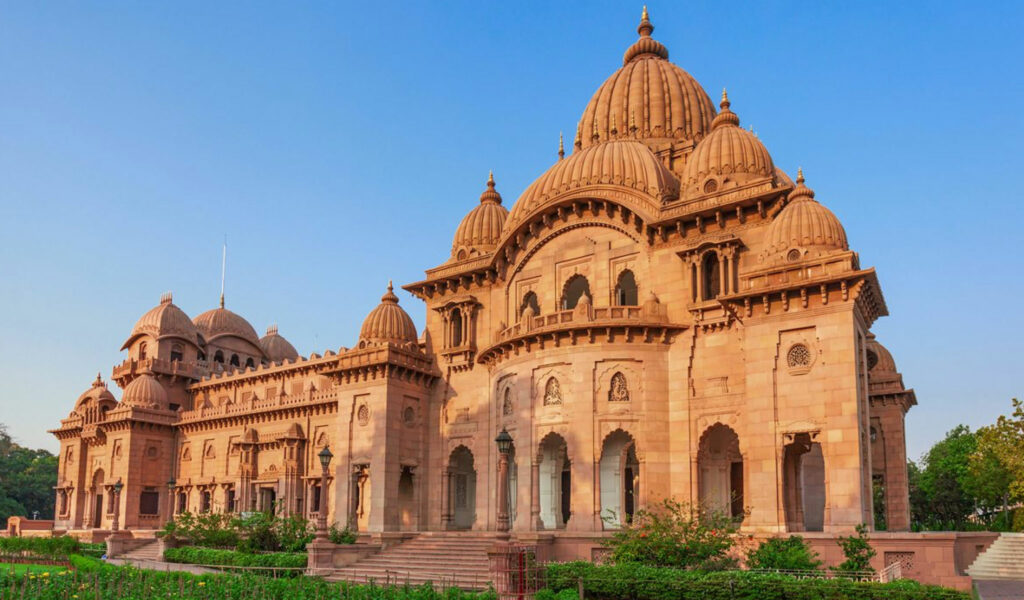
On the opposite bank of the Hooghly from Dakshineswar lies Belur Math, the headquarters of the Ramakrishna Math and Mission. Founded by Swami Vivekananda in 1897, this spiritual center embodies harmony among religions. Its main temple is an architectural marvel, designed in such a way that it resembles a Hindu temple, a church, and a mosque simultaneously, symbolizing universal brotherhood.
The sprawling campus is serene, with gardens, prayer halls, shrines, and the memorials of Ramakrishna, Sarada Devi, and Swami Vivekananda. The highlight is the evening “aarti” (prayer), which draws devotees into a state of meditative calm. Belur Math is also a hub of spiritual education and social service, carrying forward Swami Vivekananda’s vision.
Accessible via road and ferry, it offers a peaceful contrast to the bustle of the city. It’s a place where spirituality, culture, and architecture come together beautifully.
•⏰ Timings: 6:00 AM – 12:00 PM & 4:00 PM – 9:00 PM
•🎟️ Entry Fee: Free
•💡 Travel Tip: Don’t miss the evening aarti — it’s an unforgettable spiritual experience. Combine with Dakshineswar Temple for a complete pilgrimage.
Belur Math stands as one of the most peaceful places to see Kolkata, where faith unites rather than divides.
19. Pareshnath Jain Temple
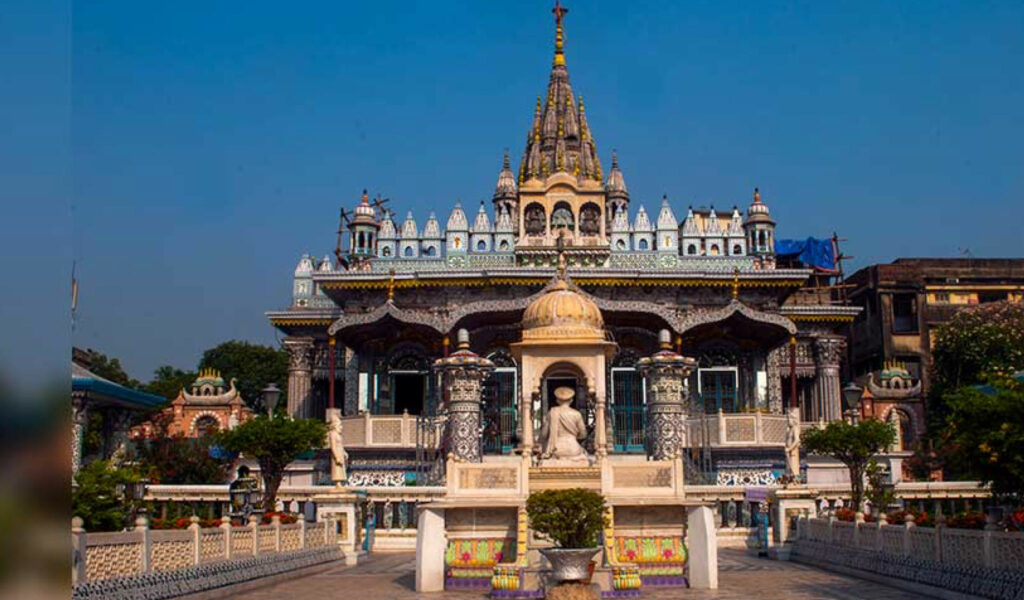
The Pareshnath Jain Temple, located in North Kolkata, is one of the most dazzling religious structures in the city. Built in 1867 by Rai Badridas Bahadoor Mookim, the temple is dedicated to Shitalnath Ji, the 10th Jain Tirthankara. The shrine is known for its ornate architecture, featuring stained glass windows, mirror work, mosaics, and intricately carved pillars.
The temple complex is a peaceful retreat with beautiful gardens, fountains, and sculptures. The sanctum, adorned with Belgian glass and chandeliers, creates a stunning visual effect when sunlight streams through. For architecture lovers, this temple is a jewel among Kolkata’s spiritual landmarks.
•⏰ Timings: 6:00 AM – 11:00 AM & 3:00 PM – 7:00 PM
•🎟️ Entry Fee: Free
•💡 Travel Tip: Visit in the morning for fewer crowds and to enjoy the play of light through the stained glass. Photography is restricted inside.
The Pareshnath Jain Temple is not only a place of worship but also an architectural masterpiece among Kolkata tour places.
20. Birla Mandir (Lakshmi Narayan Temple)

The Birla Mandir is one of the newer yet immensely popular places to see in Kolkata. Completed in 1996 after nearly three decades of construction, this marble temple was built by the Birla family, known for their philanthropic contributions across India.
Dedicated to Lord Krishna and Radha, the temple’s design resembles the Lingaraj Temple of Bhubaneswar, with towering shikharas (spires) and exquisite marble carvings. The interiors feature sculpted panels depicting scenes from the Bhagavad Gita, while the sanctum radiates peace and devotion. At night, the temple glows beautifully under illumination, attracting thousands of devotees and tourists.
•⏰ Timings: 5:30 AM – 11:00 AM & 4:30 PM – 9:00 PM
•🎟️ Entry Fee: Free
•💡 Travel Tip: The temple is best visited in the evening when the lights are switched on, adding a serene charm.
The Birla Mandir is a modern symbol of devotion and architectural elegance, firmly placing itself among the city’s top tourist places of Calcutta.
21. Indian Museum
The Indian Museum, founded in 1814, is the oldest and largest museum in India, making it one of the top places of interest in Kolkata for history and culture enthusiasts. Spread over multiple galleries, this massive institution houses an incredible collection of over 100,000 artifacts. From ancient fossils and Mughal miniatures to Egyptian mummies and Buddhist relics, the exhibits span across anthropology, archaeology, zoology, geology, and art.
One of its highlights is the 4,000-year-old Egyptian mummy, which continues to fascinate visitors of all ages. The Bharhut Gallery, showcasing railings and gateways of Buddhist stupas, and the Gandhara sculptures reflecting Greco-Buddhist art, are equally mesmerizing. The museum also has extensive coin collections and rare textiles.
The grandeur of the building itself, designed in Italian style with colonnaded halls, adds to the experience. For students, researchers, or casual visitors, the Indian Museum offers a deep dive into India’s cultural and natural heritage.
•⏰ Timings: 10:00 AM – 5:00 PM (Closed on Mondays & National Holidays)
•🎟️ Entry Fee: ₹20 (Indians), ₹500 (Foreigners), ₹10 (Students)
•💡 Travel Tip: The museum is vast, so set aside at least 2–3 hours. Consider hiring a guide for deeper insights.
The Indian Museum is truly a treasure trove — a must on any list of places to see Kolkata.
22. Birla Industrial & Technological Museum (BITM)
Opened in 1959, the Birla Industrial & Technological Museum is Asia’s first science museum and a pioneering institution in interactive learning. Managed by the National Council of Science Museums, it is designed to make science fun and accessible, especially for children.
The museum’s galleries cover diverse topics — from electricity, petroleum, and nuclear physics to electronics, biotechnology, and communication. Interactive exhibits allow visitors to experiment and learn, making it a favorite for school groups. The “Motors and Machines” gallery, which displays vintage cars and engines, is particularly popular.
The museum also hosts live science demonstrations, planetarium shows, and workshops throughout the year, making it more than just a static display space. For families, it’s an engaging way to spend half a day while introducing kids to science in an exciting manner.
•⏰ Timings: 9:30 AM – 6:00 PM (Open all days except Holi and Diwali)
•🎟️ Entry Fee: ₹30 (adults), ₹20 (students); Extra charges for special shows
•💡 Travel Tip: Great for kids and school groups — check their schedule for daily live demonstrations.
BITM combines learning with fun, standing out as a unique Kolkata tour place.
23. Science City

One of the most popular modern attractions in the city, Science City is Asia’s largest science center. Opened in 1997, it offers a blend of education and entertainment with its interactive exhibits and thrilling shows.
Highlights include the Space Odyssey section with 3D films, Time Machine rides, and the Digital Panorama Theatre. The Evolution Park traces the journey of life through lifelike models and dioramas. Another crowd favorite is the Earth Exploration Hall, which presents exhibits on different geographical zones of the planet. For children, the Science Park outside has fun rides and simple physics-based games.
The massive complex can take an entire day to explore, and it remains a favorite weekend destination for families. It’s not just educational — it’s pure fun.
•⏰ Timings: 9:00 AM – 8:00 PM daily
•🎟️ Entry Fee: ₹60 (general entry); Extra for special shows like 3D films and Time Machine
•💡 Travel Tip: Plan at least half a day to explore properly. Keep some time aside for the outdoor Science Park.
Science City is a must-visit tourist place of Calcutta for families, students, and anyone curious about the wonders of science.
24. Rabindra Bharati Museum (Jorasanko Thakur Bari)
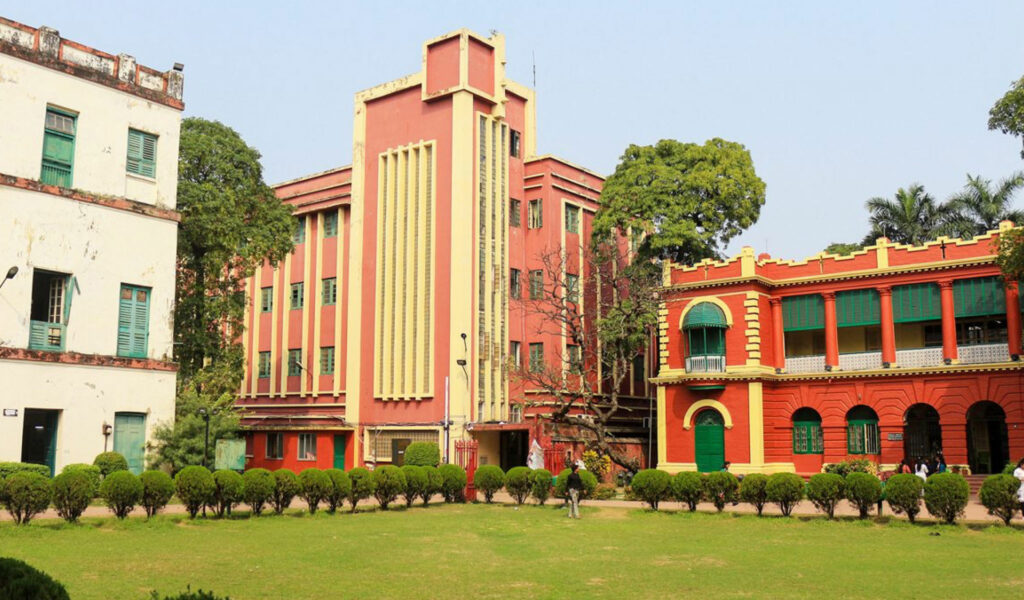
The Rabindra Bharati Museum, housed in the Jorasanko Thakur Bari, is one of the most culturally significant places of interest in Kolkata. This was the ancestral home of the Tagore family and the birthplace of Rabindranath Tagore, India’s first Nobel laureate.
The museum, established in 1961 to mark Tagore’s birth centenary, preserves his manuscripts, letters, photographs, and personal belongings. Walking through its rooms, visitors get a sense of Tagore’s life, his literary genius, and his influence on Bengal’s cultural renaissance. The galleries also cover the broader Tagore family’s contributions to music, theatre, and art.
The mansion itself is an architectural delight with spacious courtyards and colonial-Bengali design. Cultural events, especially during Rabindra Jayanti, bring the museum alive with songs, plays, and recitations.
•⏰ Timings: 10:30 AM – 4:30 PM (Closed on Mondays & National Holidays)
•🎟️ Entry Fee: ₹20 (Indians), ₹30 (Foreigners), ₹10 (Students)
•💡 Travel Tip: Allocate at least an hour or two. Literature lovers should not miss this gem.
For those interested in Bengal’s cultural heartbeat, Jorasanko is an unmissable Kolkata tour place.
25. Netaji Bhawan
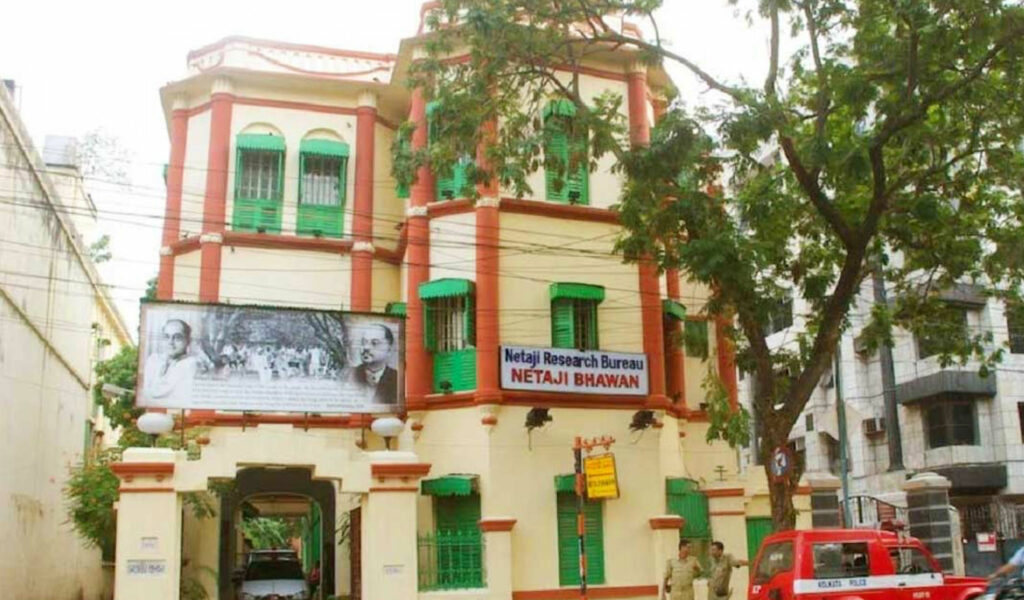
The Netaji Bhawan, also called the Netaji Subhas Chandra Bose Memorial Hall, is dedicated to one of India’s greatest freedom fighters. This was Bose’s ancestral home and the site of his famous escape in 1941, when he slipped away in disguise to seek international support for India’s independence.
Today, the house functions as a museum and research center, preserving Netaji’s personal belongings, uniforms, letters, and photographs. One of its prized exhibits is the car he used during his daring escape. The museum offers an intimate glimpse into Bose’s life, from his student years to his leadership of the Indian National Army.
Managed by the Netaji Research Bureau, the Bhawan also hosts seminars and maintains archives for researchers. For history buffs, this is one of the most important places to see in Kolkata.
•⏰ Timings: 11:00 AM – 4:30 PM (Closed on Mondays and national holidays)
•🎟️ Entry Fee: ₹20
•💡 Travel Tip: Spend at least an hour here to absorb Netaji’s extraordinary story. History enthusiasts will appreciate hiring a guide.
Visiting Netaji Bhawan is like stepping into the pages of India’s freedom struggle — a humbling yet inspiring experience.
26. Mother’s Wax Museum
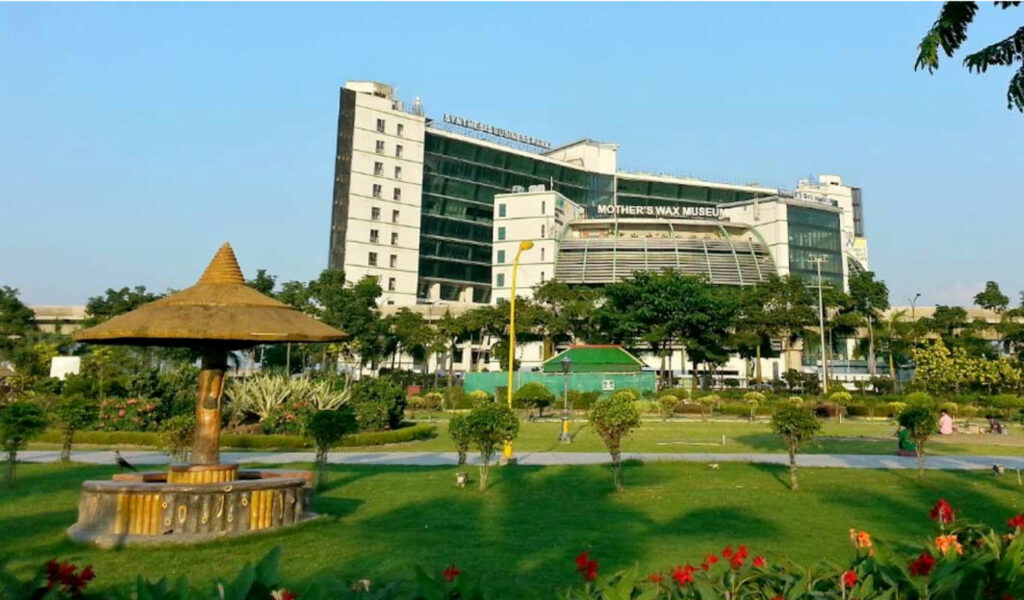
Opened in 2014 in New Town, Mother’s Wax Museum is Kolkata’s answer to the famous Madame Tussauds. Named after Mother Teresa, this modern museum features lifelike wax statues of Indian and international personalities, making it one of the city’s most fun and interactive tourist places of Calcutta.
From Mahatma Gandhi, Rabindranath Tagore, and Netaji Subhas Chandra Bose to Amitabh Bachchan, Shah Rukh Khan, and Lionel Messi — the collection spans leaders, cultural icons, sports legends, and film stars. Each figure is crafted with incredible detail, allowing visitors to click photographs right beside their heroes.
Unlike traditional museums, this one focuses on entertainment and engagement, making it especially popular with families and youngsters. The vibrant atmosphere and variety of figures ensure there’s something for everyone, whether you’re a history lover or a Bollywood fan.
•⏰ Timings: 12:00 PM – 7:30 PM (Closed on Mondays)
•🎟️ Entry Fee: ₹250 per person
•💡 Travel Tip: Visit on weekdays for fewer crowds and take your time posing with the wax figures.
Mother’s Wax Museum brings history and celebrity culture alive in a lighthearted way, making it one of the most modern places to see Kolkata.
27. Nehru Children’s Museum
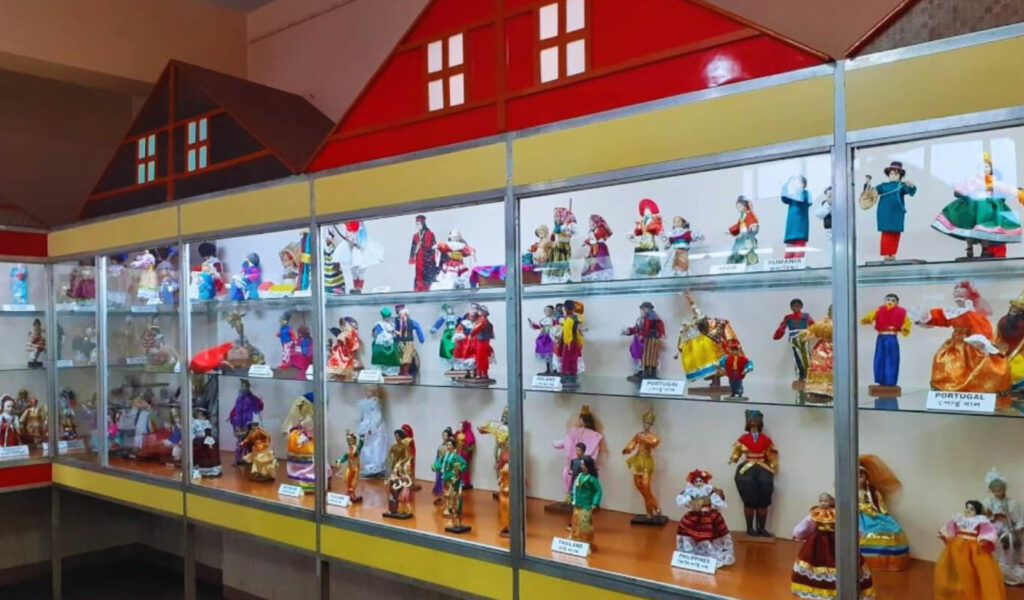
The Nehru Children’s Museum, established in 1972, is a beloved educational and recreational space for kids. With four floors of engaging exhibits, it encourages learning through fun, making it a favorite weekend spot for families.
Highlights include the Dolls Gallery, which displays more than 15,000 dolls from across 88 countries, offering children a chance to explore world cultures in miniature. The Toys Gallery, meanwhile, delights with traditional and modern playthings. There’s also an exhibition on epics like the Mahabharata and Ramayana, narrated through life-sized clay models.
The museum frequently organizes art competitions, storytelling events, and interactive workshops, keeping young visitors engaged and inspired. It’s more than a museum; it’s a cultural hub that nurtures creativity in children.
•⏰ Timings: 11:00 AM – 7:00 PM (Closed on Mondays and Tuesdays)
•🎟️ Entry Fee: ₹20 per person
•💡 Travel Tip: A must for families with children. Allow 1–2 hours for a full experience.
This museum is one of the most enriching places of interest in Kolkata for young learners and their parents alike.
28. Birla Planetarium
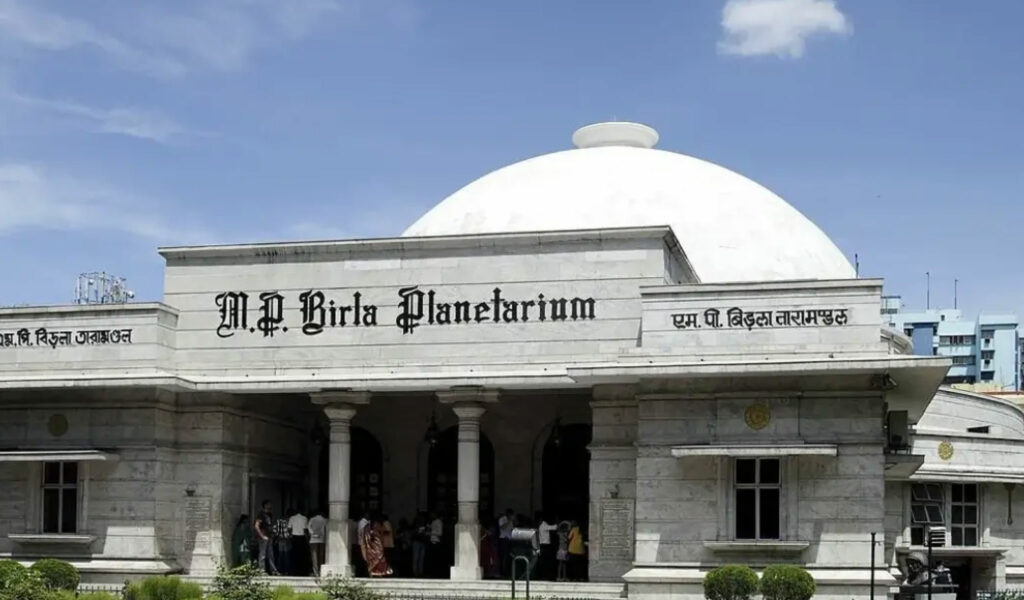
The Birla Planetarium, locally known as “Taramandal,” is one of the largest planetariums in Asia and a must-visit Kolkata tour place for science enthusiasts. Inaugurated in 1963 by Prime Minister Jawaharlal Nehru, the dome-shaped structure was modeled after the Buddhist stupa at Sanchi.
The planetarium offers fascinating shows on astronomy, space exploration, and cosmic phenomena, projected onto its massive dome. With state-of-the-art equipment and multilingual shows in English, Hindi, and Bengali, it attracts students, families, and curious travelers. Beyond the shows, the complex also houses astronomy galleries with charts, celestial models, and exhibits on space science.
•⏰ Timings: Shows daily at 12:00 PM, 1:00 PM, 2:30 PM, 4:00 PM, 5:00 PM, and 6:00 PM
•🎟️ Entry Fee: ₹120 per show
•💡 Travel Tip: Arrive at least 30 minutes early, as tickets sell out quickly, especially on weekends.
For anyone fascinated by the mysteries of the universe, the Birla Planetarium is a star attraction among places to see Kolkata.
29. Asutosh Museum of Indian Art

Established in 1937, the Asutosh Museum of Indian Art is India’s first university museum, located within the University of Calcutta. Named after Sir Asutosh Mukherjee, a visionary educationist, the museum specializes in Bengal’s rich artistic heritage while also covering art traditions from across India.
Its collections include terracotta sculptures, folk paintings, textiles, coins, and stone carvings from different historical periods. Particularly impressive are the Bengal school paintings, Kalighat patachitras, and rare pieces of early Buddhist art. For researchers and art lovers, the museum offers a deep insight into the evolution of Indian aesthetics.
Although smaller than the Indian Museum, its focused curation makes it a hidden gem for those seeking authentic encounters with India’s artistic past.
•⏰ Timings: 10:30 AM – 5:00 PM (Closed on Sundays and holidays)
•🎟️ Entry Fee: Free
•💡 Travel Tip: Best suited for art and history enthusiasts. Pair it with a visit to College Street nearby.
Quiet and scholarly, this museum is one of the underrated places of interest in Kolkata.
30. Academy of Fine Arts
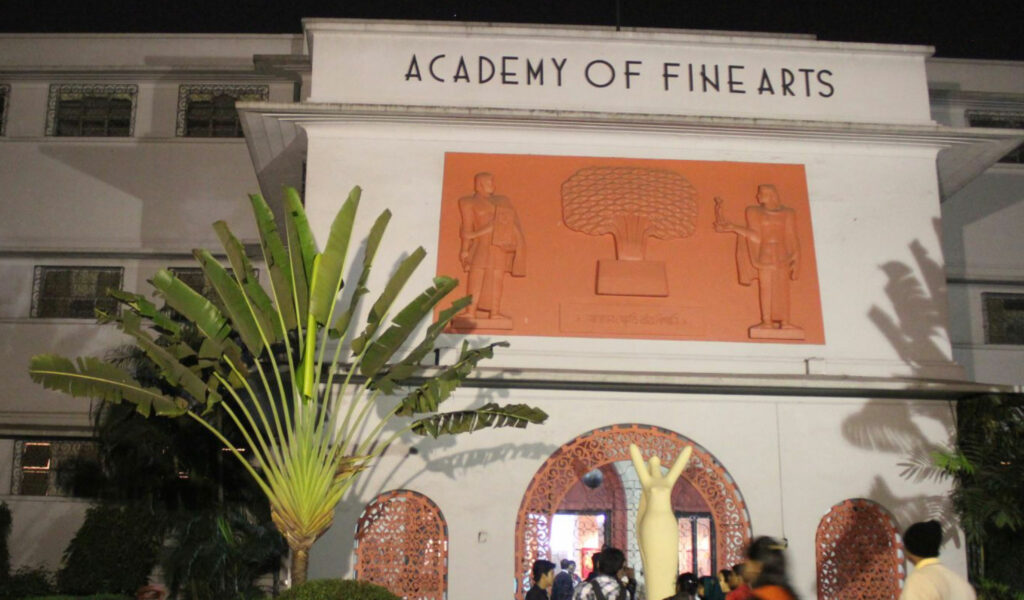
The Academy of Fine Arts, established in 1933, is one of India’s oldest and most prominent art galleries. Located near the Maidan and Victoria Memorial, it plays a pivotal role in Kolkata’s cultural scene.
The academy houses permanent collections that include works by Rabindranath Tagore, Jamini Roy, and Nandalal Bose, along with changing exhibitions by contemporary artists. Its spacious galleries regularly host painting, sculpture, and photography exhibitions, making it a vibrant platform for emerging and established talent.
Beyond art displays, the academy has a well-known theatre auditorium that stages plays, cultural performances, and literary events. For decades, it has been at the heart of Bengal’s creative community, fostering dialogue between tradition and modernity.
•⏰ Timings: 12:00 PM – 8:00 PM daily
•🎟️ Entry Fee: ₹10 – ₹20
•💡 Travel Tip: Keep an eye out for temporary exhibitions and theatre performances. Even a casual visitor will enjoy an hour here.
For culture lovers, the Academy of Fine Arts is a shining star among tourist places of Calcutta, where creativity thrives every day.
31. Maidan
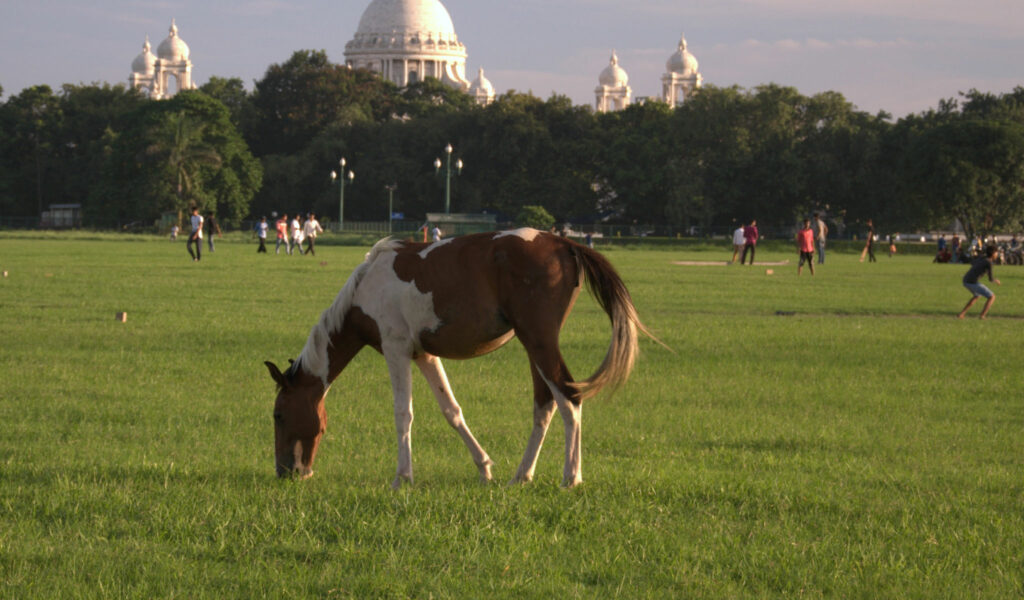
Known as the lungs of Kolkata, the Maidan is the city’s largest urban park, stretching over 1,000 acres. Originally cleared by the British East India Company to provide an open field for Fort William, the Maidan has evolved into the city’s favorite leisure and recreational space.
The Maidan is dotted with landmarks such as Shaheed Minar, Eden Gardens, and several statues of historical figures. It also houses clubs like the iconic Mohun Bagan and East Bengal football clubs, making it central to Kolkata’s sporting culture. Horse rides, cricket matches, morning joggers, and evening strollers all give this green expanse its lively rhythm.
For photographers, the Maidan offers striking contrasts: colonial monuments on one side, modern skyscrapers on the other, and everyday city life in between. At sunrise and sunset, the sprawling fields bathed in golden light feel especially magical.
•⏰ Timings: Open all day
•🎟️ Entry Fee: Free
•💡 Travel Tip: Early mornings are best to experience the calm. In winter, the misty Maidan makes for spectacular photography.
No trip is complete without walking through the Maidan — it’s where Kolkata breathes.
32. Eden Gardens
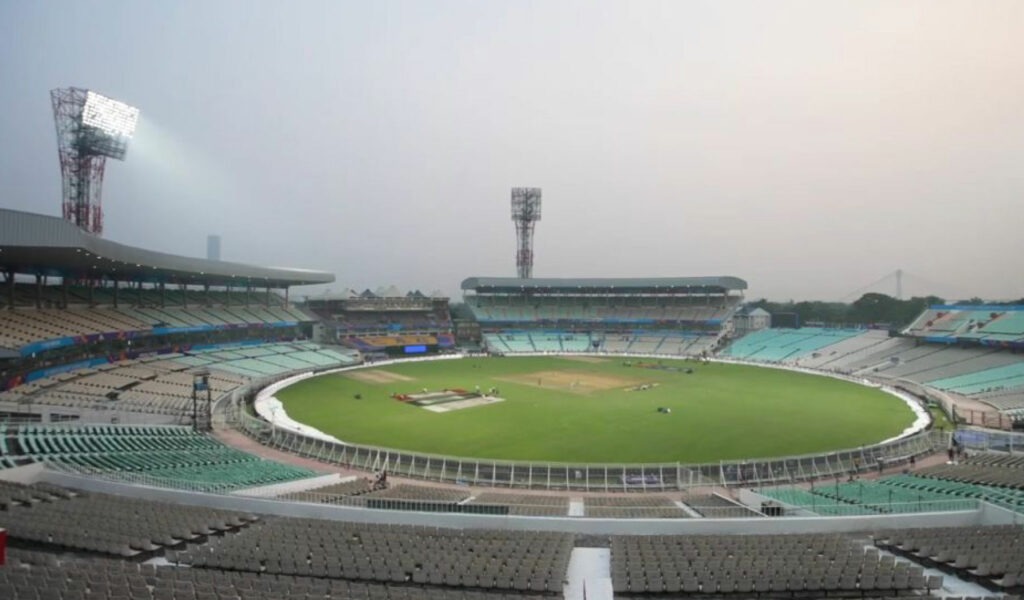
Often called the “Mecca of Indian Cricket,” Eden Gardens is one of the most famous cricket stadiums in the world. Established in 1864, it can host over 66,000 spectators, making it the second-largest cricket stadium globally.
For sports lovers, Eden Gardens is more than just a stadium — it’s a shrine of cricketing history. Legendary matches have been played here, from India’s victories to unforgettable World Cup clashes. The roar of the Kolkata crowd is said to be unmatched in passion and energy.
When no matches are scheduled, visitors can take guided tours that include the stands, galleries, and even the player pavilions. Just outside, Eden Garden Park and the iconic Burmese Pagoda add to its charm.
•⏰ Timings: Stadium tours available on request (dependent on match schedules)
•🎟️ Entry Fee: Tour charges vary; match tickets depend on events
•💡 Travel Tip: If possible, book tickets for a live match — the atmosphere is electrifying.
For cricket fans, Eden Gardens is one of the ultimate places to see Kolkata.
33. Acharya Jagadish Chandra Bose Indian Botanic Garden
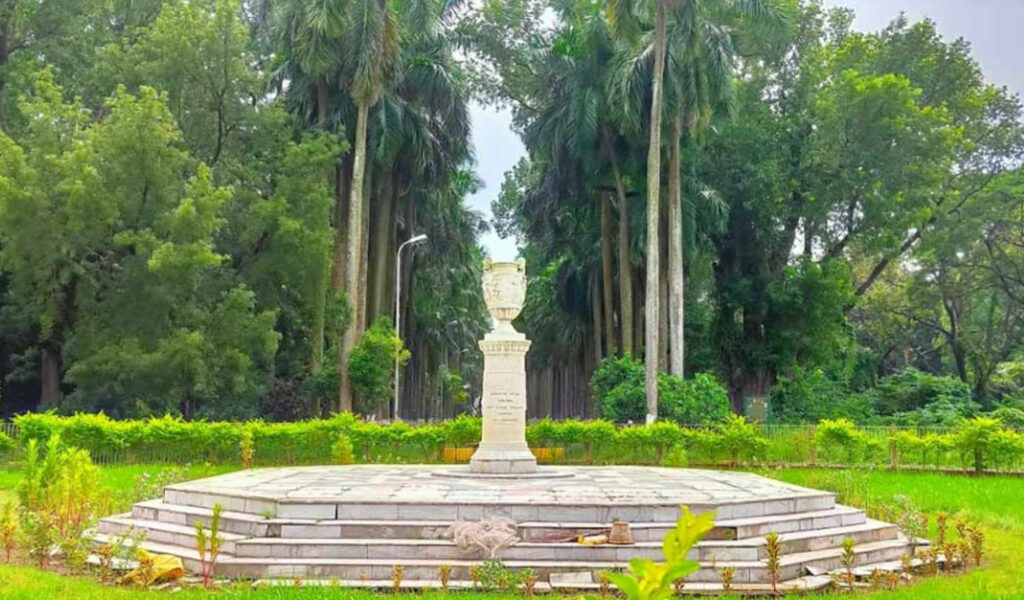
Located in Shibpur, just across the Hooghly River, the Indian Botanic Garden is a tranquil escape from the city buzz. Established in 1787 by Colonel Robert Kyd, it is one of the oldest and largest botanical gardens in the world.
Spread across 270 acres, the garden is home to more than 12,000 species of plants, including rare orchids, giant water lilies, and medicinal herbs. Its star attraction is the Great Banyan Tree, which spreads over 14,500 square meters with more than 3,700 aerial roots, creating the appearance of an entire forest.
For nature lovers, the garden is a paradise — walking through its shaded avenues feels refreshing, and birdwatchers will find many species here. The garden also plays a key role in botanical research.
•⏰ Timings: 10:00 AM – 5:00 PM (Closed Mondays)
•🎟️ Entry Fee: ₹20 (Indians), ₹100 (Foreigners)
•💡 Travel Tip: Wear comfortable shoes, as the garden is vast. The Great Banyan is best visited in the morning light.
The Botanic Garden is an oasis of peace and one of the most beautiful places of interest in Kolkata.
34. Rabindra Sarobar
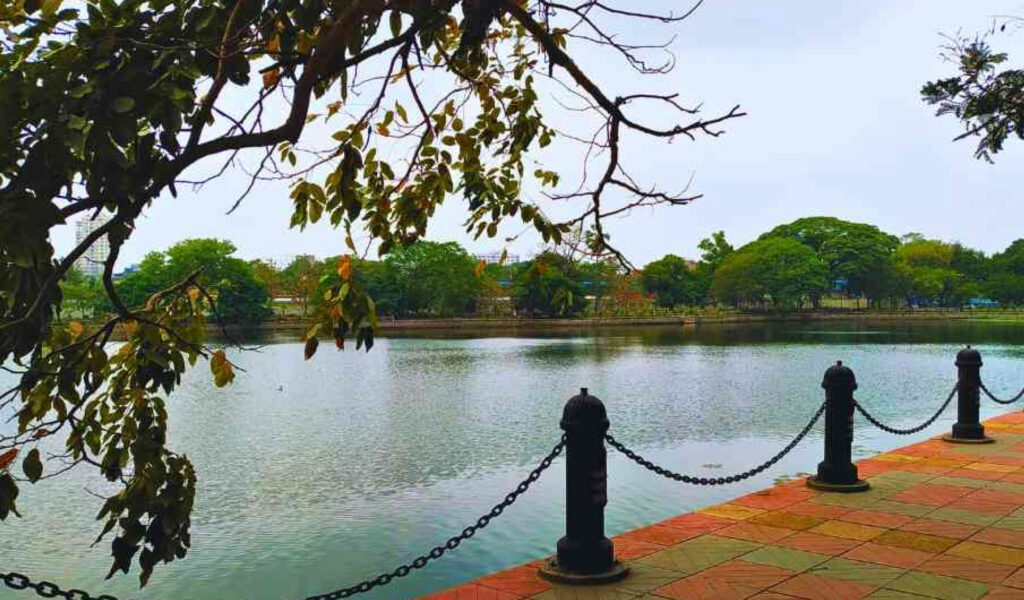
Also known simply as “The Lake,” Rabindra Sarobar is a man-made lake in South Kolkata, created in the 1920s. Surrounded by landscaped gardens, jogging tracks, and shaded walkways, it has become a favorite escape for fitness enthusiasts, families, and couples.
The lake is also a hub for cultural life — open-air theatre, rowing clubs, and morning yoga sessions give it a lively atmosphere. Birdwatchers often spot migratory species here during winter, making it a hidden gem for nature lovers. In the evenings, the lake transforms into a calm retreat, with the water reflecting the city’s lights.
•⏰ Timings: 5:00 AM – 8:00 PM
•🎟️ Entry Fee: Free
•💡 Travel Tip: Visit early morning for fresh air and birdwatching, or in the evening for a peaceful stroll.
Rabindra Sarobar offers a refreshing break from urban chaos, ranking high among Kolkata tour places for locals and travelers alike.
35. Eco Park (New Town)
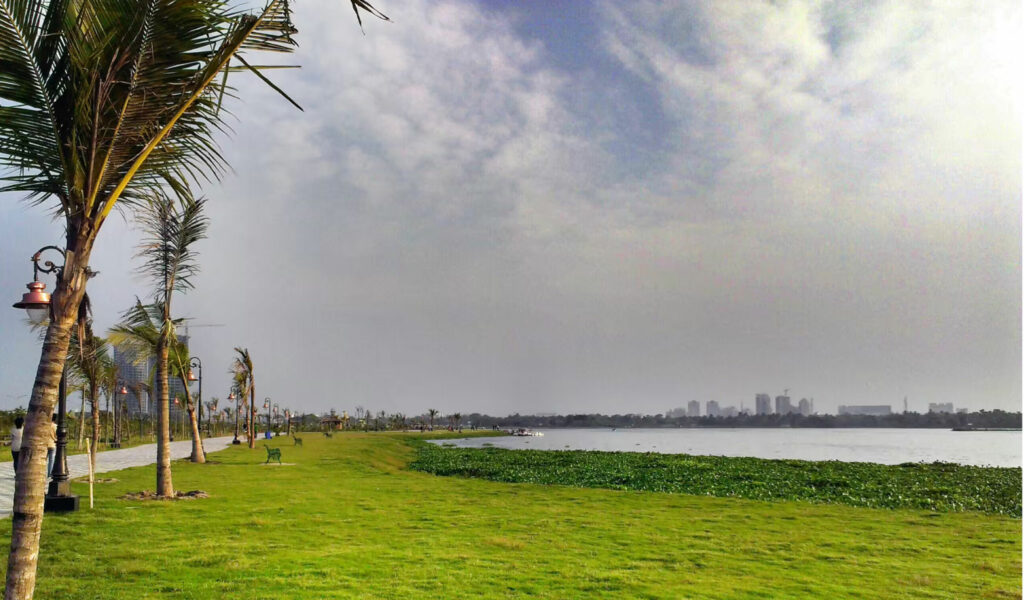
The Eco Park in New Town is one of the largest urban parks in India, sprawling over 480 acres with a massive waterbody at its center. Opened in 2012, it is a modern recreational hub designed to provide both relaxation and adventure.
The park is divided into themed gardens — a Japanese garden, rose garden, butterfly garden, cactus walk, and even a replica of the Seven Wonders of the World. Activities include boating, cycling, zorbing, kayaking, and toy train rides, making it perfect for families. Its musical fountain shows and evening illuminations attract crowds throughout the year.
Eco Park also hosts events, cultural programs, and exhibitions, making it much more than just a green space. For city dwellers, it’s a much-needed escape; for tourists, it’s a chance to see modern Kolkata’s commitment to green living.
•⏰ Timings: 2:30 PM – 8:30 PM (Closed on Mondays)
•🎟️ Entry Fee: ₹30 per person; extra charges for activities
•💡 Travel Tip: Plan your visit in the afternoon so you can enjoy both day activities and the evening lights.
Eco Park is one of the most dynamic places to see in Kolkata, balancing nature with recreation.
36. Alipore Zoological Gardens
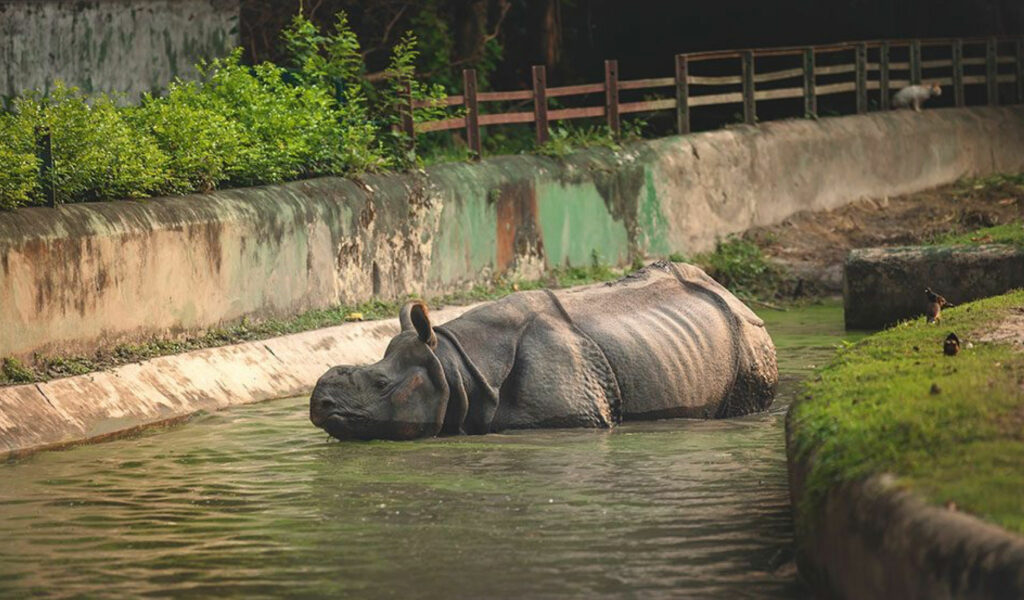
Established in 1876, the Alipore Zoological Gardens is India’s oldest formally established zoo and remains one of the most popular tourist places of Calcutta. Spread over 46 acres, it has been a favorite destination for families for generations.
The zoo houses a wide variety of animals including tigers, elephants, giraffes, reptiles, and exotic birds. Its most famous resident was Adwaita, a giant Aldabra tortoise believed to be over 250 years old before it passed away in 2006. The zoo is also home to an aquarium and aviary, adding to its appeal.
Visiting the zoo is as much about nostalgia as it is about discovery. Families often spend half a day wandering through enclosures, enjoying picnics, and learning about wildlife conservation. Winter is especially popular when schools bring children here for excursions.
•⏰ Timings: 9:00 AM – 4:30 PM (Closed Thursdays)
•🎟️ Entry Fee: ₹30 (adults), ₹10 (children)
•💡 Travel Tip: Visit in winter when the weather is pleasant. Try to arrive early to avoid large crowds.
For many, the Alipore Zoo is a cherished childhood memory and an evergreen place of interest in Kolkata.
37. Millennium Park
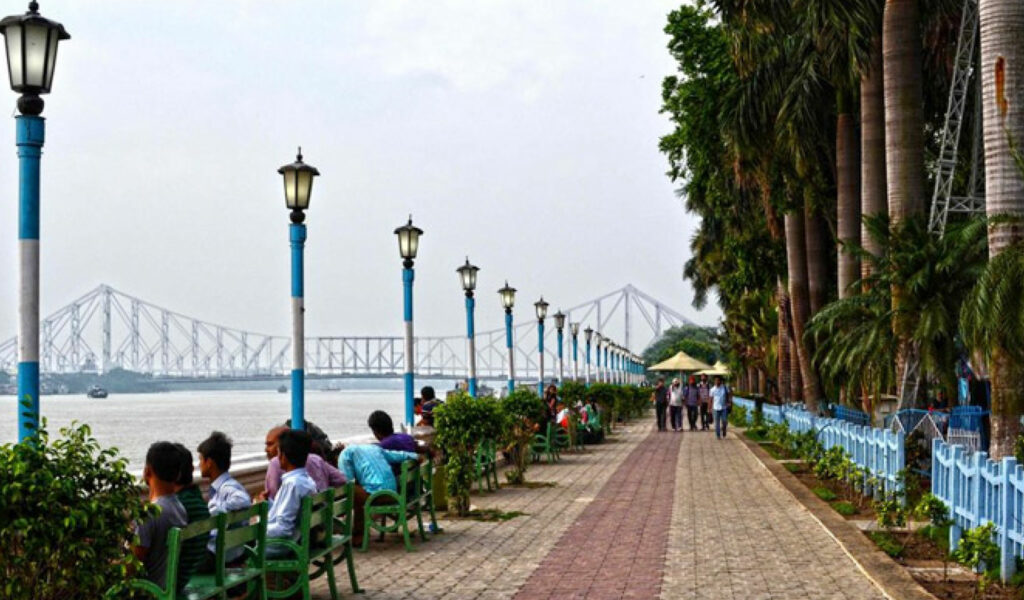
Stretching along the eastern bank of the Hooghly River, Millennium Park is a family-friendly recreational space developed as part of Kolkata’s riverfront beautification. Opened in 1999, it provides refreshing views of the Hooghly and iconic landmarks like the Howrah Bridge and Vidyasagar Setu.
The park features landscaped lawns, fountains, food kiosks, and a children’s play area, making it a favorite weekend spot. Couples stroll along the river promenade, families enjoy picnics, and kids revel in joy rides and toy trains. The river breeze and views make it particularly pleasant in the evenings.
Its location along Strand Road also makes it an excellent stop if you’re exploring the city’s colonial heritage. Many boat rides on the Hooghly start nearby, offering a chance to combine leisure with sightseeing.
•⏰ Timings: 10:00 AM – 6:30 PM daily
•🎟️ Entry Fee: ₹10 per person
•💡 Travel Tip: Visit at sunset for panoramic views of the river and bridges.
Millennium Park is among the most relaxing Kolkata tour places, where leisure meets riverside charm.
38. Central Park (Salt Lake)
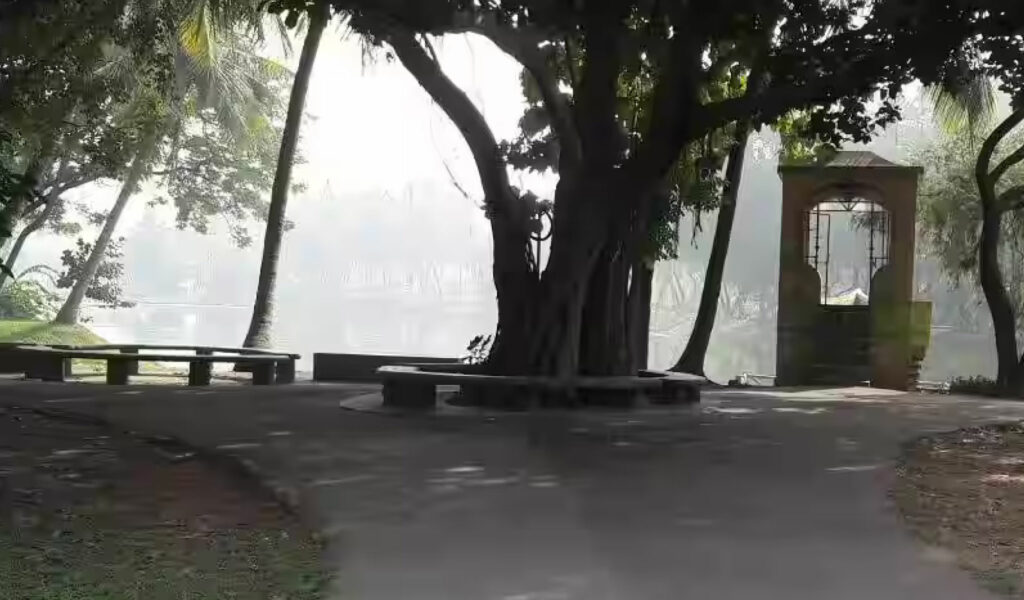
In the heart of Salt Lake City (Bidhannagar), Central Park is a sprawling green space and one of the largest urban parks in the Kolkata metropolitan area. With a vast waterbody at its center, the park is popular for boating, birdwatching, and quiet relaxation.
Landscaped gardens, pathways, and open spaces make it ideal for morning joggers and evening strollers. The rose garden within the park is especially beautiful during the winter season. Couples often enjoy the quiet spots along the lake, while families come for picnics and boating rides.
The park also hosts exhibitions and fairs occasionally, making it a lively hub during festivals. For those staying in Salt Lake, it’s the go-to spot for fresh air and leisure.
•⏰ Timings: 10:00 AM – 5:00 PM
•🎟️ Entry Fee: ₹10 per person
•💡 Travel Tip: Best visited in winter for the rose blooms and pleasant weather.
Central Park is one of the most refreshing places to see Kolkata, especially for those exploring the Salt Lake area.
39. Deshapriya Park
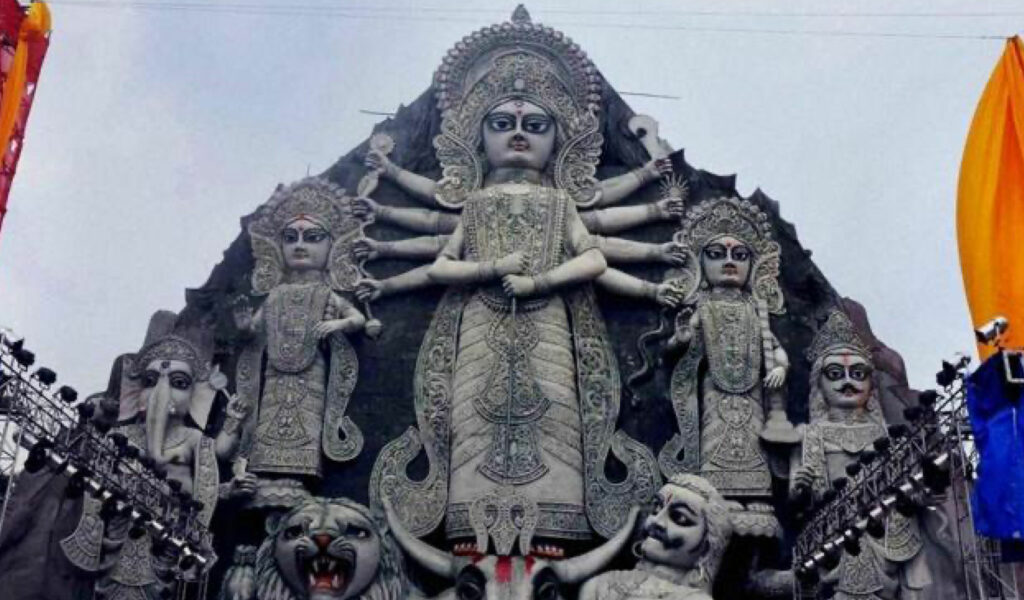
Located in South Kolkata, Deshapriya Park is a community hub best known for its role in the city’s cultural life. Surrounded by busy neighborhoods, the park is a green patch used for morning walks, sports practice, and social gatherings.
What makes Deshapriya Park particularly famous is its Durga Puja celebrations. The park gained nationwide attention in 2015 when it hosted the world’s largest Durga idol, drawing massive crowds. Every year, the pandals here attract devotees and tourists eager to witness creativity and devotion at its best.
Beyond festivals, the park is a lively space where locals practice football and cricket, while seniors enjoy leisurely walks.
•⏰ Timings: Open all day
•🎟️ Entry Fee: Free
•💡 Travel Tip: Visit during Durga Puja for the most vibrant experience, but expect large crowds.
Deshapriya Park is a neighborhood landmark, reflecting Kolkata’s love for community life and celebrations.
40. Mohor Kunja (Citizen’s Park)
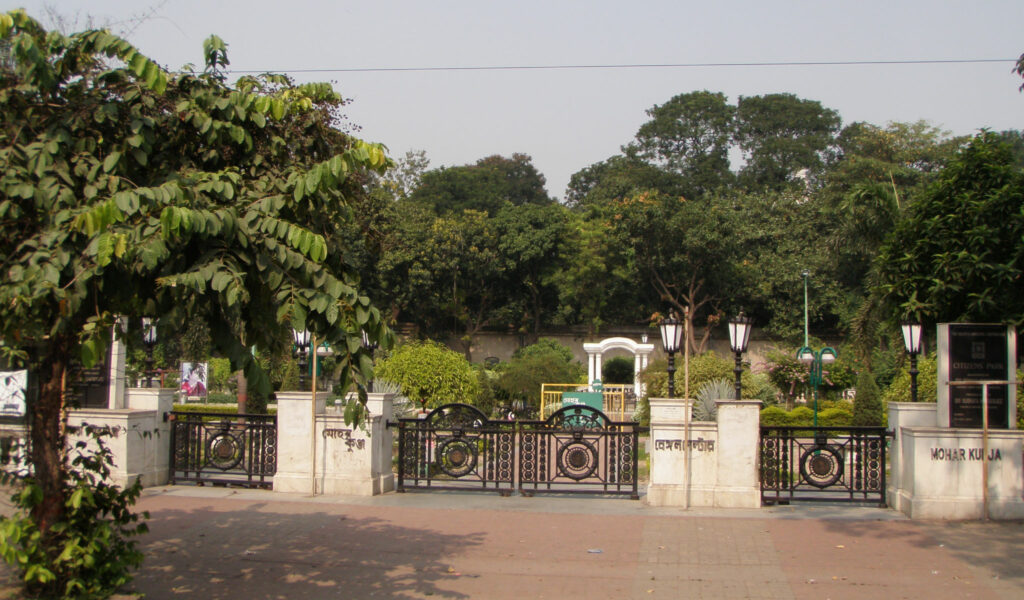
Located opposite the Victoria Memorial, Mohor Kunja is a beautifully landscaped park that combines greenery with culture. Formerly called Citizen’s Park, it was renamed in honor of singer Mohor Roy Chowdhury.
The park is known for its musical fountain shows in the evening, which draw both locals and tourists. Its manicured gardens, pathways, and open-air stage make it a popular spot for cultural programs, music events, and theatrical performances. Families often visit to relax, while couples enjoy the romantic ambiance created by the fountains and lights.
Its proximity to Victoria Memorial and Birla Planetarium makes it easy to include in a heritage sightseeing circuit.
•⏰ Timings: 12:00 PM – 8:00 PM daily
•🎟️ Entry Fee: ₹10 per person
•💡 Travel Tip: Visit in the evening for the fountain shows. Combine with a visit to Victoria Memorial nearby.
Mohor Kunja is a small but charming Kolkata tour place, offering a mix of leisure and culture.
41. College Street (Boi Para)

Nicknamed Boi Para (the Colony of Books), College Street is the ultimate destination for bibliophiles and one of the most unique places of interest in Kolkata. Stretching over 1.5 kilometers, this street is lined with countless bookstalls and shops, selling everything from rare out-of-print editions to the latest bestsellers. It is considered the world’s largest second-hand book market and Asia’s largest book market overall.
The atmosphere here is electric. Students from nearby institutions like Presidency University, Calcutta University, and the Sanskrit College throng the stalls, bargaining for textbooks, while scholars search for rare academic works. Many of the shops are small, makeshift stalls with towering piles of books that make browsing an adventure.
For visitors, simply walking along College Street is an experience — the smell of old paper, the sight of endless books, and the chatter of bargaining customers create a unique charm. The street also houses famous publishing houses and historic educational institutions, adding to its cultural aura.
•⏰ Timings: 10:00 AM – 8:00 PM daily
•🎟️ Entry Fee: Free
•💡 Travel Tip: Don’t miss the chance to explore hidden gems in the smaller stalls. Pair your visit with a stop at the legendary Indian Coffee House nearby.
College Street isn’t just a market — it’s a pilgrimage for book lovers and one of the most distinctive Kolkata tour places.
42. Indian Coffee House
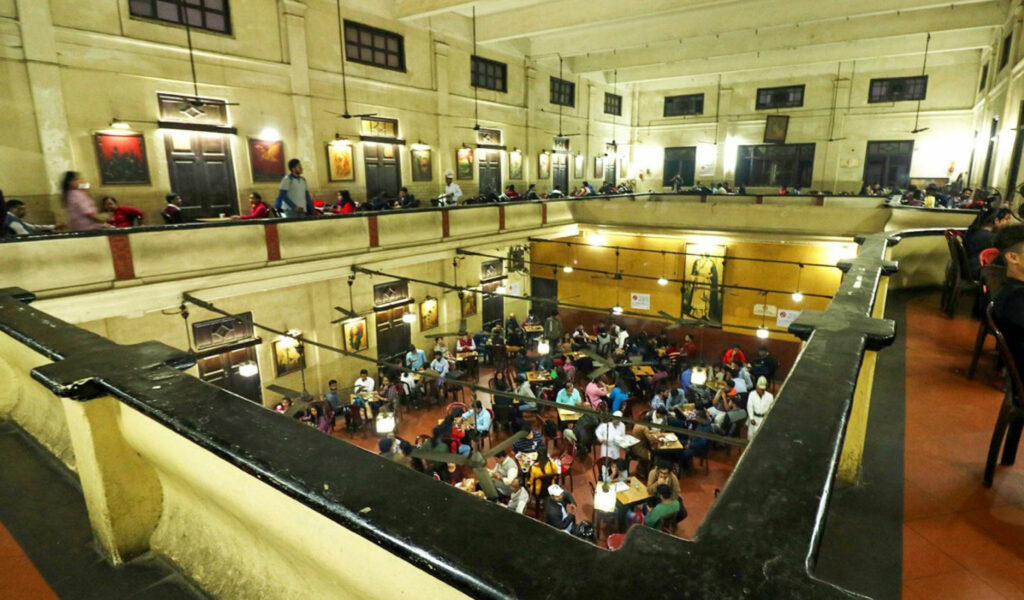
No visit to College Street is complete without a stop at the Indian Coffee House, a legendary café that has been the beating heart of Kolkata’s intellectual and cultural life for decades. Established in the 1940s, this historic café is famous not for luxury but for its atmosphere of adda (informal discussions).
From poets like Satyajit Ray and Manna Dey to countless professors and students, generations have gathered here to debate politics, philosophy, literature, and everything in between over endless cups of coffee. The interiors, with their high ceilings, worn-out furniture, and old-world charm, have remained unchanged, preserving its nostalgic character.
The menu is simple, featuring affordable coffee, fish fry, cutlets, and snacks, but it is the conversations that make the place legendary. For travelers, it offers a rare chance to immerse in Kolkata’s intellectual spirit.
•⏰ Timings: 9:00 AM – 9:00 PM daily
•🎟️ Entry Fee: Free (Pay for food: coffee ~₹25, snacks ~₹50–₹100)
•💡 Travel Tip: Visit during the evening to soak in the liveliest adda atmosphere. Don’t expect luxury — come for the experience.
The Indian Coffee House is more than a café; it’s a living museum of Kolkata’s cultural soul.
43. New Market (Sir Stuart Hogg Market)
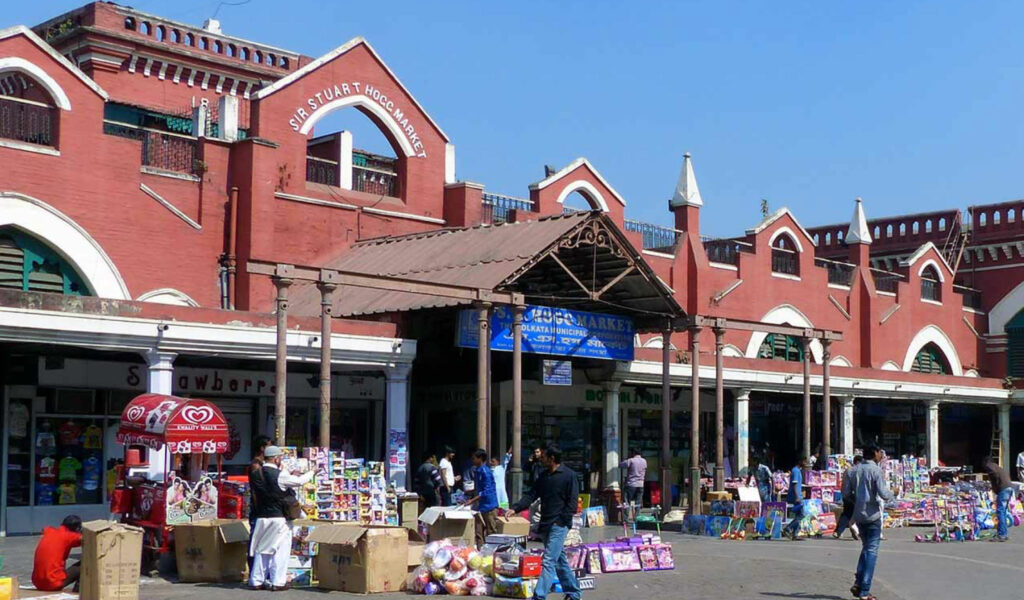
Built in 1874, New Market is one of the most iconic shopping destinations and among the busiest places to see Kolkata. Located on Lindsay Street, this sprawling bazaar houses more than 2,000 stalls, selling everything imaginable — clothes, jewelry, accessories, spices, flowers, toys, and local handicrafts.
The market is divided into sections, each specializing in particular goods. The flower section is an explosion of colors, while the meat and fish markets showcase Kolkata’s food culture. Saree shops here are particularly famous, offering everything from affordable cottons to expensive silks.
Despite the crowds, New Market remains a favorite for both locals and tourists, thanks to its heritage charm and unbeatable variety. The old red-brick façade gives it a vintage feel, and bargaining with shopkeepers is all part of the fun.
•⏰ Timings: 10:00 AM – 8:00 PM (Closed on Sundays)
•🎟️ Entry Fee: Free
•💡 Travel Tip: Be ready to bargain! Keep an eye on your belongings, as the market gets very crowded.
For a true taste of Kolkata’s shopping culture, New Market is an unmissable tourist place of Calcutta.
44. Gariahat Market
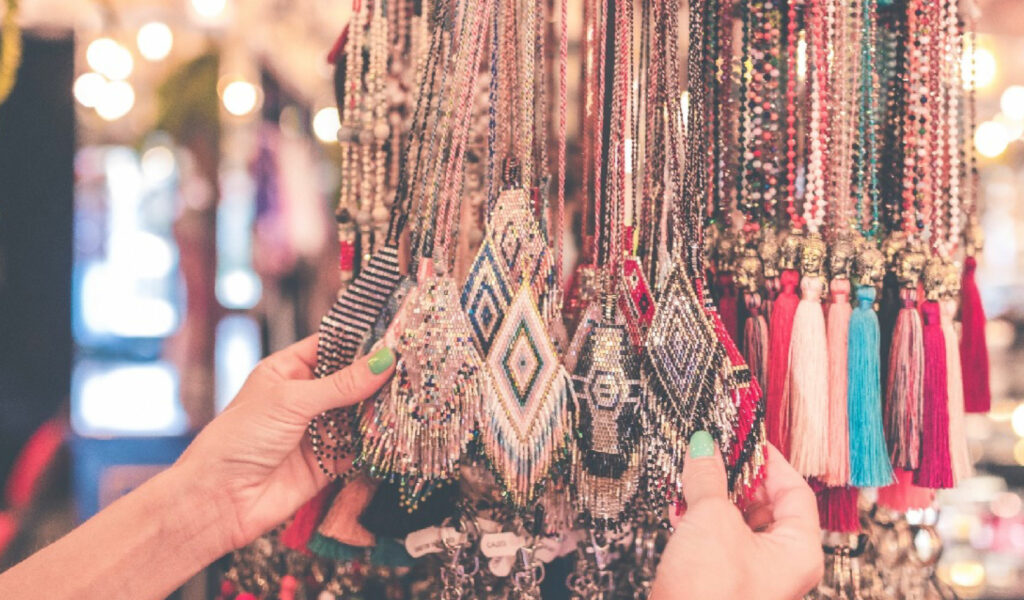
Located in South Kolkata, Gariahat Market is a vibrant shopping hub that perfectly captures the spirit of the city. Known especially for sarees, this market is a must-visit for anyone looking to buy traditional Bengali attire. From handloom cottons to luxurious silks, the variety here is unmatched.
Beyond sarees, Gariahat is filled with roadside stalls selling jewelry, bags, shoes, handicrafts, and household goods. The market stretches along Gariahat Road, creating a lively chaos of vendors calling out, customers bargaining, and endless options.
Adding to its appeal is the fantastic street food scene. From phuchka (pani puri) to kathi rolls and chaat, the flavors of Kolkata are on full display here. Shopping and snacking go hand in hand at Gariahat.
•⏰ Timings: 10:00 AM – 9:00 PM daily
•🎟️ Entry Fee: Free
•💡 Travel Tip: The evenings are busiest but also most atmospheric. Don’t forget to try the street food while shopping.
For both shopping and food, Gariahat is among the top places of interest in Kolkata.
45. Dakshinapan Shopping Complex
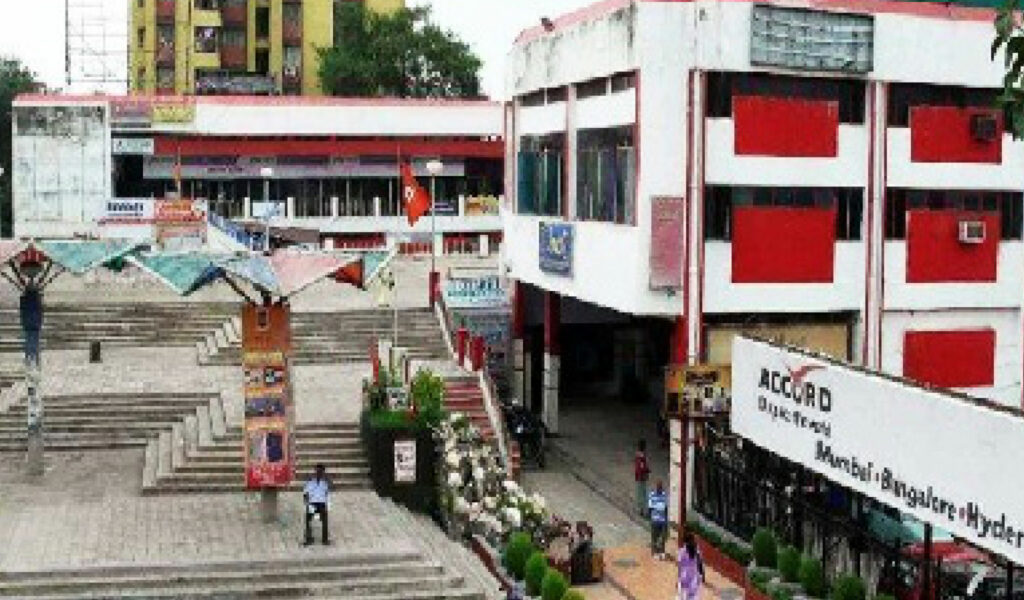
If you’re looking for authentic handicrafts, ethnic wear, and affordable souvenirs, the Dakshinapan Shopping Complex in Dhakuria is the place to go. This open-air market was established to promote Indian handlooms and handicrafts, and it brings together government emporiums from different states of India.
Here, you’ll find beautifully crafted sarees, shawls, terracotta items, jewelry, carpets, and decorative pieces — all at reasonable prices. Unlike other markets, Dakshinapan offers a more relaxed shopping experience without too much haggling.
The complex also has a cultural auditorium, where plays and performances are staged, keeping the area lively. Several small cafés and tea stalls add to the charm, making it a nice spot for leisurely shopping.
•⏰ Timings: 11:00 AM – 8:00 PM (Closed on Sundays)
•🎟️ Entry Fee: Free
•💡 Travel Tip: Perfect for buying quality souvenirs. Prices are fixed, so no heavy bargaining needed.
Dakshinapan is an underrated Kolkata tour place, blending shopping with culture in a relaxed atmosphere.
46. Hatibagan Market
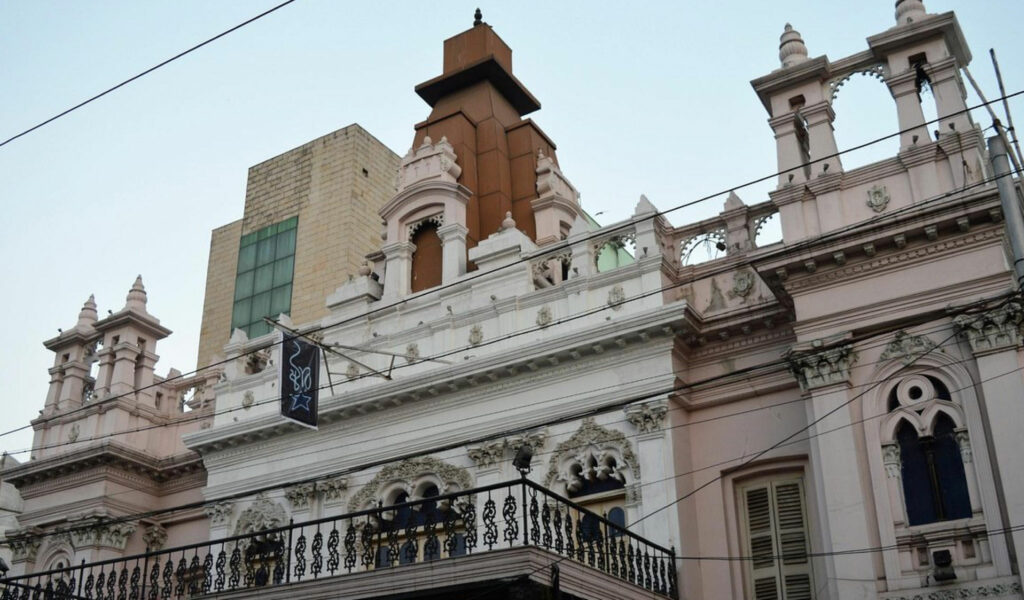
Located in North Kolkata, Hatibagan Market is one of the oldest and most traditional markets in the city. Once famous for its pet shops and exotic birds (which have now been largely phased out), today it thrives as a hub for garments, sarees, jewelry, and household goods.
The market is particularly well-known for affordable sarees and dress materials. Locals often shop here during festivals for traditional wear, and the variety ranges from simple cottons to festive silks. Its narrow lanes are filled with stalls selling everything from imitation jewelry and cosmetics to everyday groceries.
The lively chaos of Hatibagan makes it a quintessential Kolkata experience. Unlike the glossier malls, this market reflects the city’s old-world charm and remains a favorite for budget-conscious shoppers.
•⏰ Timings: 10:00 AM – 9:00 PM (Closed Mondays)
•🎟️ Entry Fee: Free
•💡 Travel Tip: Visit in the afternoon to avoid the heavy morning rush. Bargaining is essential to get the best deals.
Hatibagan may not be glamorous, but it’s one of the most authentic places of interest in Kolkata, especially if you want to see the city shop like a local.
47. Lake Market
Nestled in South Kolkata, near Kalighat, Lake Market is a lively blend of tradition and modernity. It’s a neighborhood favorite, where you’ll find everything under one roof — from fresh vegetables and fruits to clothes, jewelry, and cosmetics.
The covered marketplace is particularly famous for its jewelry stores, offering a wide range of gold, silver, and imitation designs. Shoppers also flock here for sarees and fabrics, while food lovers relish the stalls selling snacks and sweets. The market has a friendly, homely feel compared to the more chaotic New Market or Gariahat.
It’s a great stop if you’re looking for everyday shopping with a local touch, and because it’s less crowded, it’s easier to browse leisurely.
•⏰ Timings: 9:00 AM – 8:00 PM daily
•🎟️ Entry Fee: Free
•💡 Travel Tip: Pair your visit with a trip to nearby Kalighat Temple. Evenings are a good time to experience its lively yet manageable buzz.
Lake Market may not be on every tourist’s itinerary, but it’s a charming tourist place of Calcutta for those who want to see the city’s neighborhood culture.
48. Burrabazar
One of the largest wholesale markets in India, Burrabazar is the beating heart of Kolkata’s commerce. Dating back to the days of the East India Company, this sprawling bazaar is a labyrinth of lanes where everything from spices, textiles, hardware, electronics, and stationery is traded in bulk.
The scale of the market is overwhelming. Each section specializes in different goods — Manohar Das Street for textiles, Posta Bazaar for spices, and Tiretta Bazaar for Chinese food ingredients. Burrabazar also comes alive during festivals, when its lanes are filled with decorations, lights, and shoppers preparing for Durga Puja and Diwali.
For visitors, navigating Burrabazar can be chaotic but exciting. The sheer energy of trade and bargaining reflects Kolkata’s mercantile spirit.
•⏰ Timings: 9:00 AM – 8:00 PM (Closed Sundays)
•🎟️ Entry Fee: Free
•💡 Travel Tip: Go with a local guide if possible. Wear comfortable shoes and be ready for crowds.
Burrabazar is less about leisurely shopping and more about experiencing Kolkata’s raw commercial pulse — a must for curious travelers.
49. Phoolbazar (Mullick Ghat Flower Market)
At the foot of the Howrah Bridge lies the vibrant Mullick Ghat Flower Market, Asia’s largest wholesale flower market. From the crack of dawn, this market bursts with color and fragrance as vendors sell marigolds, roses, orchids, and exotic blooms by the kilo.
The sheer scale is astounding — thousands of sellers and buyers crowd the narrow lanes, carrying garlands on their heads or bundled flowers in baskets. The atmosphere is chaotic yet intoxicating, a photographer’s paradise. The market also plays a key role in supplying flowers for Kolkata’s temples, weddings, and festivals.
•⏰ Timings: 4:00 AM – 9:00 PM daily
•🎟️ Entry Fee: Free
•💡 Travel Tip: Visit early morning (around 5 AM) to see the market at its most vibrant. Wear shoes you don’t mind getting muddy.
For its energy and colors, Phoolbazar is one of the most unforgettable places to see Kolkata.
50. Chandni Chowk Market (Electronics Hub)
Not to be confused with Delhi’s famous bazaar, Kolkata’s Chandni Chowk Market is best known as the city’s electronics hub. Here you’ll find everything from mobile phones and computer accessories to cameras, sound systems, and spare parts.
The market is especially popular with students and tech enthusiasts looking for affordable gadgets and repairs. Bargaining is common, and while prices are lower than in malls, one has to be cautious about authenticity. The narrow lanes also sell clothes, shoes, and budget household items, adding to its eclectic mix.
Though chaotic, it reflects Kolkata’s street-smart shopping culture.
•⏰ Timings: 10:00 AM – 8:00 PM (Closed Sundays)
•🎟️ Entry Fee: Free
•💡 Travel Tip: Always test products before buying and shop at established outlets for reliability.
Chandni Chowk Market may not be glamorous, but it’s a fascinating slice of Kolkata life — one of those Kolkata tour places where locals truly shop.
51. Quest Mall
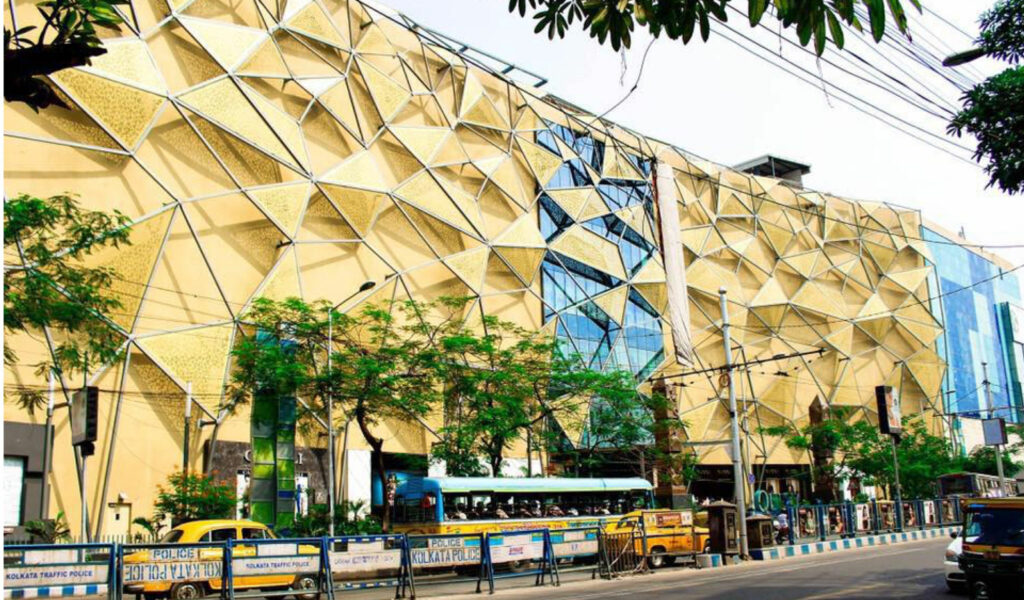
For those who prefer upscale shopping, Quest Mall is Kolkata’s premier luxury shopping destination. Opened in 2013, it houses high-end international brands like Gucci, Emporio Armani, and Burberry alongside popular Indian outlets. The sleek architecture and contemporary interiors make it stand out as a modern landmark in the city.
Beyond shopping, Quest Mall offers fine dining, with restaurants and cafés serving cuisines from around the world. It also has one of the best multiplex cinemas in Kolkata, INOX Insignia, known for its luxurious seating and immersive sound systems. For many residents, Quest Mall isn’t just a shopping stop but an urban lifestyle hub.
•⏰ Timings: 10:00 AM – 9:00 PM daily
•🎟️ Entry Fee: Free
•💡 Travel Tip: Best visited in the evening when the mall is lively. Great spot for both shopping and catching a movie.
Quest Mall is one of the most polished places of interest in Kolkata, reflecting the city’s evolving cosmopolitan side.
52. South City Mall
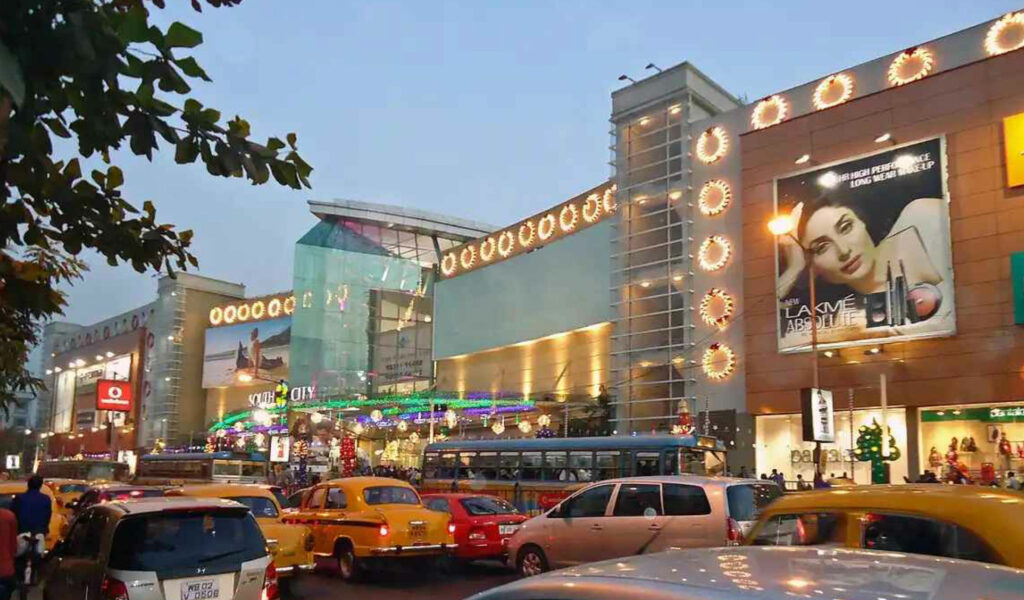
Located on Prince Anwar Shah Road, South City Mall is one of the largest shopping complexes in Eastern India. Opened in 2008, it quickly became a favorite for families and youngsters. With over 150 stores, it offers everything from apparel and accessories to electronics and home décor.
Anchor tenants include Shoppers Stop, Pantaloons, and Spencer’s Hypermarket. The mall also features a multiplex cinema and a massive food court serving global and local cuisines. Its modern design and convenient layout make it a hassle-free shopping destination.
The mall was renovated after a fire incident in 2017, and today it’s better than ever, attracting thousands of shoppers daily.
•⏰ Timings: 10:00 AM – 9:00 PM daily
•🎟️ Entry Fee: Free
•💡 Travel Tip: Perfect for an afternoon of shopping and dining. Visit during festive seasons when the mall is beautifully decorated.
South City Mall showcases modern retail culture, making it a popular tourist place of Calcutta for urban experiences.
53. City Centre (Salt Lake & New Town)
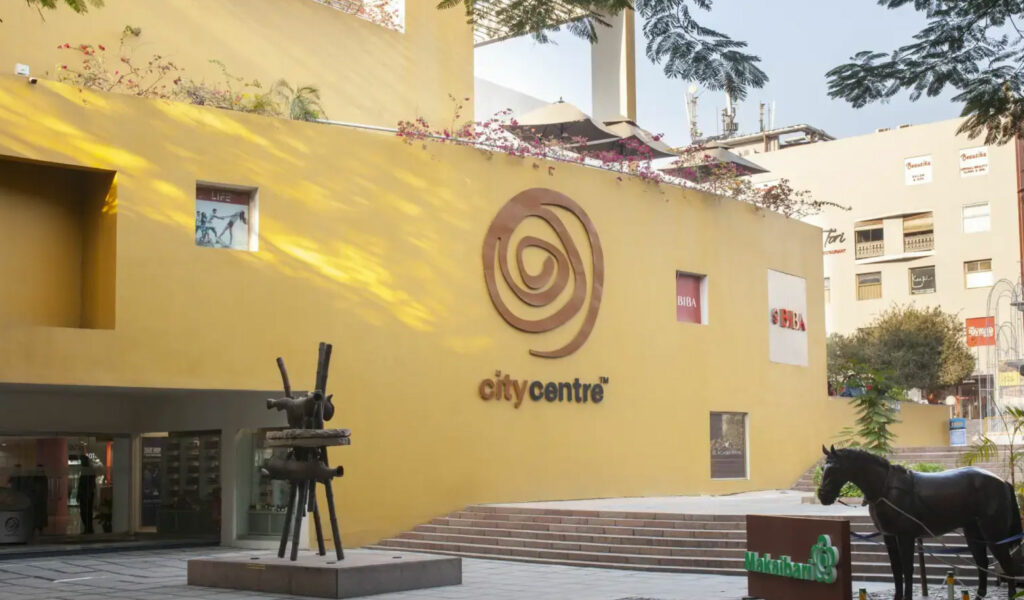
Kolkata boasts two City Centre malls — one in Salt Lake (est. 2004) and another in New Town (est. 2014). Both are unique because they combine the feel of an open-air plaza with modern shopping facilities. Designed by renowned architect Charles Correa, the Salt Lake branch in particular is known for its quirky design with winding alleys, courtyards, and open-air cafés.
City Centre offers a mix of shopping outlets, restaurants, multiplexes, and cultural spaces. It’s as much a hangout spot as it is a retail destination. The open-air concept creates a vibrant atmosphere where students, families, and office-goers spend their evenings.
•⏰ Timings: 10:00 AM – 9:00 PM daily
•🎟️ Entry Fee: Free
•💡 Travel Tip: Visit in the evening for the lively buzz and open-air cafés. Salt Lake’s branch is best for leisure, while New Town’s caters to modern retail.
City Centre is more than a mall — it’s a social hub, one of the most vibrant Kolkata tour places for locals.
54. Kumartuli (Potters’ Colony)
Among the most fascinating places to see in Kolkata, Kumartuli is the traditional potters’ quarter in North Kolkata, famous for crafting clay idols of gods and goddesses. Narrow lanes lined with workshops come alive especially before Durga Puja, when artisans create thousands of idols that are shipped worldwide.
Watching artisans sculpt idols from clay, paint intricate features, and dress them in ornaments is a mesmerizing experience. The blend of devotion and craftsmanship is unmatched. Many photographers and travelers flock here to capture the artistry, especially during August–October.
Even outside festival season, Kumartuli is worth visiting to appreciate the traditional skills that have been passed down generations.
•⏰ Timings: 6:00 AM – 8:00 PM daily
•🎟️ Entry Fee: Free
•💡 Travel Tip: Best visited in the months leading to Durga Puja. Early mornings provide the best chance to watch artisans at work.
Kumartuli is not just a neighborhood — it’s the cultural soul of Kolkata’s biggest festival.
55. Prinsep Ghat
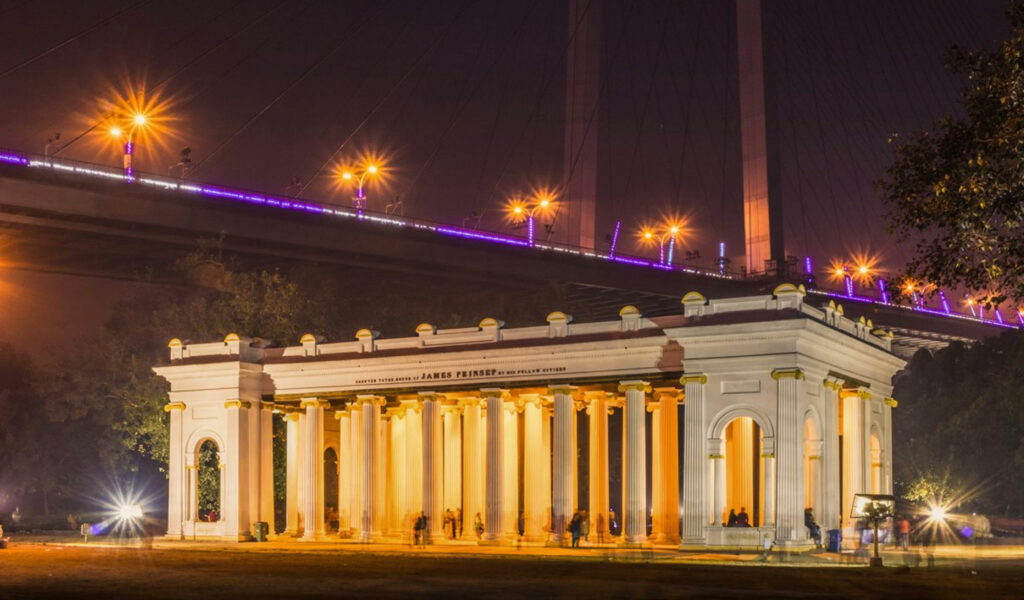
Built in 1841 along the Hooghly River, Prinsep Ghat is one of the most beautiful colonial-era landmarks in Kolkata. The Palladian-style monument, dedicated to James Prinsep, sits against the backdrop of the Vidyasagar Setu, creating one of the most photographed sights in the city.
The ghat is a popular hangout spot for locals, who come here for evening walks, boat rides, and street food. The riverside promenade, recently renovated, features gardens, benches, and food stalls, making it a family-friendly destination. The sight of boats sailing under the illuminated Vidyasagar Setu at night is especially romantic.
Prinsep Ghat also holds historical importance, as it was once a busy jetty for trade and transport. Today, it is one of the most relaxing yet iconic tourist places of Calcutta.
•⏰ Timings: Open all day
•🎟️ Entry Fee: Free; boat rides cost around ₹200–₹500 depending on duration
•💡 Travel Tip: Visit during sunset for magical views. Don’t miss a boat ride for photographs of the illuminated bridge.
Prinsep Ghat is the perfect blend of history, romance, and leisure on Kolkata’s riverfront.
56. Babughat
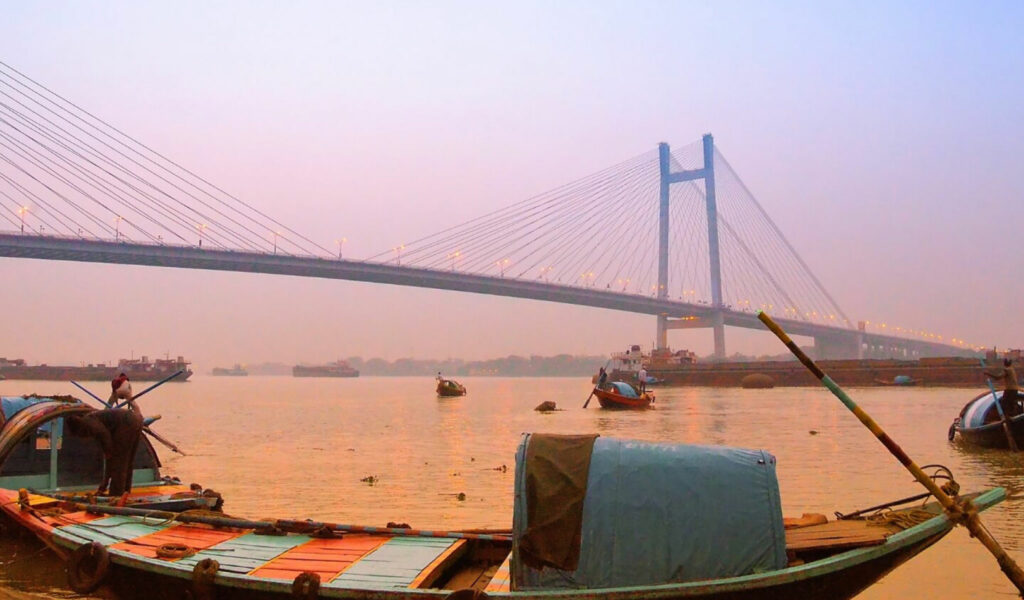
Built in 1830 by Raja Raj Chandra in memory of his wife Rani Bhabani Devi, Babughat is one of the oldest ghats along the Hooghly River. Its colonial-style Doric pillars and wide steps once made it a hub of aristocratic gatherings, and though much of its former glory has faded, it still remains an important landmark.
Today, Babughat is used for daily rituals, ferry rides, and as a major immersion point during Durga Puja. Thousands gather here during the festival to bid farewell to idols, creating a powerful scene of devotion and spectacle. The ghat is also a transport hub, with ferries connecting to Howrah and buses departing to various towns.
Despite its bustling, sometimes chaotic atmosphere, Babughat retains a nostalgic charm. For photographers, it offers a glimpse into Kolkata’s everyday spiritual life along the river.
•⏰ Timings: Open all day
•🎟️ Entry Fee: Free
•💡 Travel Tip: Visit during Durga Puja idol immersion for an unforgettable cultural experience, but expect large crowds.
Babughat may not be as polished as Prinsep Ghat, but it captures the raw, unfiltered essence of Kolkata’s riverfront life.
57. Outram Ghat
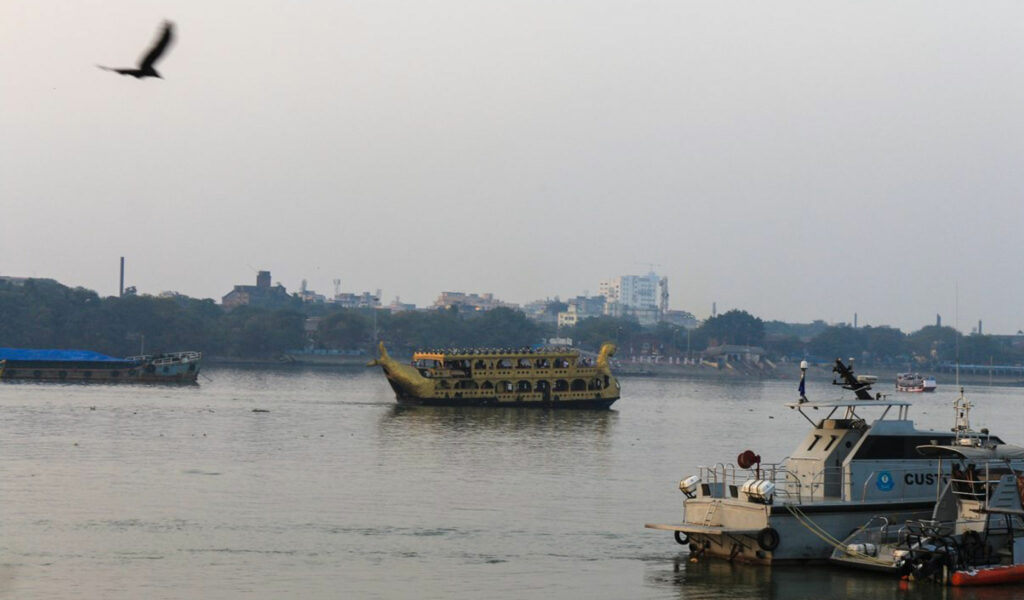
Established in the 19th century and named after Sir James Outram, Outram Ghat is another prominent riverside landmark in Kolkata. Once used by British officials for steamer rides, today it serves as both a religious and recreational hub.
Outram Ghat is particularly famous during festivals like Chhath Puja, when thousands of devotees gather on its steps to offer prayers to the setting and rising sun. Throughout the year, locals visit for ferry rides, casual strolls, and enjoying snacks from food stalls. The ghat also provides fantastic views of the Hooghly, especially at sunset.
Its location near the Howrah Bridge and Millennium Park makes it easy to combine with other riverfront attractions.
•⏰ Timings: Open all day
•🎟️ Entry Fee: Free
•💡 Travel Tip: If you enjoy photography, visit early morning to capture rituals and ferry activity with the bridge in the backdrop.
Outram Ghat is one of the most authentic places to see Kolkata, where faith, history, and daily life meet.
58. South Park Street Cemetery
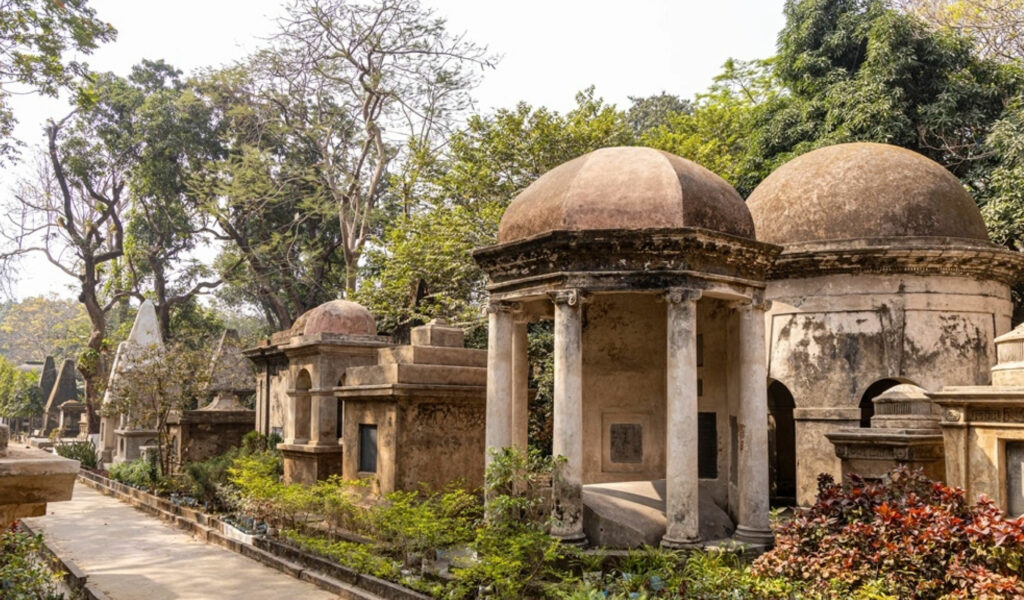
For those drawn to offbeat heritage, the South Park Street Cemetery offers a hauntingly beautiful experience. Established in 1767, it is one of the earliest non-church cemeteries in the world and served as the final resting place for many British officials, soldiers, and residents of colonial Calcutta.
The cemetery is spread across 8 acres, filled with moss-covered tombs, gothic obelisks, domed mausoleums, and elaborate epitaphs. The overgrown trees and quiet atmosphere create a serene yet mysterious setting, making it a favorite for history buffs and photographers. Notable figures buried here include Sir William Jones, the founder of the Asiatic Society.
Restoration efforts in recent years have preserved much of its charm, and the cemetery is now recognized as a heritage site.
•⏰ Timings: 9:00 AM – 5:00 PM daily
•🎟️ Entry Fee: ₹20 (Indians), ₹50 (Foreigners)
•💡 Travel Tip: Visit in the morning for peaceful exploration. Photography permits may be required.
South Park Street Cemetery is one of the most atmospheric places of interest in Kolkata, offering a quiet escape from the city’s chaos.
59. Race Course (Royal Calcutta Turf Club)
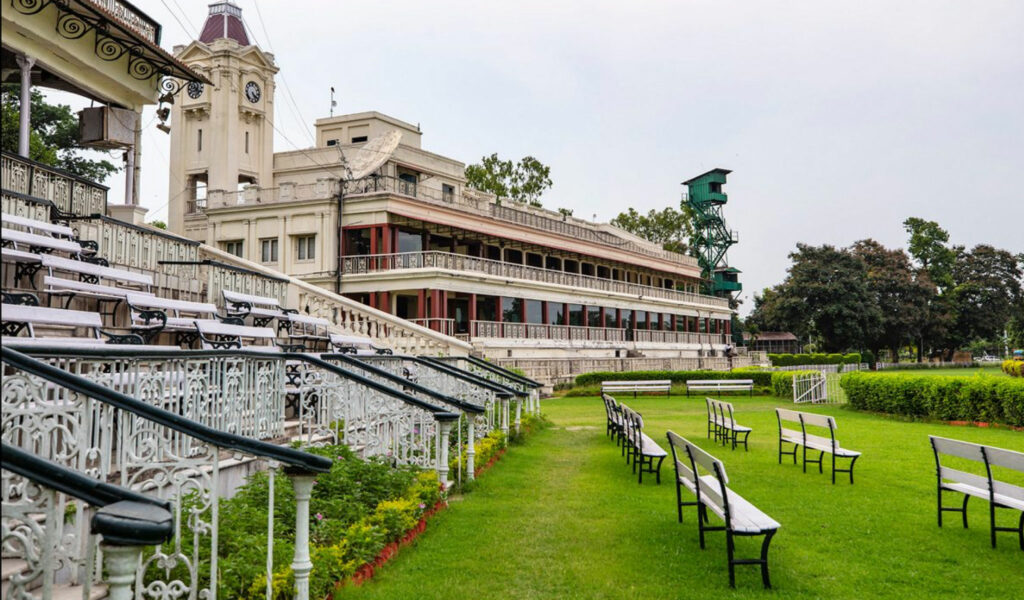
Founded in 1847, the Royal Calcutta Turf Club (RCTC) Race Course is one of the oldest and most prestigious racecourses in India. Once frequented by British elites, it continues to be a vibrant part of Kolkata’s sporting and social life.
The Race Course is famous for hosting thoroughbred horse racing events, especially during the winter season (November to March). Race days attract not just enthusiasts but also socialites and tourists curious about this colonial-era pastime. Even on non-race days, the lush grounds around the course make for pleasant walks and add greenery to the Maidan.
The RCTC has also contributed significantly to the development of polo in India, adding to its historic importance.
•⏰ Timings: Race days usually start at 1:00 PM; check RCTC calendar
•🎟️ Entry Fee: Around ₹20–₹50 for general stands; higher for members’ enclosures
•💡 Travel Tip: If you enjoy heritage sports, attend a winter race day to soak in the atmosphere of old-world glamour.
The Race Course blends sport, heritage, and leisure, making it a unique Kolkata tour place.
60. Star Theatre
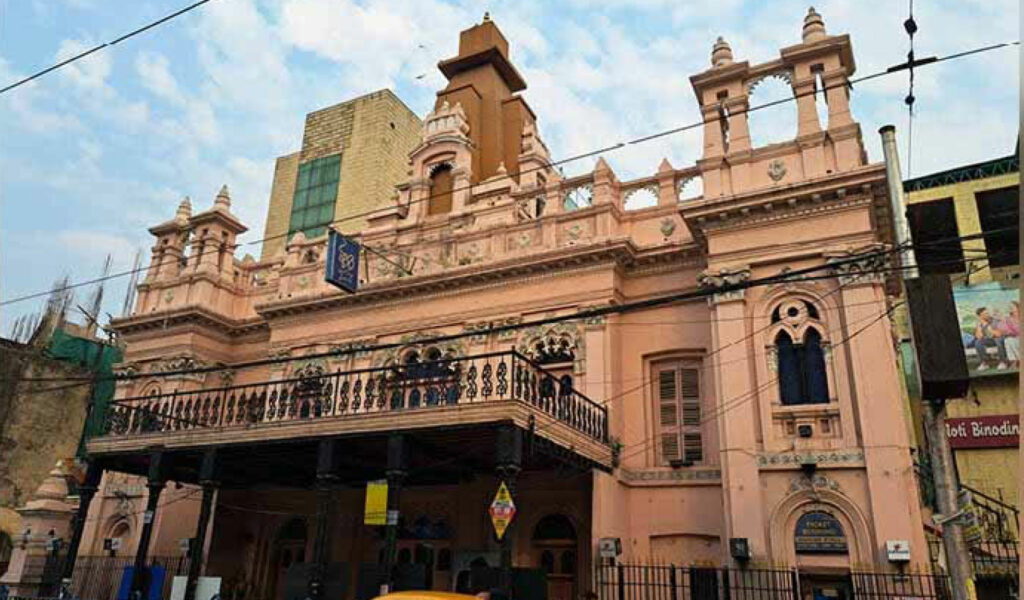
The Star Theatre, built in the late 19th century, is one of Kolkata’s most historic playhouses. Originally a venue for Bengali theatre and cultural performances, it played a central role in nurturing Bengal’s artistic renaissance. Legends such as Girish Chandra Ghosh and Rabindranath Tagore staged works here, and the theatre even hosted the screening of early Indian films.
Though the original structure suffered damage, it was restored and continues to function as a theatre and cinema hall. Today, it showcases Bengali plays, films, and cultural programs, keeping alive its rich tradition.
For culture lovers, attending a performance at Star Theatre is like stepping back into Kolkata’s golden age of theatre.
•⏰ Timings: Varies by performance; box office usually open 10:00 AM – 8:00 PM
•🎟️ Entry Fee: ₹100–₹500 depending on the show
•💡 Travel Tip: Check schedules in advance for Bengali plays or classic film screenings.
Star Theatre remains one of the iconic tourist places of Calcutta, where heritage and art meet on stage.
61. Nandan
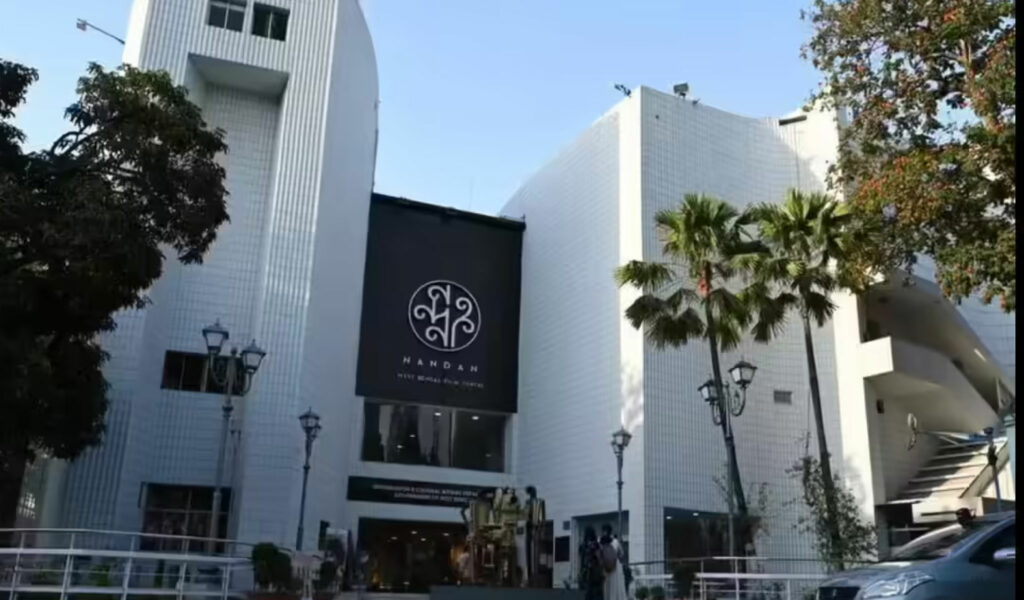
Inaugurated in 1985 by filmmaker Satyajit Ray, Nandan is Kolkata’s premier cultural and film center. More than just a cinema hall, it is a hub for intellectual exchange, independent cinema, and cultural events. The building itself, designed with modernist architecture, symbolizes Kolkata’s progressive spirit.
Nandan is most famous for hosting the Kolkata International Film Festival (KIFF) every year, which attracts global filmmakers, critics, and cinephiles. Throughout the year, it screens art-house films, retrospectives of great directors, and contemporary world cinema that don’t usually make it to commercial theatres.
For students and lovers of cinema, Nandan is more than a theatre — it’s an adda spot. Groups of youngsters gather on its steps to discuss films, politics, and literature, creating an atmosphere buzzing with creativity.
•⏰ Timings: 12:00 PM – 9:00 PM (depends on show schedule)
•🎟️ Entry Fee: ₹30–₹60 for regular shows
•💡 Travel Tip: Check schedules in advance for rare film screenings. The KIFF in November is the best time to visit.
For cinephiles, Nandan is an essential place of interest in Kolkata, where film is celebrated as an art form.
62. Rabindra Sadan
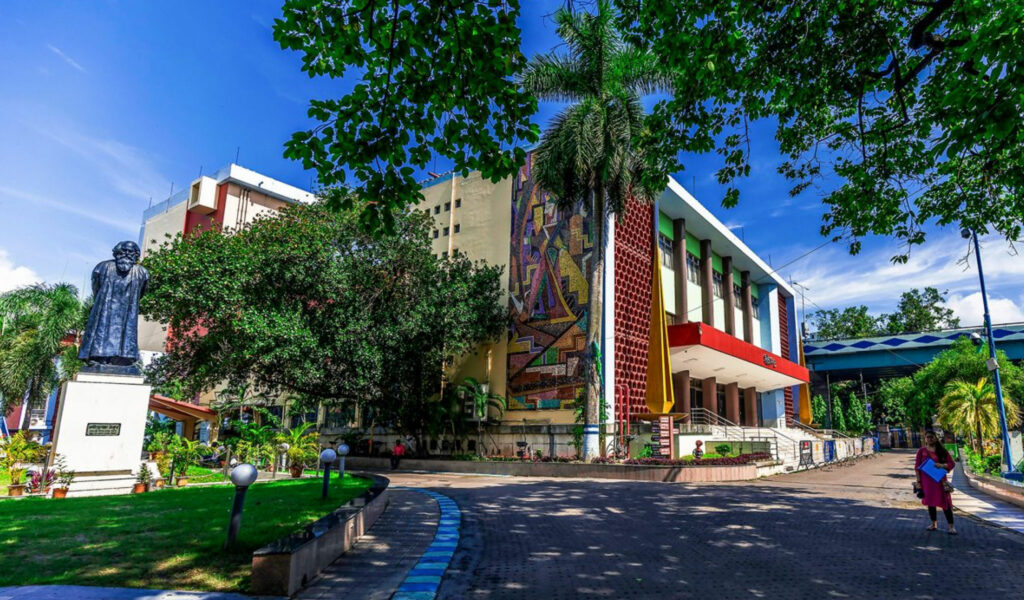
Adjacent to Nandan stands Rabindra Sadan, a cultural complex dedicated to Rabindranath Tagore. Built in 1961, it has become one of the most important venues for theatre, music, and dance performances in the city. Its large auditorium regularly hosts plays, concerts, poetry recitals, and cultural festivals.
Rabindra Sadan is particularly special for Bengali theatre, where both amateur and professional troupes perform regularly. The complex also houses smaller performance spaces and serves as a cultural hub for Kolkata’s creative community.
Visitors interested in experiencing Kolkata’s artistic vibrancy should attend an evening performance here. Even if you don’t understand Bengali, the energy of live theatre and music transcends language.
•⏰ Timings: 2:00 PM – 9:00 PM (depends on performance schedule)
•🎟️ Entry Fee: ₹50–₹300 depending on the show
•💡 Travel Tip: Look up schedules online or at the venue. Arrive early for the best seats.
Rabindra Sadan is not just a venue — it is a celebration of Kolkata’s cultural soul.
63. Mohun Bagan & East Bengal Football Clubs
Football is not just a sport in Kolkata — it’s a passion, a religion, and a way of life. The rivalry between Mohun Bagan Athletic Club (founded in 1889) and East Bengal Club (established in 1920) is legendary, making their stadiums and clubhouses important tourist places of Calcutta.
Mohun Bagan is historically significant as the first Indian club to defeat a British team in 1911, an event celebrated as a nationalist triumph. East Bengal, on the other hand, has a strong identity rooted in the migrant community from East Bengal (now Bangladesh). Together, they define the city’s football culture.
Visitors can tour the club museums, see trophies, and learn about their glorious histories. Attending a derby match at Salt Lake Stadium (Vivekananda Yuba Bharati Krirangan) is an electrifying experience, with tens of thousands of fans cheering passionately.
•⏰ Timings: Clubhouses open 10:00 AM – 5:00 PM (Closed on match days)
•🎟️ Entry Fee: Free for club visits; match tickets vary (₹100–₹500+)
•💡 Travel Tip: If you’re in Kolkata during a derby, don’t miss the match — the atmosphere is unforgettable.
For sports lovers, these clubs are shrines of footballing heritage and integral places of interest in Kolkata.
64. Tram Ride
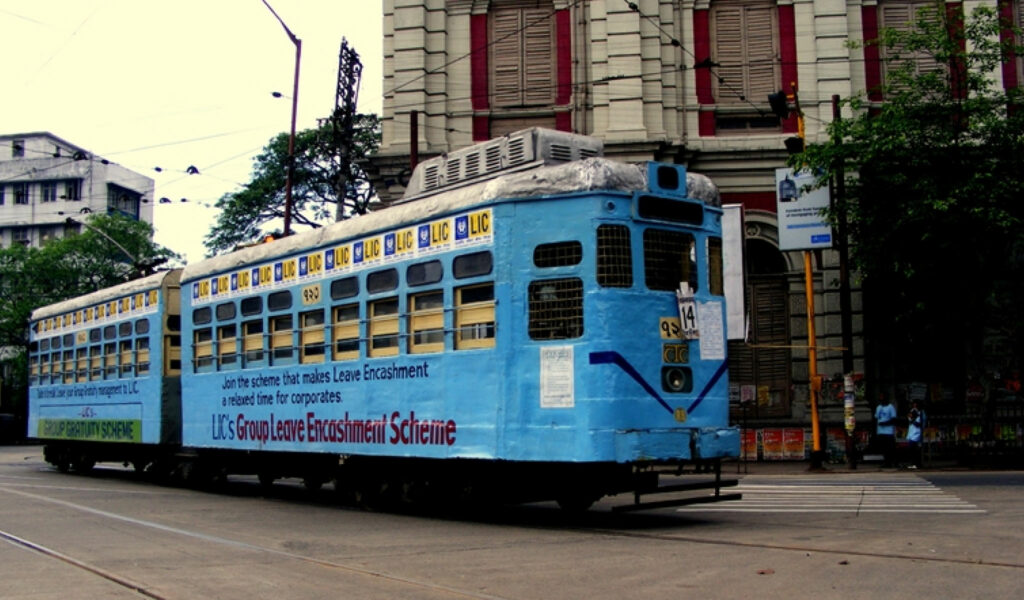
Kolkata is the only city in India that still runs trams, making a ride on them a unique experience. Introduced in 1902, these slow-moving, vintage trams once defined the city’s transport system. Though their network has shrunk, trams still ply on select routes, especially in North Kolkata.
Riding a tram offers a nostalgic glimpse of old Kolkata — wooden seats, clanging bells, and leisurely views of the streets passing by. The trams are also eco-friendly, running on electricity. Recently, heritage-themed trams with art galleries and cafés inside have been introduced, blending nostalgia with creativity.
•⏰ Timings: 6:00 AM – 9:00 PM (routes vary)
•🎟️ Entry Fee: ₹10–₹20 per ride
•💡 Travel Tip: Try the Esplanade to Shyambazar route for the most atmospheric ride through heritage areas.
A tram ride is not just transport — it’s a journey into Kolkata’s living history.
65. Hand-Pulled Rickshaw Ride
Kolkata is one of the last cities in the world where hand-pulled rickshaws still operate. Though controversial, these rickshaws remain part of the city’s identity, especially in older neighborhoods like Bhowanipore, Kalighat, and College Street.
For locals, they are indispensable during monsoon, when narrow lanes get waterlogged, and for short-distance travel through congested alleys. For tourists, riding one is an eye-opening experience — it’s a relic of the colonial past that still survives in modern times.
While debates continue over their existence, hand-pulled rickshaws are deeply embedded in Kolkata’s heritage. Photographers often capture their imagery as symbols of the city’s resilience.
•⏰ Timings: Early morning to late night
•🎟️ Entry Fee: ₹20–₹100 depending on distance
•💡 Travel Tip: Try a short ride in the older quarters to experience this fading tradition.
Though not luxurious, the hand-pulled rickshaw is one of the most authentic and unusual places to see in Kolkata in motion.
66. Chinatown, Tangra
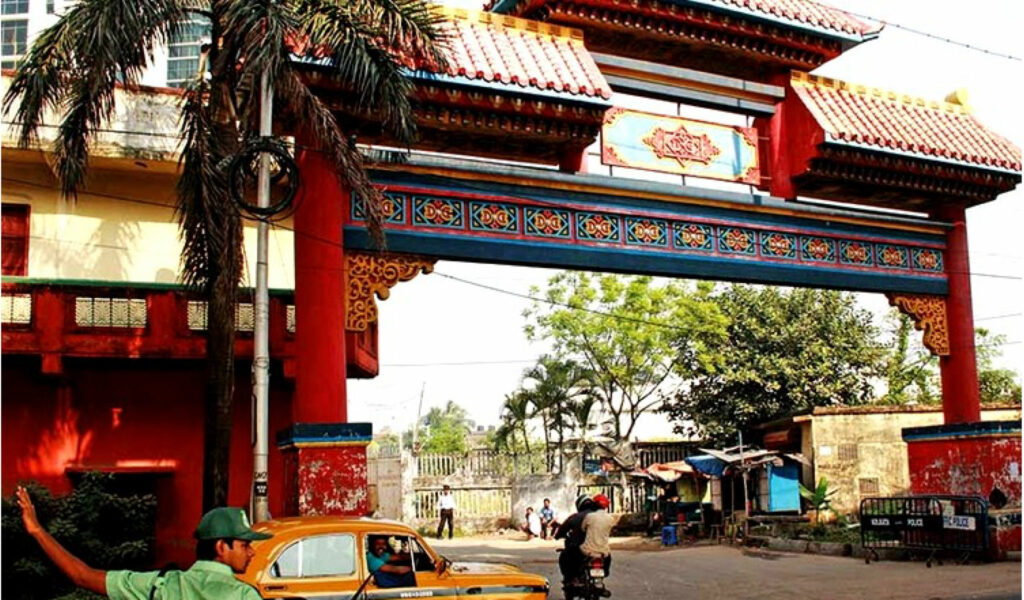
Kolkata is the only Indian city with a Chinatown, and the area of Tangra remains its beating heart. Home to the Chinese community that settled here generations ago, Tangra is most famous for its Chinese restaurants that created the now-iconic “Indian-Chinese” cuisine. Think chili chicken, Hakka noodles, manchurian — all of it started right here.
Walking through Tangra, you’ll find temples with Chinese-style architecture, leather workshops, and eateries tucked into narrow lanes. It’s a fascinating blend of cultures — Indian traditions infused with Chinese influences. Food lovers especially shouldn’t miss it, as Tangra’s restaurants serve everything from momos and dim sums to experimental Indo-Chinese dishes.
•⏰ Timings: Restaurants generally open 11:00 AM – 10:00 PM
•🎟️ Entry Fee: Free
•💡 Travel Tip: Best visited in the evening for dinner; go with an appetite and try at least one family-run restaurant for authentic flavors.
Tangra is one of the most unique places of interest in Kolkata, where cultures merge deliciously.
67. Terreti Bazaar (Old Chinatown)
If you’re looking for an authentic and offbeat food experience, head to Terreti Bazaar early in the morning. Known as the Old Chinatown, this market offers Kolkata’s most unique breakfast scene. From as early as 5:00 AM, vendors set up stalls selling momos, steamed buns, soups, sausages, and even Chinese-style fish ball soups.
The market reflects the culinary heritage of the Chinese community that once thrived here. Though their numbers have dwindled, the flavors remain, and locals flock here for a hearty breakfast. The market also sells fresh produce, spices, and everyday goods, adding to its lively atmosphere.
•⏰ Timings: 5:00 AM – 8:30 AM daily
•🎟️ Entry Fee: Free
•💡 Travel Tip: Arrive before 7 AM for the best variety of food. Bring cash and an adventurous appetite.
Terreti Bazaar is an unforgettable culinary adventure — one of the most authentic tourist places of Calcutta for foodies.
68. Nahoum’s Jewish Bakery
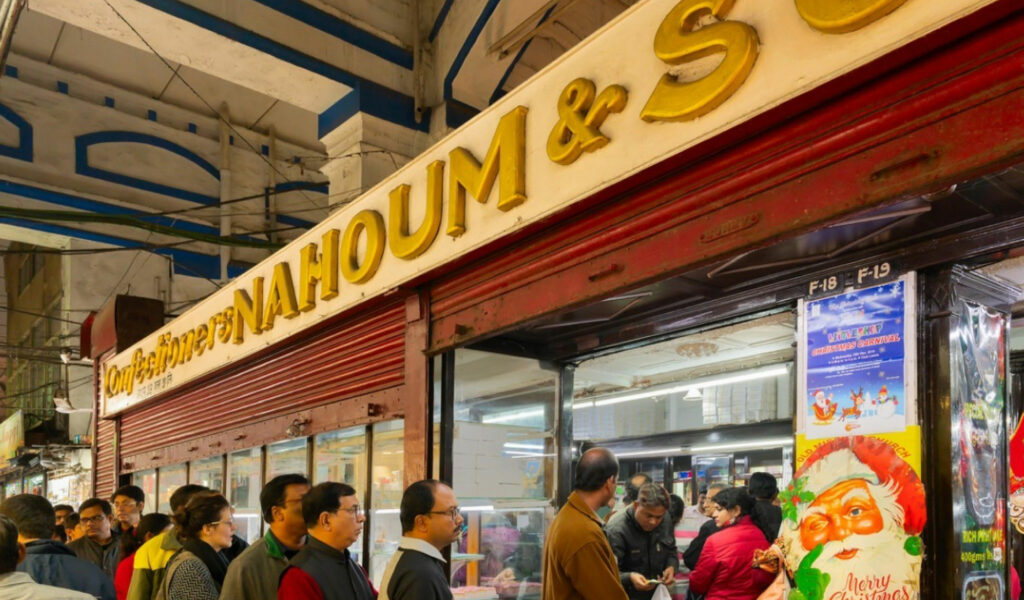
Located in New Market, Nahoum & Sons is a legendary Jewish bakery established in 1902. For over a century, it has been delighting Kolkatans with its cakes, pastries, biscuits, and brownies. Run by the Nahoum family for generations, the bakery has preserved its old-world charm with wooden counters, glass displays, and recipes that haven’t changed in decades.
Its Christmas fruit cakes are especially famous, drawing queues that stretch across the market in December. Other popular items include brownies, rum balls, and almond tarts. Stepping into Nahoum’s feels like stepping back in time, as it preserves the legacy of Kolkata’s once-thriving Jewish community.
•⏰ Timings: 9:00 AM – 8:00 PM (Closed Sundays)
•🎟️ Entry Fee: Free (Pay for baked goods; pastries ₹30–₹100)
•💡 Travel Tip: Visit during Christmas season for the festive vibe, but go early to avoid long queues.
Nahoum’s is more than a bakery — it’s a delicious slice of Kolkata’s multicultural heritage.
69. Botanic Garden Boat Ride
While the Indian Botanic Garden is already famous for the Great Banyan Tree, one of its most overlooked experiences is the boat ride on its central lake. The serene waters, surrounded by rare trees and exotic plants, make it one of the most peaceful escapes in the city.
The boat ride provides stunning views of the sprawling garden and is especially refreshing during the winter months when migratory birds can often be spotted. For couples, families, or solo travelers, this ride offers a quiet pause from the city’s bustle.
•⏰ Timings: 10:00 AM – 5:00 PM (Closed Mondays)
•🎟️ Entry Fee: ₹20 (Garden); Boat ride extra charges (~₹50–₹100 per person)
•💡 Travel Tip: Combine the boat ride with a visit to the Great Banyan Tree. Visit in the morning for cooler weather.
The boat ride makes the Botanic Garden more than just a walk — it’s a complete natural retreat.
70. Santosh Mitra Square
In North Kolkata, Santosh Mitra Square is best known for its spectacular Durga Puja pandals. Every year, the committee here creates elaborate themes, ranging from recreations of famous temples to artistic social messages. In 2017, it even hosted a pandal modeled after the Buckingham Palace!
During Puja, thousands flock here to witness the creativity and devotion on display. Outside the festival season, the square is a lively neighborhood space where locals gather, play, and socialize. But it’s truly during Puja that Santosh Mitra Square transforms into one of the most visited places of interest in Kolkata.
•⏰ Timings: Open all day; best during Durga Puja (September–October)
•🎟️ Entry Fee: Free
•💡 Travel Tip: Visit at night during Puja when the pandal is illuminated. Weekdays are less crowded than weekends.
Santosh Mitra Square is a cultural landmark, embodying Kolkata’s passion for art, festivity, and faith.
71. Kumartuli Ghat
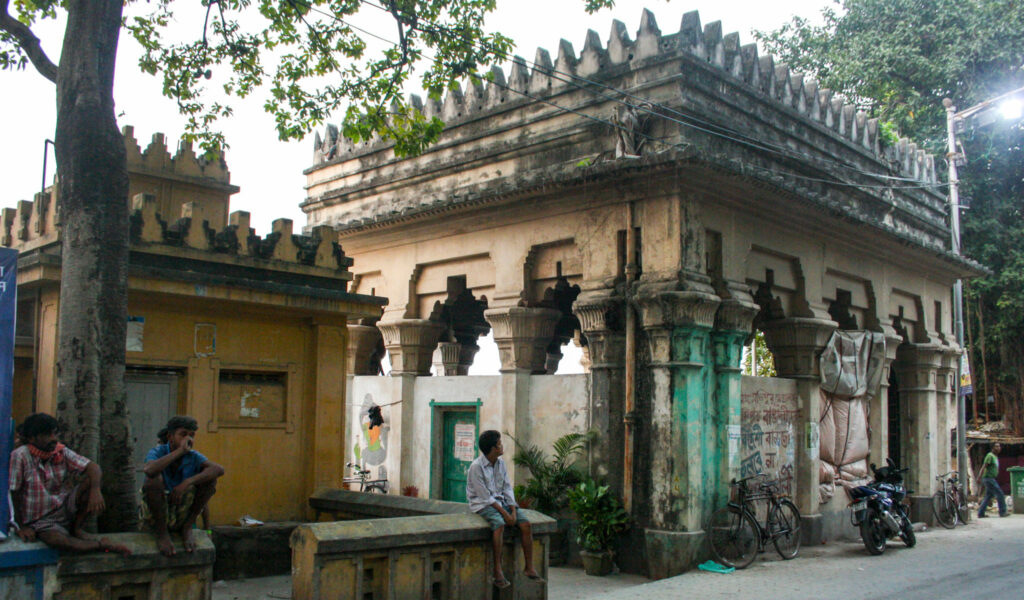
While Kumartuli is famous as the potters’ quarter, the nearby Kumartuli Ghat along the Hooghly River plays an equally important cultural role. This ghat is the main site where clay idols crafted in Kumartuli are immersed during Durga Puja. Watching the grand processions of idols arriving here, carried on trucks or carts, accompanied by dhakis (drummers), and then lowered into the river, is a deeply emotional and photogenic experience.
Beyond Puja, Kumartuli Ghat is a serene riverside spot where locals bathe, pray, and relax. Its rustic charm and cultural importance make it one of the most atmospheric places of interest in Kolkata.
•⏰ Timings: Open all day
•🎟️ Entry Fee: Free
•💡 Travel Tip: Visit during Durga Puja immersion days for the most powerful experience, but arrive early to avoid overwhelming crowds.
For travelers, Kumartuli Ghat is where art, faith, and the river converge.
72. College Street Coffee House Adda
Though already mentioned, the adda culture at Indian Coffee House on College Street deserves special attention. More than just sipping coffee, “adda” here is about hours of informal discussions — ranging from politics and philosophy to poetry and films. Generations of intellectuals, students, and writers have made this their meeting ground, shaping Kolkata’s identity as the “City of Ideas.”
The charm lies in its unchanged ambiance — high ceilings, old waiters in traditional uniforms, simple wooden chairs, and the smell of endless cups of coffee. Even if you’re a visitor, joining an adda here gives you a glimpse of Kolkata’s cultural heartbeat.
•⏰ Timings: 9:00 AM – 9:00 PM
•🎟️ Coffee: Around ₹25, snacks ₹50–₹100
•💡 Travel Tip: Visit in the evening when the adda spirit is at its liveliest. Don’t rush — sit back and soak it in.
The Coffee House is not just a café, but an institution — a must-visit tourist place of Calcutta.
73. Terreti Bazaar Immersion Spot
While Terreti Bazaar is famous for food, it also has significance as part of Kolkata’s old Chinatown, where the Chinese-Indian community once thrived. Beyond the morning market, this area becomes culturally significant during Chinese festivals like the Chinese New Year and the Dragon Boat Festival, when locals gather for celebrations and rituals.
Though small, this immersion into Kolkata’s multicultural side makes Terreti Bazaar a hidden gem. It’s a reminder that Kolkata has always been a melting pot of communities — from Armenians and Jews to Chinese and Anglo-Indians.
•⏰ Timings: Morning market 5:00 AM – 8:30 AM; festivals vary
•🎟️ Entry Fee: Free
•💡 Travel Tip: If possible, visit during Chinese New Year for lion dances and festive food.
Terreti Bazaar is a window into Kolkata’s layered identity, making it a one-of-a-kind place to see in Kolkata.
74. Barrackpore
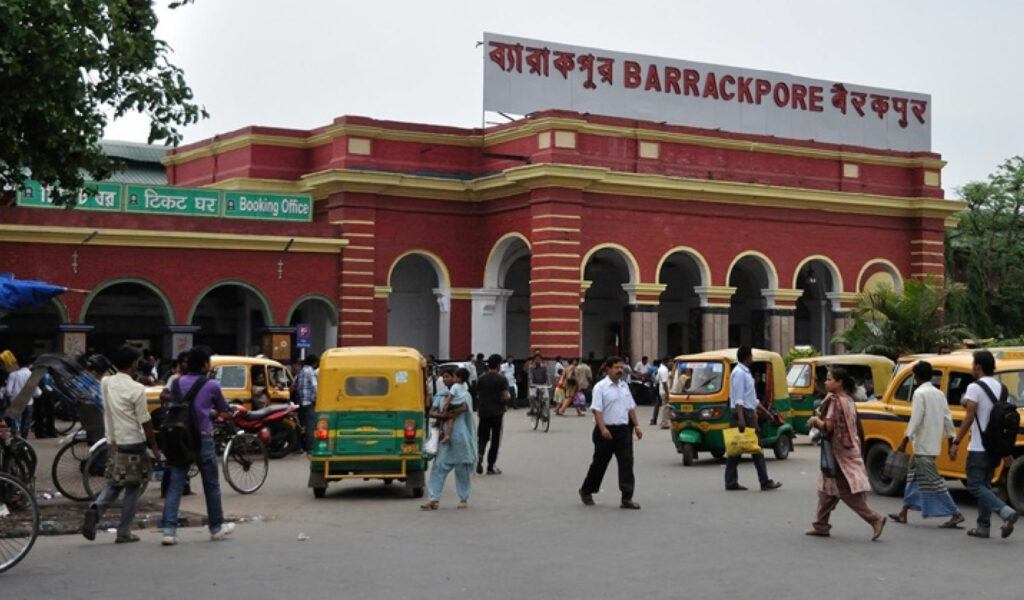
About 30 km from central Kolkata, Barrackpore is a historic town that played a major role in India’s freedom struggle. It was here that Mangal Pandey fired the shot that sparked the 1857 uprising, making it a landmark of nationalist history.
Key attractions include Mangal Pandey Park, with its memorial statue, and Gandhi Ghat, dedicated to Mahatma Gandhi, where his ashes were immersed. The town also houses colonial-era churches, barracks, and heritage buildings.
Easily accessible by road and suburban trains, Barrackpore makes for a perfect half-day trip from Kolkata.
•⏰ Timings: Open all day (parks 6:00 AM – 8:00 PM)
•🎟️ Entry Fee: Free
•💡 Travel Tip: Visit Gandhi Ghat during evening aarti for a peaceful riverside experience.
Barrackpore is one of the most significant Kolkata tour places beyond the city, linking heritage and patriotism.
75. Chandannagar
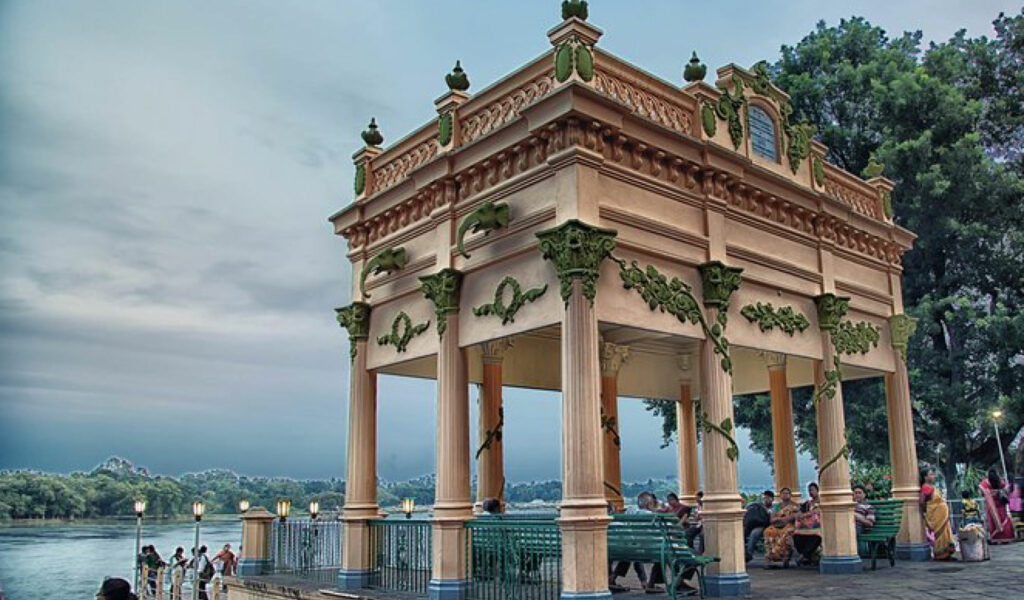
A former French colony located 37 km from Kolkata, Chandannagar offers a unique mix of European heritage and Bengali culture. The French ruled this town until 1950, and their influence remains visible in the elegant colonial buildings, churches, and riverfront.
The Chandannagar Strand, with its shaded promenade along the Hooghly, is a favorite spot for leisurely walks. Other highlights include the Sacred Heart Church, the French Institute, and the Chandannagar Museum. The town is also famous for its Jagaddhatri Puja, celebrated with grandeur and artistry.
•⏰ Timings: Open all day; museums 10:00 AM – 5:00 PM (closed Mondays)
•🎟️ Entry Fee: Free (museum ₹10–₹20)
•💡 Travel Tip: Best visited in the evening for a sunset stroll along the Strand.
Chandannagar is a charming place of interest near Kolkata, offering a French twist to Bengal’s heritage.
76. Serampore
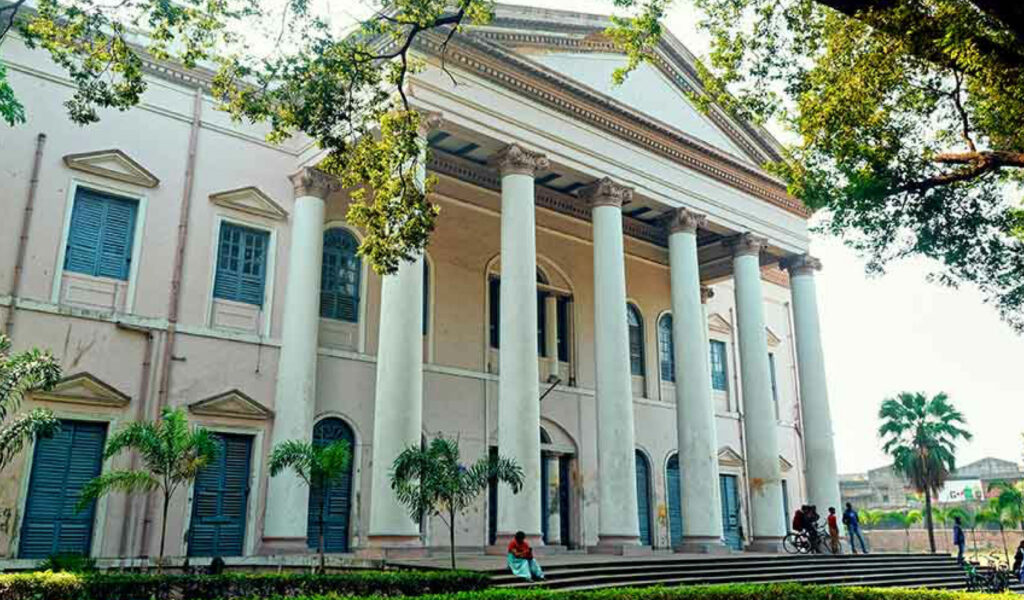
Once a Danish colony, Serampore (about 25 km from Kolkata) offers a fascinating slice of European history in Bengal. The Danes ruled here from 1755 to 1845, leaving behind churches, schools, and civic buildings. Today, Serampore is known for its Serampore College, founded in 1818, which remains one of the oldest continuously operating institutions in India.
The St. Olav’s Church, also called the Danish Church, is a must-visit for its colonial charm and quiet ambiance. Recently restored, it reflects the elegant simplicity of Danish architecture. Walking along the riverfront, you’ll also spot remnants of warehouses and colonial houses that tell stories of the town’s past.
•⏰ Timings: Open all day; church 7:00 AM – 5:00 PM
•🎟️ Entry Fee: Free
•💡 Travel Tip: Combine with Chandannagar for a French–Danish heritage day trip.
Serampore is one of the lesser-known but highly rewarding places of interest near Kolkata for heritage lovers.
77. Bawali Rajbari
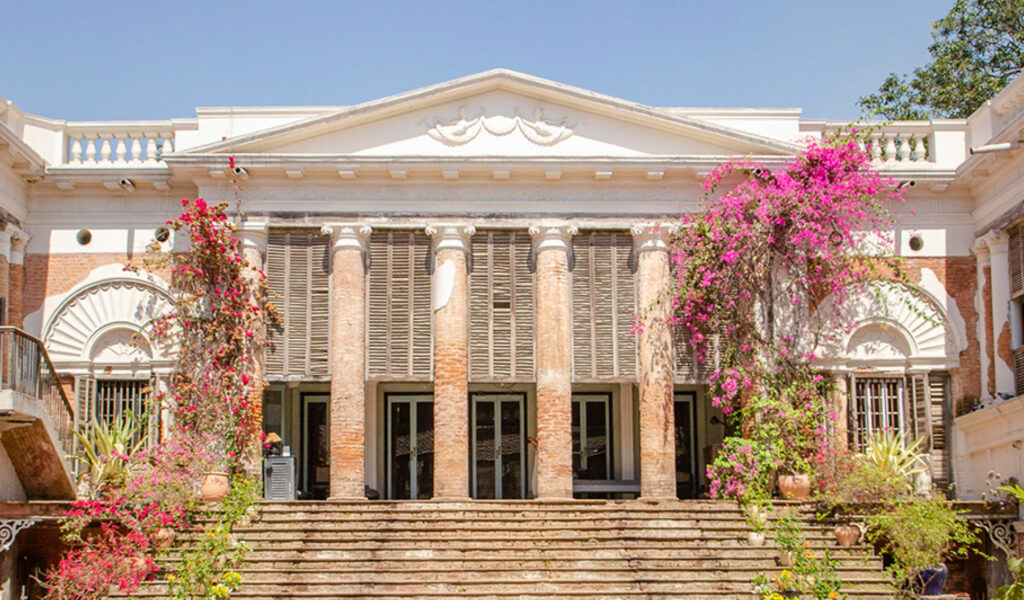
For those who want to experience aristocratic Bengal, the Bawali Rajbari, located about 35 km from Kolkata, is a restored 250-year-old mansion once owned by the Mondal family. The rajbari has been beautifully converted into a boutique heritage resort, giving visitors a chance to relive the grandeur of Bengal’s zamindars.
With its sprawling courtyards, towering columns, antique furniture, and lush gardens, Bawali Rajbari feels like stepping back in time. Guests can stay overnight, enjoy traditional Bengali meals, and explore the nearby villages. Even a day visit is rewarding, as the mansion exudes heritage charm and cultural authenticity.
•⏰ Timings: Open for day visits and overnight stays (booking required)
•🎟️ Entry Fee: Depends on packages (~₹1,000–₹2,500 for day visit with meals)
•💡 Travel Tip: Book in advance, especially during weekends. Perfect for a short getaway.
Bawali Rajbari is one of the most immersive Kolkata tour places, where history and hospitality blend seamlessly.
78. Shibpur Botanic Suburbs
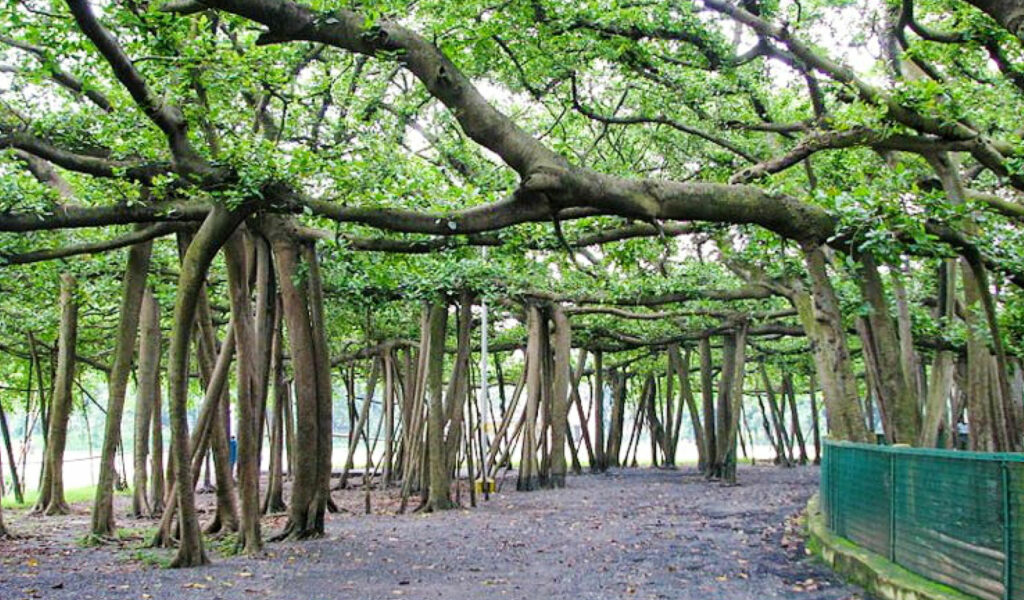
While the Indian Botanic Garden in Shibpur is famous for its Great Banyan, the surrounding Shibpur suburbs are also worth exploring. This quieter neighborhood across the Hooghly River offers glimpses of colonial-era villas, old temples, and leafy avenues.
The area is particularly attractive for those who enjoy walking tours — less crowded than central Kolkata but equally rich in heritage. Many heritage enthusiasts combine a Botanic Garden visit with strolls through Shibpur’s neighborhoods, capturing old Bengal’s essence.
•⏰ Timings: Open all day (Botanic Garden 10:00 AM – 5:00 PM, closed Mondays)
•🎟️ Entry Fee: Garden ₹20–₹100 depending on nationality
•💡 Travel Tip: Best visited in the morning, followed by a ferry ride back to central Kolkata.
Shibpur is an underrated place to see Kolkata’s colonial and natural history in harmony.
79. Belur Math Ferry Ride
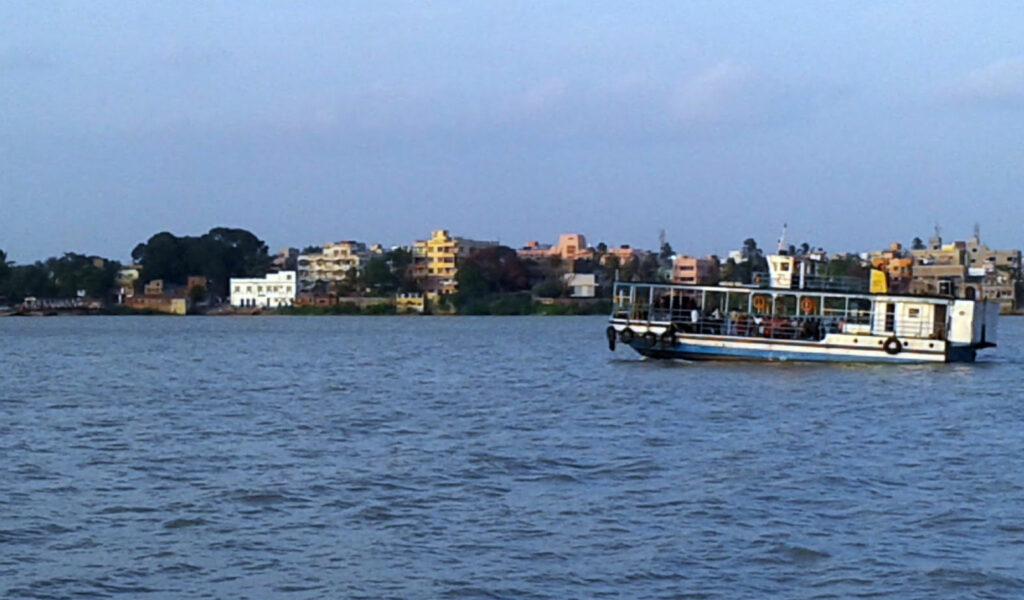
While Belur Math itself is one of Kolkata’s most important spiritual landmarks, the ferry ride from Dakshineswar to Belur Math is an experience in its own right. The ride across the Hooghly River offers sweeping views of both temple complexes, as well as glimpses of riverside life.
The ferries are affordable, frequent, and give visitors a chance to travel the way locals do. Watching the sunset from the boat, with the river turning golden and the temples glowing in soft light, is magical.
•⏰ Timings: 6:00 AM – 8:00 PM (every 15–20 minutes)
•🎟️ Entry Fee: ₹10–₹20 per person
•💡 Travel Tip: Take the ferry around 5 PM to catch sunset views. Avoid peak commuter hours for a calmer ride.
The Belur Math ferry is not just transport — it’s a spiritual and scenic journey, a must-do tourist place of Calcutta experience.
80. Eco Park Tram Museum
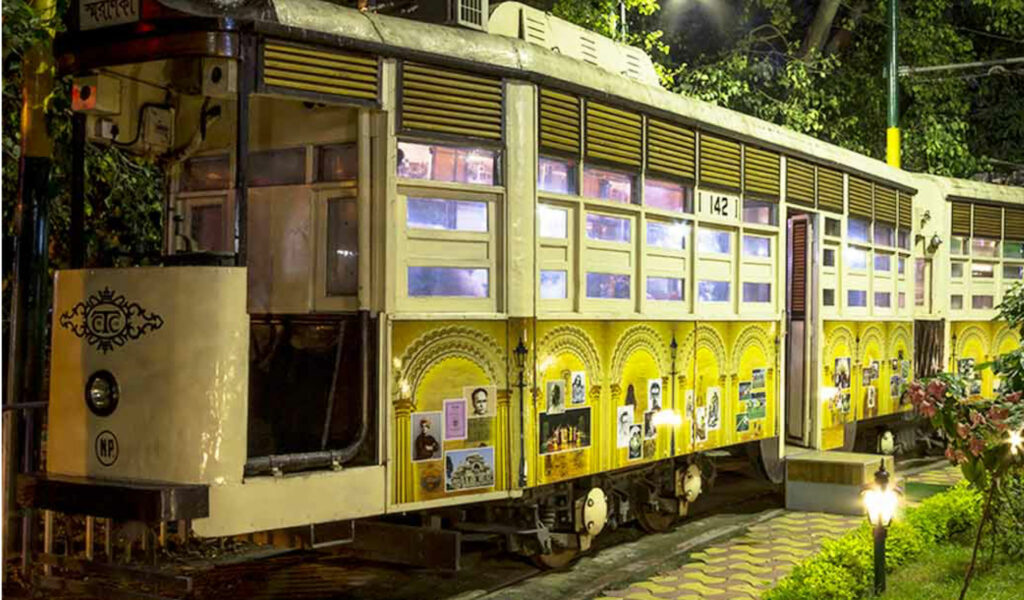
Inside New Town’s Eco Park, visitors can also enjoy the Tram Museum, a tribute to Kolkata’s iconic tram system. The museum is housed inside refurbished tramcars, where displays narrate the history of trams in the city, their evolution, and their enduring cultural significance.
Beyond the exhibits, sitting inside these vintage trams lets you feel the nostalgia of Kolkata’s past. Kids and adults alike enjoy exploring the tram interiors, while history lovers appreciate the old photographs and models. Since Eco Park itself is a full-day destination, the Tram Museum adds a unique educational stop to the itinerary.
•⏰ Timings: 2:30 PM – 8:30 PM (Closed Mondays, same as Eco Park)
•🎟️ Entry Fee: Included in Eco Park entry (₹30 per person)
•💡 Travel Tip: Visit in the evening when Eco Park is illuminated, and check out the tram museum before enjoying boating or cycling.
The Tram Museum is a quirky but memorable addition to the list of places to see in Kolkata, celebrating the city’s timeless character.
81. Nakhoda Masjid
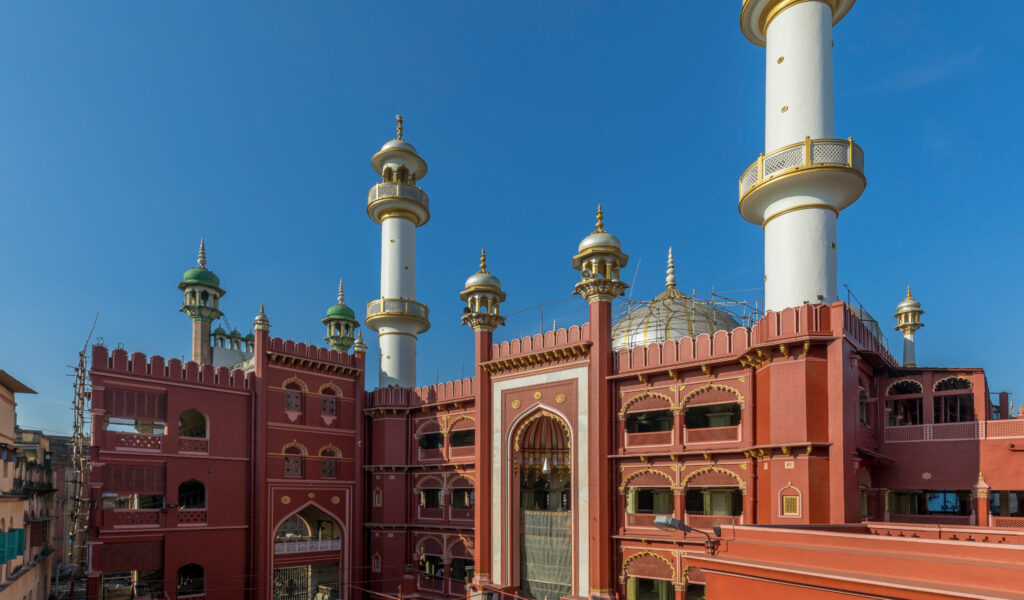
The Nakhoda Masjid, located in the Burrabazar area, is the largest mosque in Kolkata and one of the most impressive Islamic structures in Eastern India. Built in 1926 by Abdur Rahim Osman, a Kutchi Memon merchant, the mosque’s design was inspired by the Mughal architectural style of the Fatehpur Sikri Jama Masjid.
With its striking red sandstone façade, 46-meter-high central dome, and towering minarets, the mosque is a majestic landmark. The name “Nakhoda” means “mariner,” reflecting the community of seafaring merchants who funded its construction. Inside, the prayer hall can accommodate over 10,000 worshippers at a time.
Visitors are welcome outside prayer hours, and the mosque’s grandeur, combined with the vibrant atmosphere of the surrounding Burrabazar, makes it a fascinating stop.
•⏰ Timings: 6:00 AM – 8:00 PM daily
•🎟️ Entry Fee: Free
•💡 Travel Tip: Dress modestly and visit outside Friday prayers for a calmer experience.
Nakhoda Masjid is one of the most striking places of interest in Kolkata, embodying both faith and community pride.
82. Armenian Church of the Holy Nazareth
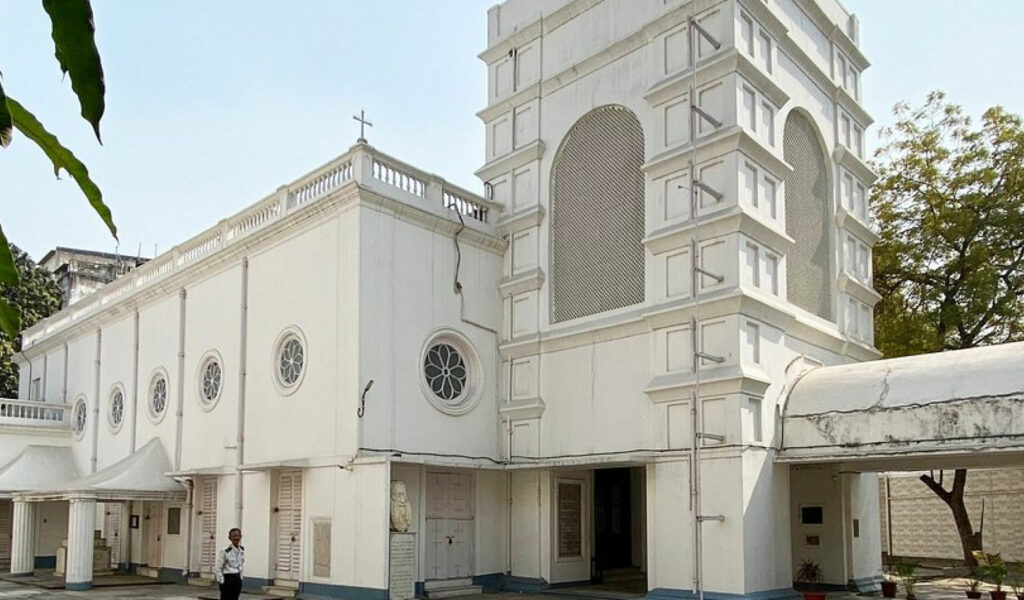
Hidden in the busy lanes of Burrabazar, the Armenian Church of the Holy Nazareth is the oldest Christian church in Kolkata, dating back to 1724. Built for the Armenian trading community that once thrived in the city, the church is a serene oasis amidst the chaos.
The whitewashed building, with its tall spire and peaceful courtyard, exudes old-world charm. Inside, you’ll find elegant wooden pews, oil paintings, and memorial plaques that tell stories of Armenian merchants and settlers. The adjoining graveyard is equally historic, with tombstones dating back centuries.
Even though the Armenian community in Kolkata has dwindled, the church is still active and beautifully maintained. It offers a unique glimpse into a lesser-known chapter of the city’s multicultural past.
•⏰ Timings: 9:00 AM – 2:00 PM daily
•🎟️ Entry Fee: Free
•💡 Travel Tip: Best visited in the morning when the church is quiet and filled with natural light.
The Armenian Church is an underrated gem among Kolkata tour places, blending history, faith, and serenity.
83. St. Paul’s Cathedral
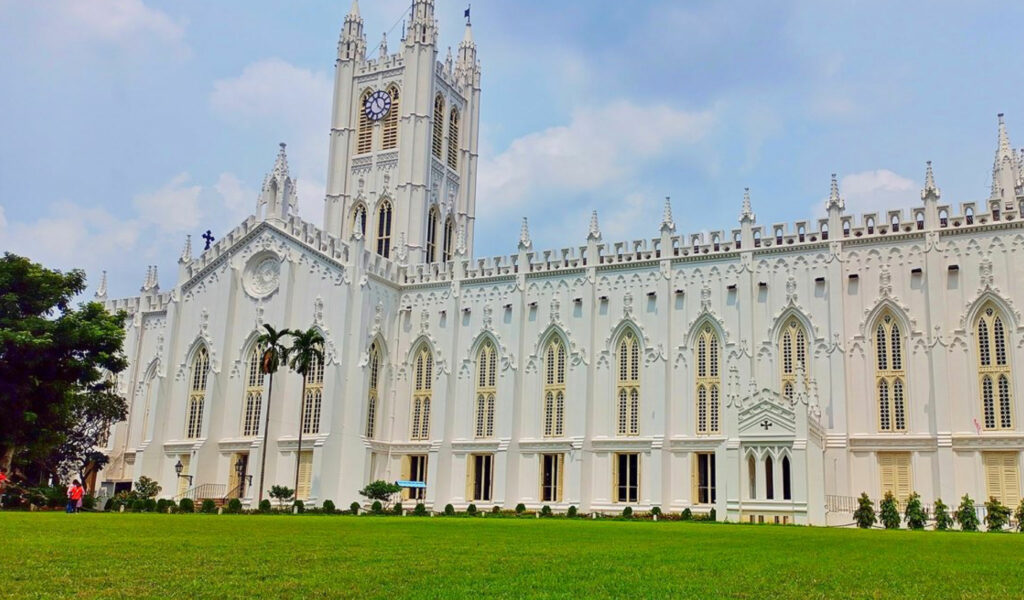
One of Kolkata’s most iconic landmarks, St. Paul’s Cathedral stands as a symbol of the city’s colonial past and spiritual diversity. Completed in 1847, it was the first Anglican cathedral built in the Eastern world. Designed in Gothic Revival style with Indo-Gothic elements, the cathedral’s spire once dominated the skyline.
Inside, the stained-glass windows, high vaulted ceilings, and intricately carved wooden pews create a sense of solemn grandeur. The cathedral is also known for its memorial tablets, which commemorate British officers and missionaries. During Christmas, the cathedral comes alive with festive services and decorations, attracting both locals and tourists.
•⏰ Timings: 9:00 AM – 12:00 PM & 3:00 PM – 6:00 PM daily
•🎟️ Entry Fee: Free
•💡 Travel Tip: Visit during Christmas season for carol services and festive charm.
St. Paul’s Cathedral is one of the most famous places to see Kolkata, blending spirituality with architectural beauty.
84. St. John’s Church
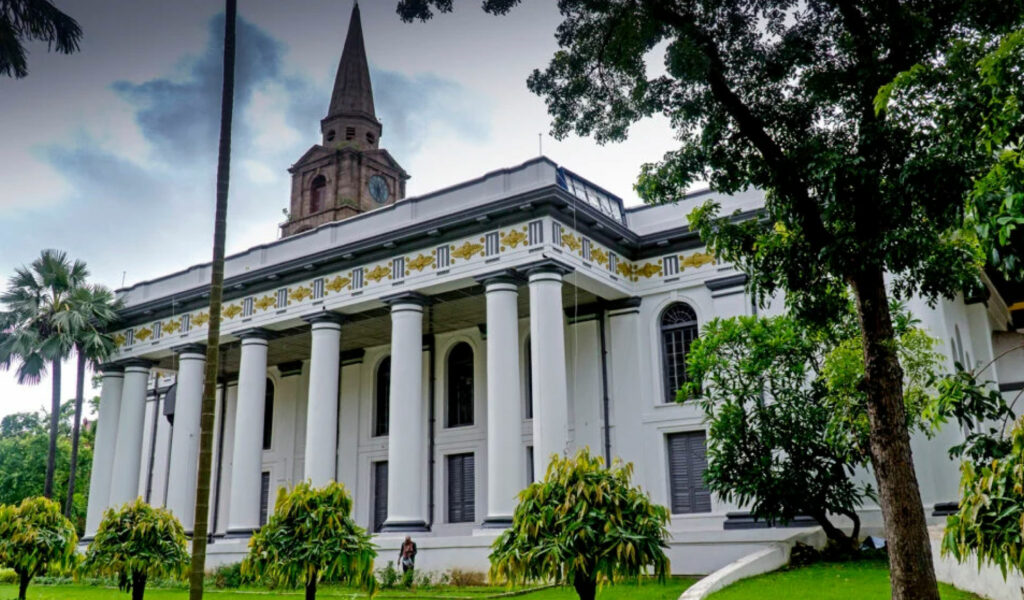
Built in 1787, St. John’s Church is one of Kolkata’s oldest churches and was once the city’s Anglican cathedral before St. Paul’s took over. Constructed using stone and bricks from the ruins of Gaur, the church is known locally as the “Stone Church.”
The interiors feature beautiful stained-glass windows and memorial tablets. One of its most significant features is the memorial to the victims of the Black Hole Tragedy of 1756, as well as the tomb of Job Charnock, often credited as the founder of Kolkata.
Its location in the heart of the city makes it a convenient stop for those exploring the Dalhousie heritage area.
•⏰ Timings: 10:00 AM – 5:00 PM daily
•🎟️ Entry Fee: ₹10
•💡 Travel Tip: Combine with a heritage walk around Lal Dighi, Writers’ Building, and the GPO.
St. John’s Church offers a fascinating peek into Kolkata’s colonial and religious history.
85. Greek Orthodox Church
The Greek Orthodox Church of the Holy Transfiguration, located on Amherst Street, is one of Kolkata’s most unusual religious landmarks. Built in 1925, it served the Greek community that once lived and traded in the city.
Though small, the church is architecturally striking, with its pale yellow façade, bell tower, and serene interiors. Inside, traditional Greek icons and paintings adorn the altar, creating a distinct atmosphere compared to other churches in the city.
Though the Greek population has nearly vanished, the church is still maintained and occasionally used for services, making it a unique testament to Kolkata’s cosmopolitan past.
•⏰ Timings: By appointment; usually open on Sundays
•🎟️ Entry Fee: Free
•💡 Travel Tip: Best visited as part of a heritage walk through Central Kolkata’s multicultural landmarks.
The Greek Orthodox Church is one of the hidden places of interest in Kolkata, adding to the city’s global cultural mosaic.
86. Beth El Synagogue
The Beth El Synagogue, located on Pollock Street in central Kolkata, is one of the most beautiful remnants of the city’s once-thriving Jewish community. Built in 1856 by David Joseph Ezra, it served the Baghdadi Jews who had settled in Kolkata and played a significant role in trade and commerce.
The synagogue is a stunning example of colonial-era architecture with Jewish motifs. Its exterior is marked by tall Corinthian columns, while inside, the marble floors, stained-glass windows, and chandeliers create a serene yet majestic space. The wooden ark, containing the Torah scrolls, is the focal point of worship.
Although the Jewish population in Kolkata has dwindled, Beth El remains an active synagogue, and services are still held occasionally. Visitors are welcome with prior permission.
•⏰ Timings: 9:00 AM – 5:00 PM (Closed Saturdays and Jewish holidays)
•🎟️ Entry Fee: Free
•💡 Travel Tip: Carry valid ID for entry. Photography may be restricted inside.
Beth El Synagogue is one of the most remarkable places of interest in Kolkata, offering a glimpse into a lesser-known cultural legacy.
87. Magen David Synagogue
The grandest of Kolkata’s synagogues, the Magen David Synagogue, was built in 1884 by Elias David Ezra in memory of his father. With its striking red-brick façade and tall clock tower, it stands as a landmark in central Kolkata.
Inside, the synagogue impresses with stained-glass windows, marble floors, wooden pews, and ornate chandeliers. The central altar, with its decorative arches, reflects a blend of European and Jewish design. It was once the heart of a vibrant Jewish community, and though the community is now small, the synagogue has been carefully preserved.
•⏰ Timings: 9:00 AM – 5:00 PM (Closed Saturdays and Jewish holidays)
•🎟️ Entry Fee: Free
•💡 Travel Tip: Visitors need prior permission and valid ID. Best visited along with Beth El, as both are close by.
Magen David is not only a place of worship but also one of the most striking tourist places of Calcutta, representing its cosmopolitan past.
88. Chinese Kali Temple
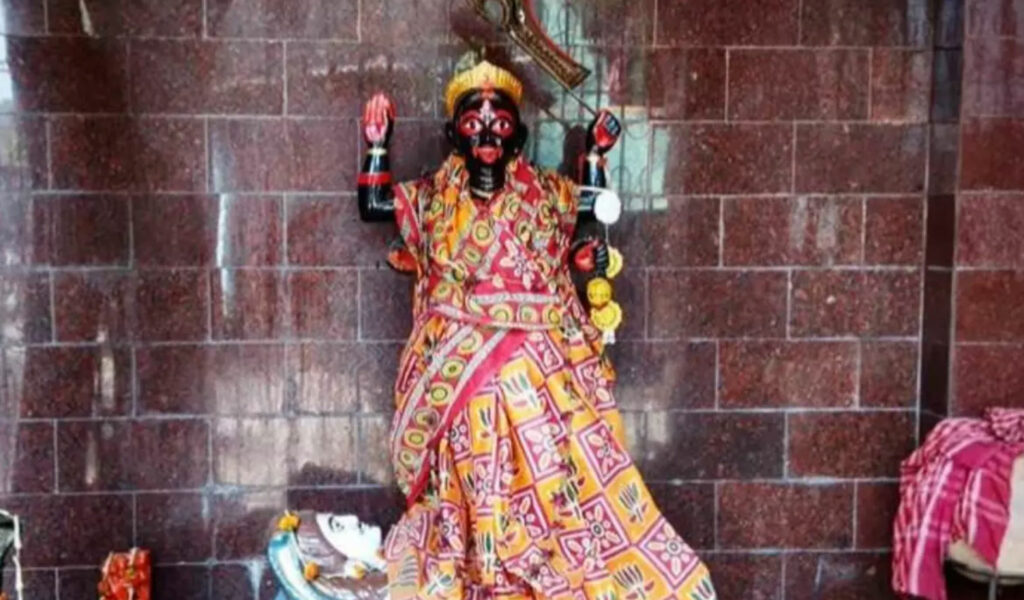
Located in Tangra, Kolkata’s Chinatown, the Chinese Kali Temple is a fascinating example of cultural fusion. Built by the local Chinese community, the temple is dedicated to Goddess Kali, but the rituals here blend Hindu and Chinese traditions.
What makes the temple unique is that offerings to the goddess often include Chinese food like noodles, rice, and chop suey, alongside traditional Indian prasad. The walls are decorated with both Hindu imagery and Chinese symbols, reflecting the harmony of two cultures.
For visitors, the temple is a moving symbol of Kolkata’s multicultural ethos, where communities adapted and enriched each other’s traditions.
•⏰ Timings: 6:00 AM – 8:00 PM daily
•🎟️ Entry Fee: Free
•💡 Travel Tip: Visit around lunchtime when Chinese offerings are made — it’s a truly unique experience.
The Chinese Kali Temple is one of the most unusual places to see in Kolkata, blending faiths in harmony.
89. ISKCON Temple, Albert Road
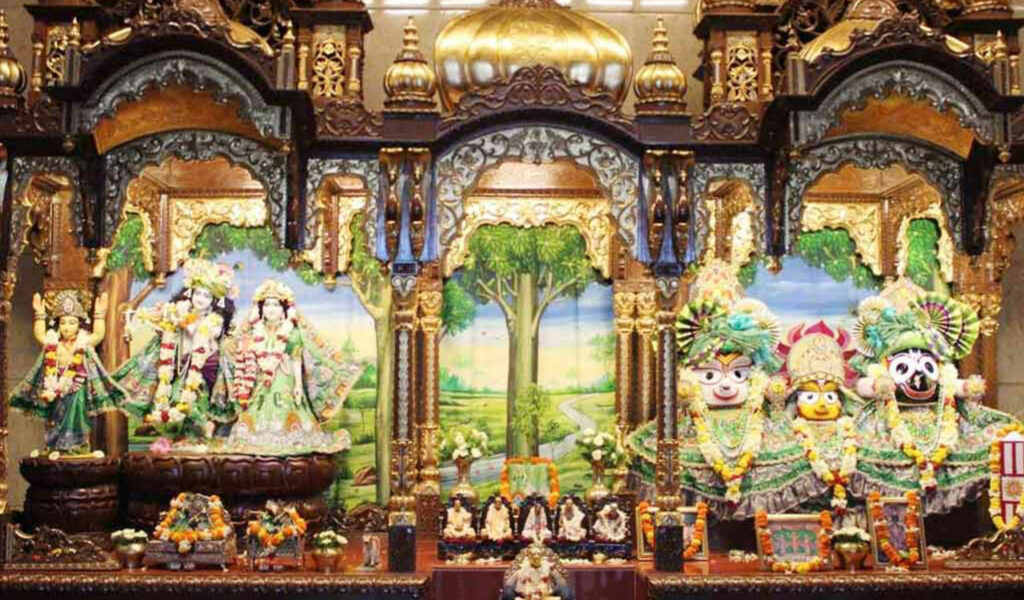
The ISKCON Temple on Albert Road is a spiritual oasis in the middle of bustling central Kolkata. Dedicated to Lord Krishna, it serves as a center for the International Society for Krishna Consciousness, attracting devotees and curious visitors alike.
The temple’s marble structure, adorned with paintings of Krishna’s pastimes, houses idols of Radha-Krishna, Jagannath, Baladeva, and Subhadra. Daily rituals include chanting, aarti, and devotional singing, creating a joyful atmosphere. The temple also offers free vegetarian meals (prasadam) to visitors, staying true to ISKCON’s global philosophy of service.
Its central location makes it easy to include while exploring nearby attractions like Birla Planetarium and Victoria Memorial.
•⏰ Timings: 4:30 AM – 8:30 PM daily
•🎟️ Entry Fee: Free
•💡 Travel Tip: Attend the evening aarti (around 7:00 PM) for a lively devotional experience.
The ISKCON Temple is one of the most uplifting Kolkata tour places, where spirituality meets community service.
90. Portuguese Church (St. Thomas’ Church)
The Portuguese Church, officially known as St. Thomas’ Church, is located in central Kolkata and dates back to the late 18th century. Built by the Portuguese community, it reflects a blend of Baroque and neoclassical styles, with twin towers and a large central dome.
Inside, the church features simple yet elegant interiors, with statues of saints, an altar, and arched ceilings. Though not as grand as St. Paul’s Cathedral, it carries immense historical significance as one of the earliest Christian churches in Kolkata. The Portuguese community played a major role in the city’s trade, and this church stands as a reminder of their contributions.
•⏰ Timings: 7:00 AM – 6:00 PM daily
•🎟️ Entry Fee: Free
•💡 Travel Tip: Visit on a weekday morning for a quiet, reflective experience.
The Portuguese Church adds yet another layer to the city’s multicultural heritage, making it a notable place of interest in Kolkata.
91. Mullick Ghat Flower Market
Situated right under the iconic Howrah Bridge, the Mullick Ghat Flower Market is Asia’s largest wholesale flower bazaar and one of the most colorful places of interest in Kolkata. Established over 150 years ago, it bustles from the crack of dawn with vendors selling marigolds, roses, orchids, lotus, and exotic flowers in bulk.
The market is a sensory overload — piles of orange marigold garlands, vendors shouting prices, and buyers carrying massive bundles on their heads. It supplies flowers for temples, weddings, and festivals across the city. Even if you’re not here to buy, the vibrant energy makes it a photographer’s paradise.
•⏰ Timings: 4:00 AM – 9:00 PM daily
•🎟️ Entry Fee: Free
•💡 Travel Tip: Visit before 7 AM to see the market at its most lively. Wear shoes you don’t mind getting muddy.
Mullick Ghat Flower Market is not just a market but a living canvas of Kolkata’s cultural vibrancy.
92. Tiretta Bazaar Chinese Breakfast
For an offbeat culinary adventure, head to Tiretta Bazaar in central Kolkata, also known as Old Chinatown. Every morning, starting as early as 5 AM, Chinese families set up stalls offering traditional breakfast dishes — pork buns, momos, dumplings, fish ball soup, rice congee, and sausages.
This unique street food culture originated with the Chinese community that settled in Kolkata centuries ago. Though the community has shrunk, the breakfast tradition survives and remains a must-try for foodies.
•⏰ Timings: 5:00 AM – 8:30 AM daily
•🎟️ Entry Fee: Free (Pay for food; items ₹50–₹150)
•💡 Travel Tip: Arrive early, as most food sells out before 8 AM. Carry cash and a big appetite.
Tiretta Bazaar’s breakfast scene is one of the most authentic Kolkata tour places for those who love food with history.
93. Phuchka & Street Food Trails
No list of places to see in Kolkata is complete without its legendary street food. The undisputed king is the phuchka (pani puri), known for its tangy tamarind water, spiced potatoes, and crunchy shells. Gariahat, Vivekananda Park, and Russell Street are some of the best spots to try it.
Beyond phuchka, Kolkata street food includes kathi rolls (invented here), ghugni chaat, jhal muri, and puchkas with unique fillings. Sweet lovers can indulge in mishti doi, rosogolla, and sandesh from iconic sweet shops like KC Das and Balaram Mullick.
Organized street food walks are increasingly popular, taking visitors through hidden stalls and famous vendors while narrating the history behind each dish.
•⏰ Timings: Late afternoon to late evening is best
•🎟️ Entry Fee: Free (Pay per item ₹20–₹150)
•💡 Travel Tip: Go with locals or guides for the best, most hygienic recommendations.
Street food isn’t just eating in Kolkata — it’s a cultural ritual.
94. Park Street
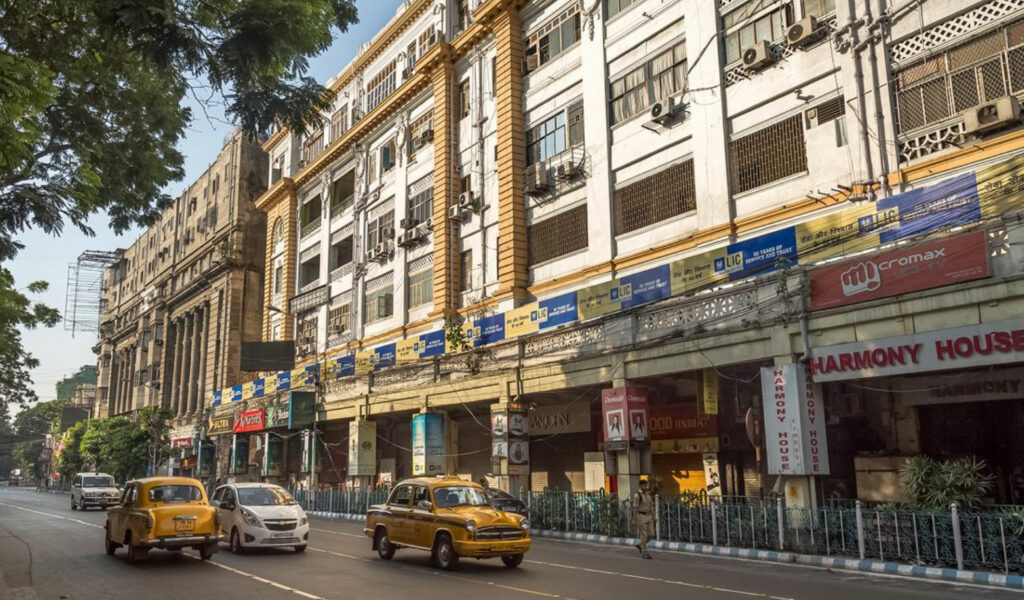
Often called the “Street That Never Sleeps”, Park Street is the entertainment hub of Kolkata. Since colonial times, it has been the city’s center for dining, nightlife, and Christmas celebrations. By day, it’s a bustling business street; by night, it transforms with glowing neon lights and music.
Iconic restaurants like Flurys, Peter Cat, and Mocambo have been serving for decades, offering everything from continental dishes to Bengali favorites. Park Street is also known for its pubs, live music venues, and festive decorations during December, when it becomes a carnival of lights and joy.
•⏰ Timings: Always open; restaurants and pubs 11:00 AM – 11:00 PM
•🎟️ Entry Fee: Free
•💡 Travel Tip: Visit during Christmas to see the street fully decorated and buzzing with energy.
Park Street is a must-visit tourist place of Calcutta, capturing the modern, cosmopolitan spirit of the city.
95. Indian Museum Street Area Adda

Around the Indian Museum and Esplanade, you’ll find some of Kolkata’s most famous street-side adda zones. Students, artists, and office-goers gather here at roadside tea stalls, debating politics, art, and cricket over endless cups of chai.
For visitors, joining an adda here gives a firsthand taste of Kolkata’s intellectual spirit. The nearby College Street and Coffee House may be better known, but the Indian Museum stretch reflects the same passion for conversation in a more spontaneous way.
•⏰ Timings: All day, but evenings are liveliest
•🎟️ Entry Fee: Free (Tea ₹10–₹20 per cup)
•💡 Travel Tip: Buy a cutting chai and strike up a conversation — Kolkatans love to chat with curious travelers.
Adda is more than small talk — it’s a way of life here, making this street culture one of the most authentic places of interest in Kolkata.
96. College Street Boipara & Kolkata Book Fair
While College Street (Boi Para) is a daily paradise for book lovers, it takes on a whole new life during the Kolkata Book Fair, usually held in January–February. This is Asia’s largest book fair and the world’s largest non-trade book fair, attracting millions of visitors every year.
Dozens of international publishers set up stalls alongside local booksellers, creating a carnival of literature. Authors hold readings, discussions, and signings, while food stalls keep the festive spirit alive. Even if you’re not buying, the energy and love for books is contagious.
•⏰ Timings: 12:00 PM – 8:00 PM (during fair days)
•🎟️ Entry Fee: Free
•💡 Travel Tip: Weekdays are less crowded than weekends. Carry a tote bag — you’ll likely buy more books than planned!
For bibliophiles, the Book Fair is one of the ultimate places to see in Kolkata.
97. Durga Puja Pandals (Citywide)

The crown jewel of Kolkata’s cultural calendar, Durga Puja transforms the city every September–October into a living museum of art, devotion, and celebration. Streets are decorated with lights, music fills the air, and neighborhoods compete to build the most creative pandals (temporary temples).
Each pandal has a unique theme — some recreate famous landmarks, others focus on social messages, and many showcase traditional artistry. The idols of Goddess Durga are equally spectacular, with intricate details and artistic innovations.
Visiting pandals at night is the highlight, as the city glows with lights and endless streams of devotees. From Kumartuli’s idol-making to the final immersion at Kumartuli or Babughat, the festival is a journey in itself.
•⏰ Timings: 24 hours during Puja days
•🎟️ Entry Fee: Free
•💡 Travel Tip: Hire a car or join a guided “pandal-hopping” tour. Wear comfortable shoes and prepare for massive crowds.
Durga Puja is more than a festival — it’s Kolkata’s soul on display.
98. Christmas at Bow Barracks
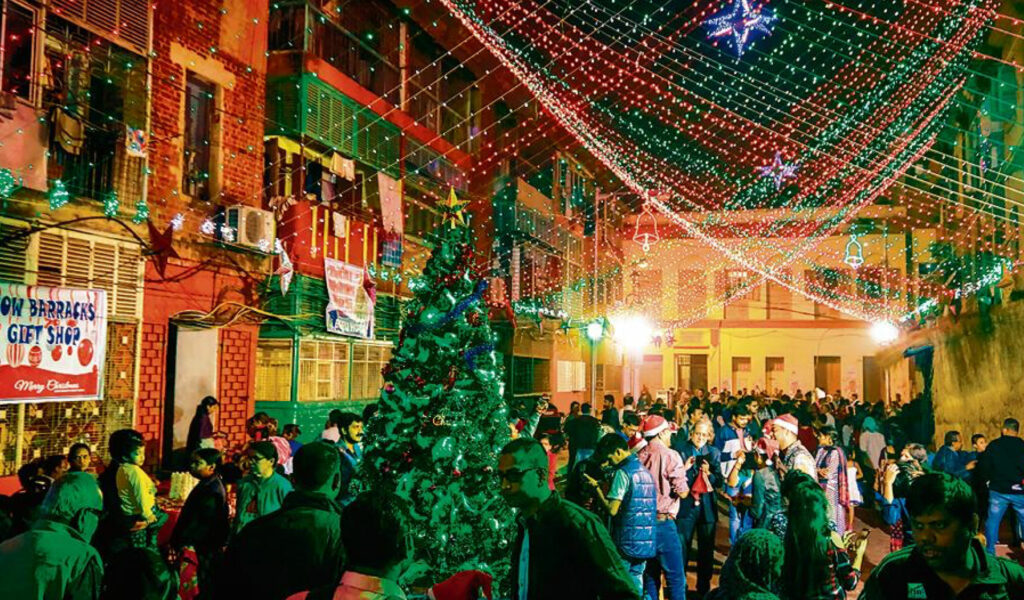
In December, Bow Barracks, a small Anglo-Indian neighborhood near Bowbazar, becomes the heart of Kolkata’s Christmas celebrations. Fairy lights, decorated houses, carols, and cakes fill the narrow lanes, creating a magical festive atmosphere.
Families open their doors, bakeries sell traditional plum cakes, and music echoes through the night. It’s a community-driven celebration, but visitors are welcome to join the fun. The red-brick buildings, a remnant of British-era housing, add a nostalgic charm.
•⏰ Timings: December (especially Christmas Eve & Day)
•🎟️ Entry Fee: Free
•💡 Travel Tip: Visit on Christmas Eve for carols and live music. Don’t miss homemade cakes sold by local families.
Bow Barracks is one of the most heartwarming tourist places of Calcutta, showcasing Kolkata’s multicultural spirit.
99. Ganga Sagar Mela
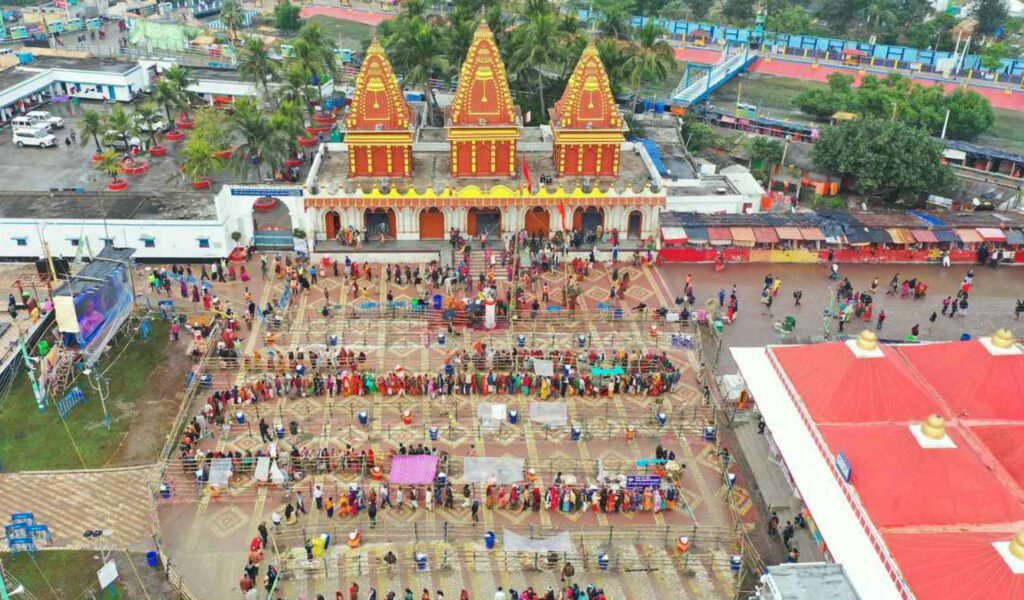
Held every January on Sagar Island, about 100 km from Kolkata, the Ganga Sagar Mela is one of the largest religious gatherings in India. Pilgrims from across the country come here to bathe at the confluence of the Ganga and the Bay of Bengal, believed to cleanse sins and grant blessings.
The mela combines spirituality with cultural vibrancy — devotional songs, campfires, and the sight of thousands taking a dip at sunrise is unforgettable. Reaching Sagar Island involves a combination of road and ferry travel, making it an adventurous excursion.
•⏰ Timings: Mid-January (Makar Sankranti)
•🎟️ Entry Fee: Free
•💡 Travel Tip: Best to visit with a guided tour for smooth logistics. Carry essentials, as the mela area gets very crowded.
The Ganga Sagar Mela is one of the most powerful places of interest near Kolkata, blending faith and tradition.
100. Sundarbans Day Trip
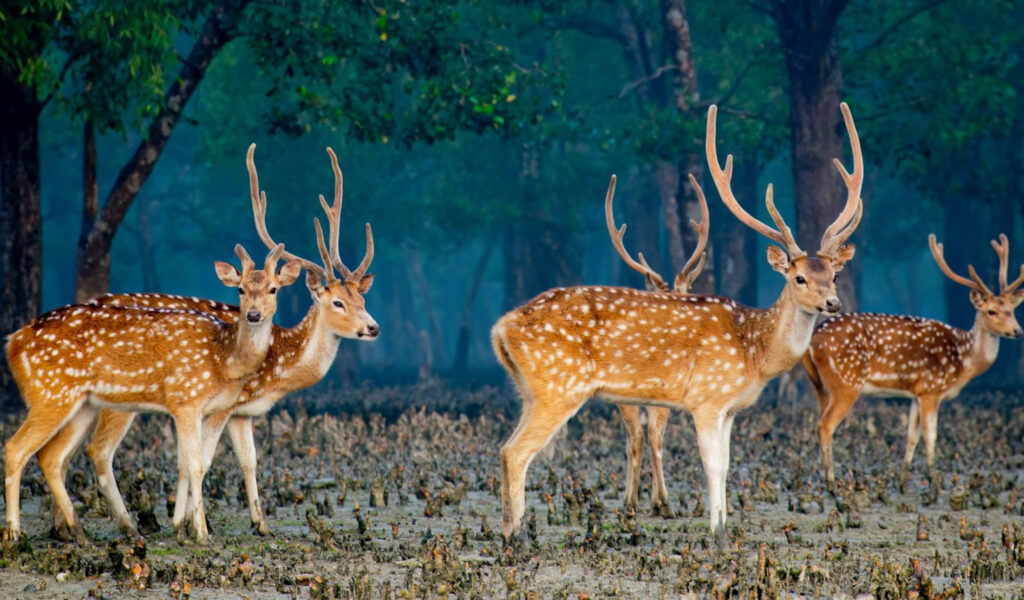
For nature lovers, a trip to the Sundarbans, the world’s largest mangrove forest and a UNESCO World Heritage Site, is a must. Located about 110 km from Kolkata, it is home to the famous Royal Bengal Tiger, saltwater crocodiles, and countless bird species.
Day trips from Kolkata usually include boat safaris through narrow creeks, where you can spot kingfishers, herons, and sometimes dolphins. The vast mangrove landscape, with its tidal rivers and dense forests, feels otherworldly.
Though a single day is not enough to explore fully, even a short trip provides a taste of its wilderness and biodiversity. For a deeper experience, multi-day tours with village stays and extended safaris are available.
•⏰ Timings: Day trips start early morning, return by evening
•🎟️ Entry Fee: Tour packages from ₹2,000–₹3,500 per person (includes permits & boat ride)
•💡 Travel Tip: Best season is winter (Nov–Feb). Carry binoculars for birdwatching.
The Sundarbans is one of the most spectacular places to see near Kolkata, where nature reigns supreme.
Conclusion
Kolkata is not just a city; it’s an experience that unfolds with every street corner, temple bell, steaming cup of chai, and artistic festival. Whether you’re tracing colonial history, savoring street food, shopping for books, or joining a Durga Puja crowd, Kolkata promises something unforgettable at every turn. This list of 100 best places to see in Kolkata will ensure your trip captures the essence of the city in all its vibrant layers.
Recommended Kolkata Tour


